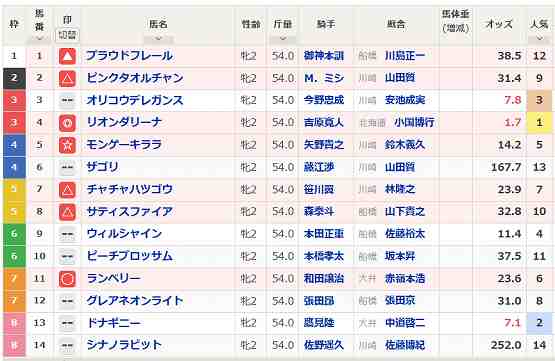駅訪問記 0
[鉄道日記] カテゴリの記事
全1051件 (1051件中 151-200件目)
-
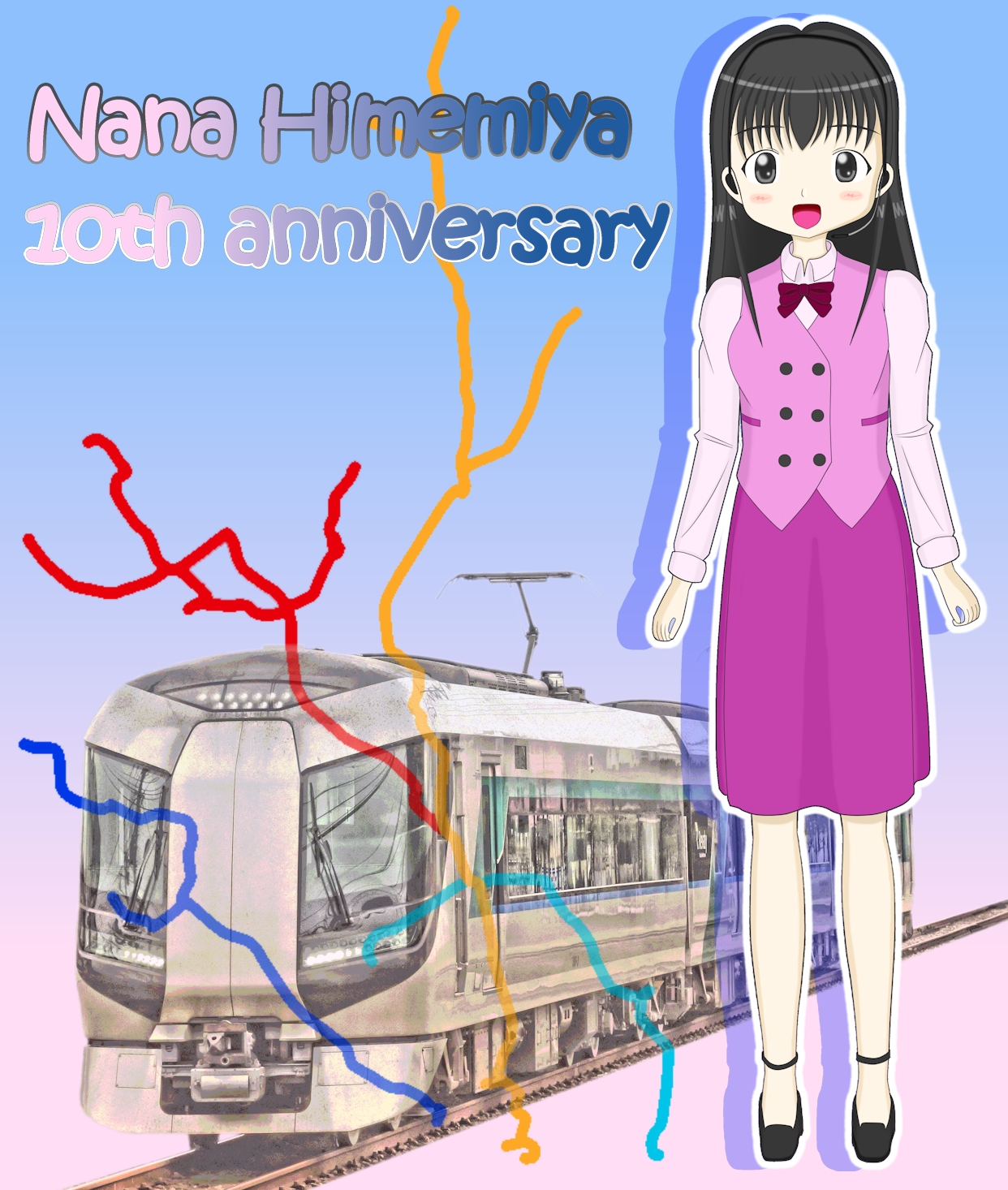
姫宮ななちゃんデビュー10周年
7月1日、東武鉄道お客様センターのマスコットキャラクター、姫宮ななちゃんがデビュー10周年を迎えた。10周年を記念して、僕はイラストを描いてお祝いする。このイラストでは、ななちゃんのイメージカラーであるピンク色と東武鉄道のコーポレートカラーである青色のグラデーションを背景に、東武鉄道の様々な路線で運行している500系電車「Revaty」と、関東地方に広がる東武鉄道の路線図を組み合わせて、今後もななちゃんが東武鉄道の様々な場面で活躍してほしいという願いを込めた。ここでななちゃんのデビューからの10年間を振り返ってみよう。まずはプロフィールをおさらい。東武鉄道お客様センターのコミュニケーター。栃木県宇都宮市出身の23歳。誕生日は3月25日。いつも笑顔で親切・丁寧・的確な案内に定評がある。趣味は実益もかねて東武鉄道沿線旅行・見学。「姫宮なな」という名前は、伊勢崎線(東武スカイツリーライン)の姫宮駅と野田線(東武アーバンパークライン)の七里駅および七光台駅から名付けられた。イラストは宙花こより先生が担当している。ななちゃんが初登場したのは、2008(平成20)年6月のこと。それまで部門ごとに異なっていた東武鉄道お客様センターの電話番号が同年7月1日に1つにまとめられることを告知する車内中づりポスター・駅ポスターに描かれたのが始まりだった。そして現行の電話番号による運用に切り替わった7月1日付けで、正式に東武鉄道お客様センターのマスコットキャラクターとしてデビューした。2008(平成20)年当時の中づりポスター train poster in 2008デビュー直後から「ITMedia」などのWebサイトで紹介されるやいなや、清楚でかわいらしいと、多くのファンを獲得した。デビュー以来、東武鉄道の車内中づりポスター・駅ポスターに留まらず、車両のLCD画面(50070系電車・60000系電車・70000系電車のほか、東武鉄道の路線へ直通運転する東京メトロ・東京急行電鉄の車両にも)の車内マナー向上告知(携帯電話・スマートフォンのマナーモード設定告知など一部を除く)にもななちゃんのイラストが使われるようになり、ブログ(2008(平成20)年から2009(平成21)年頃まで)やFacebook(2014(平成26)年より)で東武鉄道の取り組みやイベントの告知をするようにもなった。2016(平成28)年以降は「東武ファンフェスタ」などのイベントにも、ななちゃんの着ぐるみが顔を出すようになり、ファンと直接触れ合えるようになった。東武70000系電車のLCDに表示されたななちゃん Nana's illustration on LCD in Tobu 70000 Seriesななちゃんは東武鉄道が自社で制作したキャラクターであり、鉄道模型メーカーのトミーテック(TOMIX)が鉄道事業者の協力の下で制作した「鉄道むすめ」ではないが、鉄道事業者の自社キャラクターとしては初めて「鉄道むすめ」にゲスト参加、フィギュアなどのキャラクターグッズも制作・販売された。2013(平成25)年以降、「鉄道むすめ」関連のイベントなどでは鉄道好きアイドルである伊藤桃さんがななちゃん役として登場している。2015(平成27)年には、東武鉄道の協力の下で制作された「鉄道むすめ」のキャラクターたちと共に634系電車「SKYTREE TRAIN」の車内を彩った。続いて僕がななちゃんへの思い入れについて書き表したい。僕はデビュー以来のななちゃんファンである。僕とななちゃんとの出会いは、東上線の列車の車内に掲示された中づりポスターだった。あまりのかわいらしさに一目惚れしてしまった。当時僕は高坂駅が最寄りの大学の学生だった。東上線を通学に利用していなかったら、ななちゃんを知るタイミングがもう少し遅くなっていたかもしれない。これまで東武鉄道の列車に乗る時はいつも、ななちゃんが描かれたポスターが車内や駅の掲示板にないかチェックしている。そして、634系「SKYTREE TRAIN」でななちゃんの等身大イラストを間近に見られた時は感動した。しかしななちゃん(着ぐるみ)が出演するイベントには、残念ながらこれまで一度も行けていない。ぜひとも一度、ななちゃんを間近に見てみたい、ななちゃんと直接触れ合ったみたい。ななちゃんはこの10年間でお客様センターのみに限らず、東武鉄道全体のマスコットキャラクターへと成長したように見える。改めて今後も、ななちゃんが東武鉄道の様々な場面で活躍することを願う。そして、僕もななちゃんを応援し続けていきたい。On July 1st, the mascot character of Tobu Railway, Nana Himemiya, marked the 10th anniversary of her debut.To celebrate the anniversary, I represent a picture of her with Tobu 500 Series "Revaty", which serves on many lines of Tobu Railway, and the network of Tobu Railway Lines, against the colour gradation of the pink, the colour of her cloth, and the blue, colour symbolism for Tobu Railway, for my wish to her to appear on more situations.This blog starts to review the 10 years from her debut. First is her profile.She is 23 years old, born in Utsunomiya City, Tochigi Prefecture, and works for Tobu Railway as a call-centre agent. When she responding to a telephone inquiry, she talks in kindly and polite way. She was named after three stations on Tobu Railway, Himemiya Station on Isesaki Line (Tobu SKYTREE Line), Nanasato Station, and Nanakodai Station on Noda Line (Tobu Urban Park Line). She is officially represented by a Japanese illustrator, Koyori Sorahana.She first appeared on an advertisement in trains or stations to inform the new telephone number of call centre, whose number used to have three different those for callers' purpose. When the call centre started to be operated with the present number, she officially started to symbolise the call centre.Soon after her debut, she was covered by some online news, such as "ITMedia", people wrote appreciations of her that she looks cute and gentle-natured.Since her debut, she has appeared not only posters, but also information for polite on-board behavior (except some of them such as that for turning the mobile phones or smart phones off) on LCD devices in the cars (including those belonging to the other companies, such as Tokyo Metro's 10000 Series and Tokyu Corporation's 5050-4000 Series, as well as Tobu Railway's 50070 Series, 60000 Series, and 70000 Series) above the doors. She also informs events or posters of Tobu's on her blog (from 2008 to 2009) or Facebook (from 2014). Since 2016, she (living doll) started to appear on some events such as "Tobu Fan Festa" being held at Minami-kurihashi Rail Yard.Though she is created by Tobu Railway itself and different from "Tetsudou-musume" characters, being done by a model train maker, TOMYTEC (TOMIX) collaborated with the railway companies in Japan, it was first time that the character goods, such as the figure, featuring the character who is originally created by the railway company has been made and sold from the brand. From 2013, Momo Ito, who is known as a railfan, performs as Nana at events relating to "Tetsudou-musume". In 2015, she was decorated the interior of 634 Series "SKYTREE TRAIN" as well as "Tetsudou-musume" characters collaborated with Tobu Railway.Next, I would like to write my personal feeling for her.It was when I was at university, which is located near Takasaka Station on Tobu Tojo Line, that I first saw her on the first ad in Tojo Line train. Because of her cute looks, I fell in love with her at first sight. If I had been in the other university, my encounter with her might have been later than that.Every time I travelled with Tobu Line trains, I check whether a poster featuring her is displayed or not in the trains or the stations. When travelling with "SKYTREE TRAIN" to see the life-size picture of her, I was really moved. However, I couldn't meet her (live doll) at an event. So I really want to go to the event to see her.I see that she has grown up to mascot of whole of Tobu Railway. I would like to keep loving and cheering for her.
Jul 1, 2018
コメント(0)
-

西武10000系×「ラブライブ! サンシャイン!!」再び
6月9日、西武池袋線・狭山線池袋駅~西武球場前駅間をを運行する臨時特急列車を撮影。この列車は事前申し込みのツアー客専用の列車で、6月9日・10日の両日、声優ユニット「Aqours」のライブが西武ドームで開催されたことに伴うもので、同ユニットのメンバー9人が主題歌・挿入歌とメインキャラクターの声を務めるアニメ「ラブライブ! サンシャイン!!」のラッピングを纏った10000系10102Fで運行された。西武球場前行きのツアー客専用列車は、6月8日~10日の3日間運行された。なお今回と同じ列車は、前回Aqoursのライブが西武ドームで開催された昨年2017(平成29)年9月29日・30日にも運行された(昨年の車両は10109F)。8日は池袋駅~西武球場前駅間を1往復、9日・10日は下り西武球場前行きのみ3本が運行された。練馬駅通過線に停車中の10102F。1本目の運行の後、池袋駅へと折り返す回送列車。3番線(池袋行き列車ホーム)に停車していた各停列車が先に発車するのを待っていたことから、普段通過線を高速で走り抜ける10000系が停車する珍しい姿をとらえることができた。練馬高野台駅を通過する10102F。2本目の西武球場前行き列車をとらえた。ラッピング車両は6月24日まで、西武池袋線・西武秩父線の特急レッドアロー「ちちぶ」「むさし」として運行される予定。On June 9th, I photographed a special train for tourists between Ikebukuro Station on Seibu Ikebukuro Line and Seibukyujo-mae [Seibu Dome] Station on Seibu Sayama Line.The train was served by 10000 Series 10102F set, having livery of "Love Live! Sunshine!!" anime, from June 8th to 10th and planned for persons watching the live performance of nine-member voice actress group "Aqours", who sing music and each member of the group voices each nine main characters on the work held at Seibu Dome on that day and June 10th. On 8th the special trains served one round trip and that day and 10th did three one-way trip from Ikebukuro.The first photograph is an out-of-service train while stopping at Nerima Station on track for passing trains, which was rare that the passing trains stop at the track to wait for the other one departing from the platform.The second one is second service at Nerima-takanodai Station.10102F set has been in regular "Chichibu" or "Musashi" limited express train service on Seibu Ikebukuro Line and Seibu-chichibu Line with the livery until June 24th.
Jun 9, 2018
コメント(0)
-
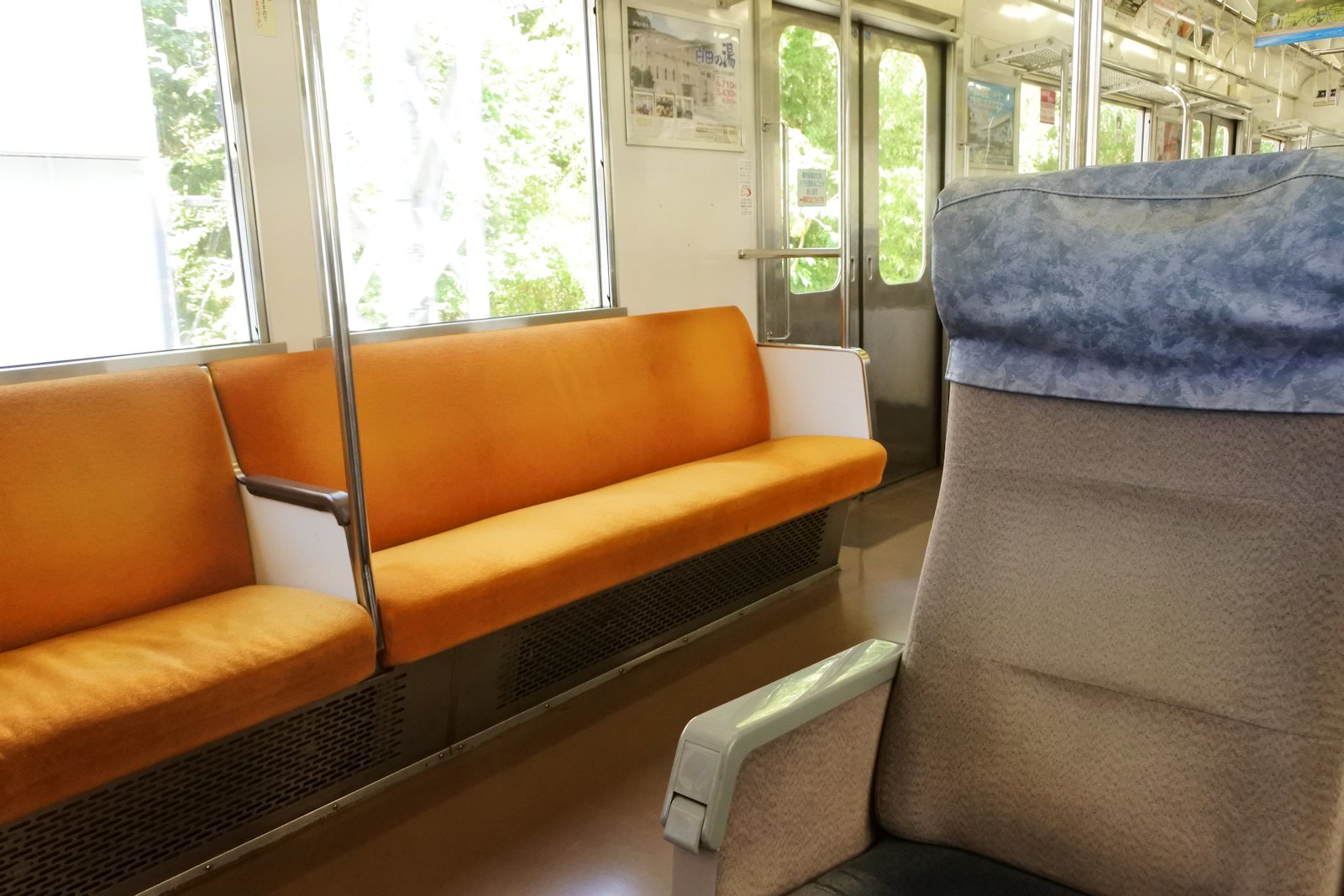
伊豆急行8000系の座席を見つめて
伊豆急行8000系電車車内のロングシートとクロスシートを1枚撮影。伊豆急行8000系電車は、1969(昭和44)年から2008(平成20)年にかけて東急東横線・大井町線で活躍した東急8000系電車を改造した車両である。伊豆急行へは2004(平成16)年から2008(平成20)年の間に譲渡された。座席は山側はロングシート、海側はボックスシートという組み合わせのセミクロスシート。東急時代は全席ロングシートであり、海側を4人が2人ずつ向かい合って座るボックスシートに改造された。2100系「リゾート21」には及ばないものの、海側の眺望が確保されている。山側のロングシートは東急時代のものがそのまま使われ続けている一方で、海側の座席は西武10000系電車で使われていたものを再利用している。特急型車両の座席だったため、もともとは回転と背もたれのリクライニングができたが、現在は回転もリクライニングもしない。東急電鉄と西武鉄道といえば、1950年代から1960年代にかけて、神奈川県・箱根の観光開発競争(いわゆる「箱根山戦争」)で熾烈なライバル関係にあったことで知られているが、伊豆急行線の建設においても両社は対立を起こした。現在の伊豆急行線にあたる静岡県伊東市~下田市間の鉄道路線建設計画は、省線伊東線(現在のJR東日本伊東線)と共に熱海駅~下田市を結ぶ路線として当時の鉄道省が建設にあたる計画だったが、緊縮財政の発動により、現在の伊東線にあたる熱海駅~伊東駅間のみが1935(昭和10)年から1938(昭和13)年にかけて開業した。未成線のままであった伊東駅以南の建設に名乗り出たのが東急電鉄だった。1953(昭和28)年より伊豆半島東海岸の観光開発構想を進めていた同社は、鉄道とバスによる伊豆半島へのアクセスの向上を狙っていた。もともと鉄道省(→1949(昭和24)年より日本国有鉄道)が計画していた路線であることから、伊豆急行線の建設にあたっては、伊東線への直通運転を前提にすること、建設費を全額負担することなどが条件に挙げられた。ところが伊豆箱根鉄道駿豆線がすでに営業していることを理由に、伊豆箱根鉄道とその親会社である西武鉄道が東急電鉄の伊豆進出に対抗して、既存の駿豆線を含めた東急案と競合する計画を策定した。しかし伊豆箱根鉄道案は東急案に対抗して急遽作られたものであったため、不備が多いことが指摘されたため通らず、1956(昭和31)年に東急電鉄に伊豆急行線の建設免許が交付された。8000系の故郷である東急東横線と、クロスシートの故郷である西武池袋線が直通運転を開始したのは2013(平成25)年のことであるが、これと同様に東急8000系の内装に西武10000系の座席を組み合わせるということも、かつてはあり得なかったと言えよう。この1枚は、東急8000系の座席に西武10000系の座席を組み合わせた伊豆急行8000系の内装が、東急電鉄と西武鉄道が過去の対立を乗り越えた象徴であるように、海側・山側両方の座席を写した。This is a photograph of longitudinal and transverse seatings in Izukyu Corporation 8000 Series.Izukyu Corporation 8000 Series, originally manufactured as Tokyu Corporation 8000 Series and had served on Tokyu Toyoko Line and Oimachi Line between 1969 and 2008, was refurbished and had moved to Izu Kyuko Line between 2004 and 2008.In its interior, longitudinal seatings, which is original ones from its Tokyu period, are laid out on its mountain side and transverse fixed seatings, which is reused from Seibu 10000 Series and originally were rotatable and with reclining backrest, are on seaward side, which is aimed for passengers' view when the train running on seaside area.Tokyu Corporation and Seibu Railway are known as the competition for the development of tourism in Hakone Area in Kanagawa Prefecture between 1950s and 1960s. In addition, the two companies had competed with each other for the construction of Izu Kyuko Line.Izu Kyuko Line was first planned between Atami Station on Tokaido Main Line and Shimoda City, together with The Japanese Government Railways Ito Line (the present JR East Ito Line), and to be constructed by Ministry of Railways. However, because of austerity programme, only the section between Atami Station and Ito Station were opened in 1938. In 1953, Tokyu Corporation stepped forward to construction of shelved section further than Ito Station to aim to improve the accessibility in Izu Peninsula. Because of the original plan by the ministry (Japan National Railway from 1949), the conditions for the construction of the railway was set, the same standard of Ito Line for the going-through train service, the constructor had to pay for all the expenses, and more.Hearing the Tokyu's plan, Izu Hakone Railway, a branch company of Seibu Railway managing Sunzu Line spreading in the middle of the peninsula, made similar plan to compete Tokyu's plan. However, because of many kinks, Izu Hakone Railway's plan wasn't permitted and the Tokyu Corporation obtain the construction license.I photographed those seatings, in composition looking like the symbol of the dissolution of an adversarial relationship, together with Tokyu Toyoko Line and Seibu Ikebukuro Line started going-through service via Tokyo Metro Fukutoshin Line in 2013.
May 19, 2018
コメント(0)
-
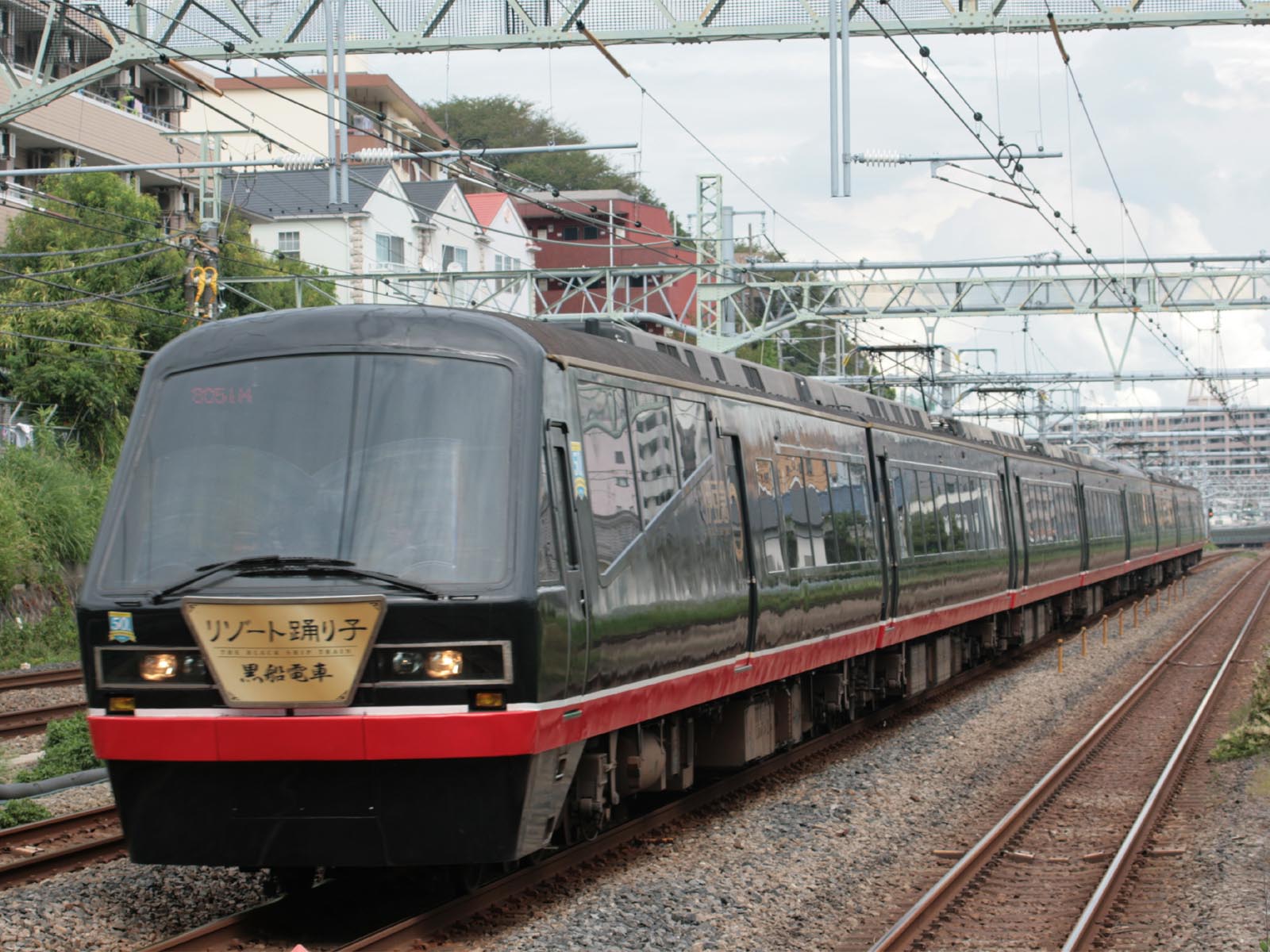
「リゾート21」の展望席から
伊豆急行2100系電車のうち、R-5編成は「THE ROYAL EXPRESS」専用車両であり、ツアーに参加しないと乗車できないが、R-3編成とR-4編成(R-1編成は2006(平成18)年、R-2編成は2009(平成21)年に廃車)は「リゾート21」の愛称を持ち、主にJR東日本伊東線熱海駅~伊豆急行線伊豆急下田駅間の普通列車として運行されている。もちろんこれらの列車には乗車券さえあれば誰でも乗車することができる。「リゾート21」の両先頭車両乗務員室寄りは階段状の展望席、中間車両の一部座席は海に向かって配置されている。1985(昭和60)年にデビューして以来、「海の見える電車」として高い人気を誇っている。Among Izukyu Corporation 2100 Series, R-5 set is specified for "THE ROYAL EXPRESS", on which tourists only can board, but R-3 set and R-4 set (R-1 set retired in 2006 and R-2 set did in 2009), commonly nicknamed "Resort 21", serves as local trains between Atami Station on JR East Ito Line and Izukyu-shimoda Station on Izukyu Corporation Izu kyuko Line, on which everyone having a regular ticket can do.The each cab car of 2100 Series equips tiered seatings behind the driver's cab and the other half of the cab car and other cars do the those facing the sea for the passengers' observation, which brought high popularity.海側向きの座席が並ぶ車両 Interior laid out seating facing sea.伊豆大川駅付近を走行中、海側向きの座席を入れて Sea and greenery over the window with the seatings.相模湾を右に見ながら走る伊豆稲取駅~片瀬白田駅間を展望座席から Sagami Bay over the driver's cab from tiered observation seatings area while running between Izu-inatori Station and Katase-shirata Station.
May 19, 2018
コメント(0)
-

初夏の「THE ROYAL EXPRESS」を撮る
5月19日、大型連休から2週間しか経たない初夏なのに真夏のような暑さだったこの日は、夏の海が似合う路線、伊豆急行線を撮影しに出かけた。狙う車両は伊豆急行2100系電車R-5編成「THE ROYAL EXPRESS」。撮影場所は今井浜海岸駅~伊豆稲取駅間。線路が相模湾に最接近する区間の1つで、入り江の対岸から海沿いを走る列車を狙う。2100系R-5編成は、1993(平成5)年に登場した。それまでの2100系R-1~R-4編成から内外装のデザインに大きな変更を施し、「リゾート21」の愛称を持つR-1~R-4編成を発展させた車両ということから、当時は「アルファリゾート21」の愛称で呼ばれた。R-1~R-4編成とともに、伊豆急行線・JR東日本伊東線の普通列車やJR東日本東海道本線東京駅~伊豆急行線伊豆急下田駅間の臨時特急列車「リゾート踊り子」として運行されていた。車体色は白色・赤色・青色の3色が交互に斜めに配置されていた(参考:「リゾート踊り子」運用に就く「アルファリゾート21」時代の2100系R-5編成)。2017(平成29)年、伊豆への新たな観光客呼び込みを目的に、伊豆急行とその親会社である東京急行電鉄による観光列車用車両「THE ROYAL EXPRESS」へと改造された。「THE ROYAL EXPRESS」の内外装デザインはJR九州の800系新幹線電車や77系客車「ななつ星in九州」など、数多くの鉄道車両、特に観光列車用の車両のデザインで知られる水戸岡鋭治さんが手掛けた。「THE ROYAL EXPRESS」はツアー客専用の観光列車で、JR東日本東海道本線横浜駅~伊豆急下田駅間などでツアー旅行が組まれている。この日は金曜日に横浜駅を出発する1泊2日プランの2日目で、伊豆急下田駅~伊東駅間を運行した。R-5編成は「アルファリゾート21」時代に何度か撮影し、2012(平成24)年に乗車もしたが、「THE ROYAL EXPRESS」となってからは、今回が初めての撮影となった。この日は雨が降ることが心配されたものの、幸いなことに晴れ、波も静か過ぎず荒れ過ぎず、ちょうどよいコンディションで撮影することができた。On May 19th, the day in hot weather though just two weeks had passed after the three holidays in a row, I went photographing on Izukyu Corporation Izu Kyuko Line to shoot 2100 Series R-5 set "THE ROYAL EXPRESS".Where I photographed was between Imaihama-kaigan Station and Izu-inatori Station, one of the railway running seaside, and I shot the train and the sea water from the opposite side of a cove.R-5 set debuted in 1993 and designed as improved version of 2100 Series R-1 - R-4 sets, commonly nicknamed "Resort 21", which brought its first nickname "Alpha Resort 21". Together with the other four sets, it used to serve as local trains on Izu Kyuko Line and JR East Ito Line and "Resort Odoriko" limited express between Tokyo Station on JR East Tokaido Main Line and Izukyu-shimoda Station on Izu Kyuko Line on specified days. It originally painted in white, red, and blue (R-5 set when serving as "Resort Odoriko" limited express before the refurbishment).In 2017, R-5 set had been refurbished, especially its interior and body livery, as "THE ROYAL EXPRESS" to draw more tourists to Izu area. "THE ROYAL EXPRESS" is produced by not only Izukyu Corporation itself, but also the parent company of Izukyu Corporation, Tokyu Corporation, and designed by Eiji Mitooka, who is also known as the designer of 800 Series Shinkansen and 77 Series "Seven Stars in Kyushu"."THE ROYAL EXPRESS" is only for the tourists and serves between Yokohama Station on JR East Tokaido Main Line and Izukyu-shimoda Station. That day was the second day of two-day tour from Yokohama and the train ran from Izukyu-shimonda Station and Ito Station. It was first time for me to photograph "THE ROYAL EXPRESS". When R-5 set served as "Alpha Resort 21", I also photographed it several times and travelled with in 2012.Though the weather forecast called for rain, it became fine that day. In addition, the sea water was in good condition, which helped me to photograph.
May 19, 2018
コメント(0)
-
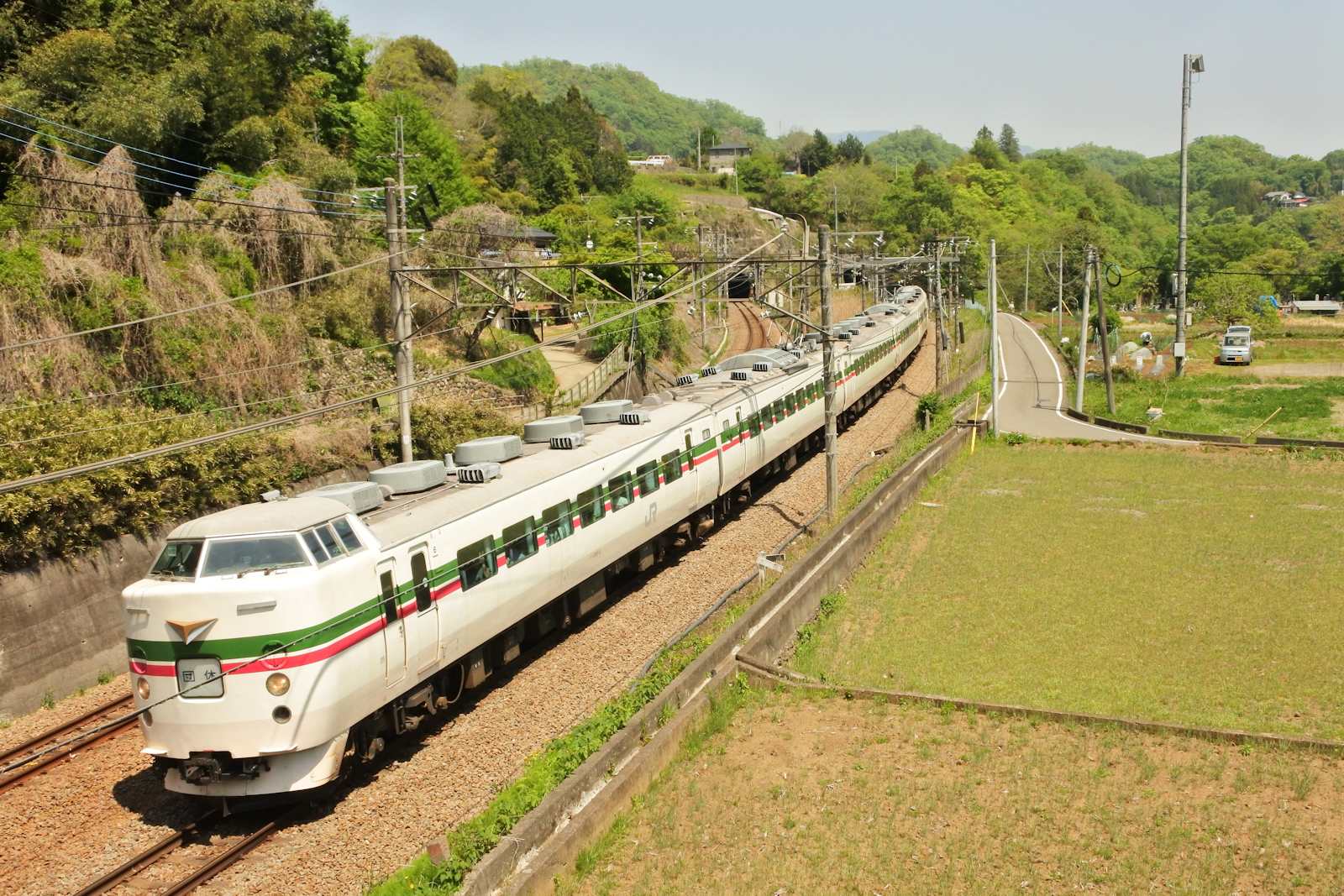
最初で最後の189系「グレードアップあずさ色」
4月22日をもってラストランを迎えた豊田車両センター所属の189系M52編成(「グレードアップあずさ色」編成)を撮影。「グレードアップあずさ色」は、中央本線(中央東線)の特急「あずさ」として運行されていた183系のうち内装をリニューアルした編成の車体に塗装されていたもので、白色(クリーム12号)と薄茶色(薄茶色13号)を基調に緑色(緑14号)と赤味の強いピンク色の帯を巻いている。JR各社は1987(昭和62)年の民営化直後から、国鉄から大量に引き継いだ車両の内装リニューアルや塗色変更に着手し、この「グレードアップあずさ色」もその時代に登場した塗色の1つで、同年12月に登場した。当時の時刻表では「デラックス車両」と表記され、非リニューアル車とは運用が区別された。その後白地にライトブルー色の新しい「あずさ色」に塗り替えられたことで一旦姿を消したものの、2014(平成26)年に豊田車両センターに所属している189系トタM52編成で「グレードアップあずさ色」が復活した。ラストランは豊田駅から豊田車両センター内を走り、再び豊田駅に戻り、中央本線(中央東線)を甲府駅まで行き、折り返して豊田駅へと戻るルートで運行された。僕がカメラを構えた場所は上野原駅~四方津駅間。甲州の山里を走る姿を立体交差する道路上から俯瞰するアングルで撮影した。架線柱同士を渡すケーブルが車体に引っ掛かったものの、芽吹き始めた山や畑の美しい緑の中を走る列車が撮影できた。撮影はこれ一度きりになってしまったが、M52編成にはありがとうと言いたい。On April 22nd, I went photographing 189 Series M52 set, which was called "Grade-up Azusa", coloured in white, light brown, green, and reddish pink and served its last special service on that day, on Chuo Main Line (Chuo East Line).On December, 1987, 183 Series on Chuo Main Line which served as "Azusa" limited express changed in their body colour to "Grade-up Azusa" livery. "Grade-up Azusa" livery sets used to serve as specified operation, which used to be specified in timetable book on that time.In later years, "Grade-up Azusa" livery once disappeared because of the repaint of the body to new "Azusa" colour in white and light blue. However, in 2014, 189 Series M52 set belonging to Toyoda Rail Yard had been repainted to the livery.The last service of M52 set operated as round-trip special trains for tourists between Toyoda Station and Kofu Station via the rail yard.Where I photographed was a overcrossing between Uenohara Station and Shiotsu Station, looking down the greenish agricultural fields. Though cables between catenary poles interrupted, I could shoot the train running in a greenish country area.The chance I could photograph M52 set was that time only, but I said goodbye and thanks to it.
Apr 22, 2018
コメント(0)
-
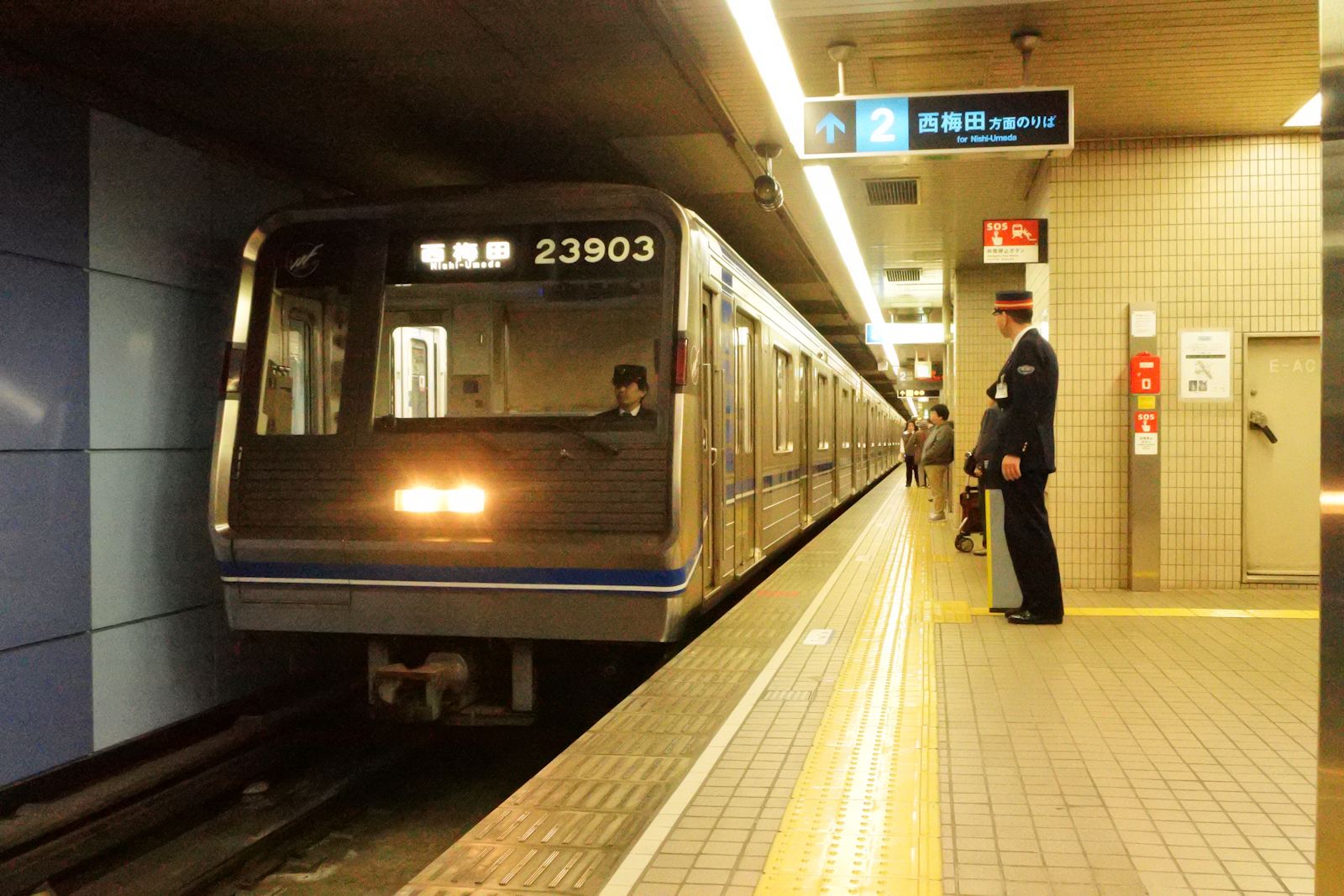
大阪市交通局全形式撮影チャレンジ
大阪撮影旅行最終日のメインイベントは、大阪市交通局(大阪市高速電気軌道(Osaka Metro))に在籍するすべての車両形式を撮影すること。御堂筋線の10系、21系、30000系は撮影済みであるため、残る路線を走る車両たちを一気に撮影した。On the last day in Osaka, I tried to photograph all car types on Osaka Municipal Subway and Newtram (Osaka Metro) except three types, 10 Series, 21 Series, and 30000 Series, on Midosuji Line photographed on second day, March 28th.四つ橋線 23系電車 Yotsubashi Line 23 Series「新20系」と総称される21系・22系・23系・24系・25系のうち、最初に登場したのが1990(平成2)年にデビューした谷町線の22系と四つ橋線の23系だった。四つ橋線はすべての列車が23系で運行されているため、撮影しやすい車両といえる。住之江公園駅にて。Among the five car series collectively called "New 20 Series", 21 Series, 22 Series, 23 Series, 24 Series, and 25 Series, 23 Series on Yotsubashi Line had debuted as early as 22 Series on Tanimachi Line in 1990.Because all trains on Yotsubashi Line are served by 23 Series, it can be easily-photographed.Photographed at Suminoe-koen [Suminoe Park] Station.南港ポートタウン線 100A系電車 Nanko Port Town Line ("New Tram") 100A Series南港ポートタウン線(ニュートラム)は100A系から200系への世代交代の最中にある。100A系は200系と交代で数を減らしていて、2018(平成30)年度末までに姿を消す予定である。写真の101-32Fは、2018(平成30)年5月22日付けで廃車となった。ポートタウン東駅にて。Sets of 100A Series on AGT Nanko Port Town Line ("New Tram") are being replaced by 200 Series and all sets are being retired by March, 2019. 101-32F set in the photograph was retired on May 22nd, 2018.Photographed at Port Town-higashi [Port Town East] Station.南港ポートタウン線 200系電車 Nanko Port Town Line ("New Tram") 200 Series南港ポートタウン線(ニュートラム)の200系は、「遊び回る子ども」をイメージしたかわいらしい前面デザインと、編成ごとに異なる車体塗色(ブルー・イエロー・ピンク・グリーン・オレンジ・パープル・レッド・ゴールド)が特徴の新型車両。写真はオレンジ色の201-09F。トレードセンター前駅にて。The latest model on Nanko Port Town Line ("New Tram"), 200 Series, has a unique design inspired by children making merry in a park and eight different colours, blue, yellow, pink, green, orange, purple, red, and gold. The one in the photograph is orange-coloured 201-09F.Photographed at Trade Center-mae [Asia & Pacific Trade Center] Station.中央線 24系電車24系は5編成と、「新20系」のなかでは在籍数が最も少ないことから撮れないことも想定していたが、この日は少なくとも3編成の稼働を確認した。九条駅にて。Because 24 Series on Chuo Line exists only five sets, the least number among "New 20 Series", I saw that at least three sets were in service.Photographed at Kujo Station.中央線 20系電車大阪市交通局初の、日本の鉄道車両としても熊本市交通局8200形電車に次いで2番目のVVVF制御を採用した車両。2018(平成30)年現在は全編成が中央線に在籍。九条駅にて。20 Series is not only the first variable-frequency drive car among Osaka Municipal Subway, but also second in Japan, following Kumamoto City Transportation Bureau 8200 Series. All sets are belonging to Chuo Line in 2018.Photographed at Kujo Station.千日前線 25系電車 Sennichimae Line 25 Series全列車が25系で運行されている千日前線は、全線地下であることに加えてすべての駅にはホームドアが設置されていることから撮影は難しいと思われたが、これを逆手に取って、ホームドアがあることが千日前線の特徴であることを表すために、駅へと入線する列車をホームドアとともに撮影。なんば駅にて。It could be difficult to photograph Sennichimae Line train because all stations are located in underground and automatic platform gate-equipped. However, I saw that those are regarded as the characteristics of Sennichimae Line and photographed 25 Series coming to the station including the gate.Photographed at Namba Station.堺筋線 66系電車 Sakaisuji Line 66 Series架線集電方式の堺筋線は、直通運転をする阪急千里線・京都本線で地上を走る姿が撮れるものの、地下鉄線内で撮りたかったため、地下駅に入線してくる姿を捕らえた。日本橋駅にて。Though Sakaisuji Line trains go through Hankyu Senri Line and Hankyu Kyoto Main Line, on or along which the train was photographed clearly, I chose that I photographed when the train coming to an underground Station.Photographed at Nipponbashi Station.長堀鶴見緑地線 70系電車 Nagahori Tsurumi-ryokuchi Line Line 70 Series日本初のリニアメトロとして開業した長堀鶴見緑地線(開業当時の路線名は鶴見緑地線だった)にも、すべての駅にホームドアが設置されているため、70系は停車中に撮影。松屋町駅にて。Because all stations on Nagahori Tsurumi-ryokuchi Line Line, the first linear metro in Japan, are also underground automatic platform gate-equipped, I photographed 70 Series while stopping at a Station.Photographed at Matsuyamachi Station.谷町線 22系電車・30000系電車 Tanimachi Line 22 Series and 30000 Series谷町線に在籍する車両の車庫である大日検車区を一望する歩道橋から1枚。From a pedestrian deck near Dainichi rail yard, 22 Series and 30000 Series on Tanimachi Line.谷町線 30000系電車 Tanimachi Line 30000 Series30000系も「新20系」各形式と同様に、最初に投入された路線は谷町線だった。大日検車場にて。30000 Series had debuted first on Tanimachi Line, as well as New 20 Series. Photographed at Dainichi Rail Yard.谷町線 22系電車 Tanimachi Line 22 Series「新20系」と総称される21系・22系・23系・24系・25系のうち、最初にデビューした車両の1つが、谷町線に投入された22系だった。在籍両数で見れば、22系が谷町線の主力車種。大日検車場にて。One of New 20 Series debuted the earliest is 22 Series on Tanimachi Line. From the point of view of the number of existing cars, 22 Series is the most popular type on Tanimachi Line.Photographed at Dainichi Rail Yard.今里筋線 80系電車 Imazatosuji Line 80 Series2006(平成18)年に開業した大阪市地下鉄最新路線の今里筋線は、長堀鶴見緑地線と同じリニアメトロである。今里筋線を走る80系も長堀鶴見緑地線の70系を基に設計された。今里筋線にもすべての駅にホームドアが設置(プラットホームゲートタイプだが、千日前線・長堀鶴見緑地線が後付けなのに対して今里筋線は開業当初から設置)されていることから、駅停車中に撮影。井高野駅にて。Imazatosuji Line, the latest-open line in 2006, is also a linear metro as well as Nagahori Tsurumi-ryokuchi Line Line and 80 Series on Imazatosuji Line is designed based on 70 Series. Because of the same reason as Nagahori Tsurumi-ryokuchi Line (as opposed to those on Sennichimae Line and Nagahori Tsurumi-ryokuchi Line installed in late year after the open, those on Imazatosuji Line are installed since its open), I photographed while stopping.Photographed at Itakano Station.
Mar 30, 2018
コメント(0)
-

泉北ニュータウン・トリヴェール和泉を走る泉北高速鉄道線
続いては泉北高速鉄道線へ。泉北高速鉄道線は中百舌鳥駅~和泉中央駅間を結ぶ路線。南海高野線から分岐して、大阪南郊の堺市・和泉市にまたがる新興住宅地である泉北ニュータウンおよびトリヴェール和泉とをつないでいる。多くの列車は高野線へ直通運転し、難波駅まで乗り換えなしで行くことができる。和泉中央駅付近の線路を跨ぐ橋の上から、泉北ニュータウン・トリヴェール和泉の街並みと共に、泉北高速鉄道線の列車を撮影した。Following Osaka Monorail Line, I went photographing on Semboku Rapid Railway, which spreads Nakamozu Station and Izumi-chuo Station, many trains going through Nankai Koya Line to consist of the route between residential area in south of Osaka City, Semboku New Town and Tri-vert Izumi, and Namba Station, southern downtown in Osaka City.I photographed the trains against the scene of the residences from an overhead bridge near Izumi-chuo Station.上から順に、南海高野線直通の準急列車として運行されている南海6000系電車、各停列車として運行されている泉北高速鉄道3000系電車、特急列車「泉北ライナー」として運行されている南海11000系電車の3車種が撮れた。The trains I photographed were a semi express by Nankai Electric Railway 6000 Series (first), a local train by Semboku Rapid Railway 3000 Series (second), and "Semboku Liner" limited express by Nankai 11000 Series (third).もちろんここでも列車に乗り、側扉のステッカーに描かれた“泉北高速鉄道・南海電車のお嬢ちゃん”にも会うことができた。以下、地下鉄のお嬢ちゃん、大阪モノレールのお嬢ちゃんと同文である。これで大阪市交通局(Osaka Metro)、大阪高速鉄道(大阪モノレール)、泉北高速鉄道3事業者のお嬢ちゃん全員の姿を見ることができた。Of course, on a Semboku Rapid Railway Line, I could see the mind-the-doors sticker with a cartoon little girl. as followsDuring the four-day travel, I could see three mind-the-doors stickers featuring cartoon girls in Osaka Area.
Mar 30, 2018
コメント(0)
-
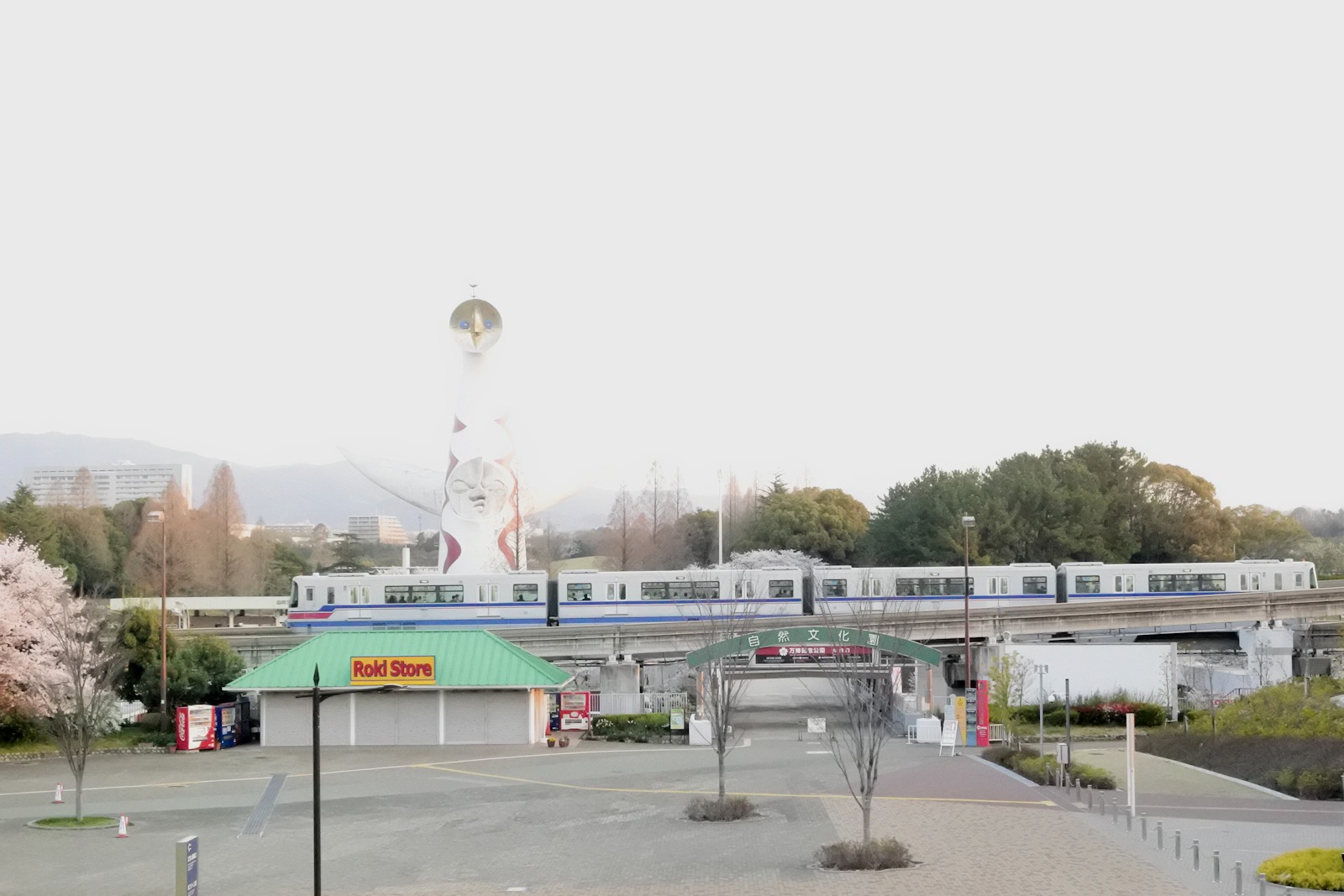
大阪高速鉄道大阪モノレール線初撮影
大阪撮影旅行も最終日を迎えた。この日最初に訪れた路線は、大阪高速鉄道大阪モノレール線。撮影場所は万博記念公園駅付近の歩道橋。万博記念公園駅の宇野辺・公園東口方に、1970(昭和45)年に開催された大阪万博のシンボルであり、先日内部が公開された太陽の塔がそびえ、塔を背景に大阪高速鉄道大阪モノレール線と国際文化公園都市モノレール線(彩都線)を走る2000系電車を撮影。大阪高速鉄道には門真市駅と大阪空港駅を結ぶ大阪モノレール線と万博記念公園駅と彩都西駅を結ぶ国際文化公園都市モノレール線(彩都線)の2路線があり、万博記念公園駅は両線の乗換駅となっている。どちらの路線を走る列車とも太陽の塔との組み合わせを撮影することができるものの、上の写真は大阪モノレール線を走る列車で、これと共に撮ろうとすると、写真向かって右の門真市方の車両が手前にある国際文化公園都市モノレール線(彩都線)の軌道に隠れてしまう。下の写真は国際文化公園都市モノレール線(彩都線)を走る列車で、これと共に狙うと列車が軌道に隠れずにきれいに撮れた。The last day of my travel in Osaka had come.The first line I photographed and travelled with is Osaka Monorail Line. Where I mainly photographed was a pedestrian deck between Bampaku-kinen-koen [EXPO '70 Commemoration Park] Station and Expo'70 Commemoration Park. I shot Osaka Monorail 2000 Series on Osaka Monorail Line and Saito Line against ”Tower of the Sun" in the park.Bampaku-kinen-koen [Expo'70 Commemoration Park] Station is the junction of two monorail lines, Osaka Monorail Line and Saito Line. Though the trains on both lines could be photographed with the tower, when photographing the train on Osaka Monorail Line like the first one, the cab of last car (when the train going toward Bampaku-kinen-koen [Expo'70 Commemoration Park] Station) was hidden by the track of Saito Line, but when photographing Saito Line train like the second one, the train was captured clearly from the first car to the last.そしてこの大阪高速鉄道の車両も、側扉のステッカーに女の子のイラストが描かれている。僕は彼女のことを個人的に、大阪市交通局(Osaka Metro)の“地下鉄のお嬢ちゃん”と同様に”大阪モノレールのお嬢ちゃん”と呼んでいる。手は赤く腫れていないものの、地下鉄のお嬢ちゃんと同様に泣き顔が痛々しく、慰めてあげたくなる。While travelling with the train, I saw the mind-the-doors sticker on the passengers' doors with a cartoon girl, as well as that of Osaka Municipal Subway (Osaka Metro). I called her "Osaka Monorail Girl" in the same way as "Osaka Subway Girl".Though her hand caught by the door pocket doesn't turn red, she also looks painful and her crying face makes me tempted to comfort her.
Mar 30, 2018
コメント(0)
-

奈良線で今なお現役 103系低運転台車
湖西線の113系電車に続いて、アーバンネットワークの国鉄型車両を。奈良線で今なお現役で活躍する103系電車を撮影。2018(平成30)年現在、奈良線で活躍する吹田総合車両所奈良支所(近ナラ)所属の4両編成は、すべての編成が3枚に仕切られた前面窓と「田」の字型の側窓が残り、内外装が大規模に変更された体質改善リニューアル車と比較して、原型に近い姿が残っている車両である。写真のナラNS407編成は、1971(昭和46)年から1973(昭和48)年にかけて製造された「1次改良車」と呼ばれるグループであるクハ103-216を奈良方先頭車、同じくクハ103-215を京都方先頭車に組み込んでいる。このグループは前照灯がそれまでの車両の白熱灯1灯からシールドビーム2灯へと変更され、前照灯周りの縁の形状も正円から横長のオーバル形に変わった。また、低運転台の103系では最後に製造されたグループとなる。103系は国鉄時代の1963(昭和38)年から1984(昭和59)年にかけての長きに渡って3447両(101系電車からの編入車およびモハ72系電車の改造車も含めると3503両)が製造され続け、山手線・大阪環状線など全国の大都市圏の各路線で活躍した。新造両数3447両は、これまでの日本の鉄道車両で最も多いものとなっている。まさに国鉄の通勤型車両、いわゆる“国電”を代表する車両であったと言えよう。国鉄時代末期からJR各社発足後にかけて、新造後30年~40年の使用を見越して、内外装のリニューアル(国鉄の特別保全工事、JR東日本の更新工事、JR東海のリフレッシュ工事、JR西日本の体質改善工事など、事業者により呼称が異なる)が施行されたが、1988(昭和63)年に山手線での運行を終了したことに始まり、JR東海管内では1999(平成11)年までに、JR東日本管内では2009(平成21)年までにすべての車両が引退した。JR西日本管内では、JR東日本・JR東海に引き継がれたものが引退していくなかでも現役を続けていた車両が多かったが、老朽化に伴う新型車両への置き換えにより、次第に数を減らしている。近年では2015(平成27)年に呉線・山陽本線などで活躍した下関総合車両所広島支所(広ヒロ)所属の車両が、2017(平成29)年10月3日に大阪環状線で活躍した吹田総合車両所森ノ宮支所(近モリ)所属の車両が、2018(平成30)年1月24日に関西本線(大和路線)・おおさか東線で活躍した吹田総合車両所奈良支所(近ナラ)所属の車両のうち6両編成が、2018(平成30)年3月16日に阪和線で活躍した吹田総合車両所日根野支所(近ヒネ)所属の車両が引退した。2018(平成30)年3月現在、103系が現役で走る姿が見られる路線は、JR西日本奈良線・山陽本線(和田岬線)・加古川線・播但線と、JR九州筑肥線に限られるまでになった。このうち、加古川線は体質改善リニューアルと貫通型先頭車化改造が施された3550番台車両(網干総合車両所明石支所加古川派出所(近カコ)所属)、和田岬線は体質改善リニューアルが施された車両(網干総合車両所明石支所(近アカ)所属)、播但線は体質改善リニューアルが施された3500番台車両(網干総合車両所本所(近ホシ)所属)、筑肥線は新造当時から前面貫通型の1500番台車両(唐津鉄道事業部唐津車両センター(本カラ)所属)が運行されていることから、原型に近い姿で残るものが見られる路線は奈良線だけとなった。2018(平成30)年時点で営業運転に就いている103系は95両(近ナラ車40両、近アカ車6両、近カコ車16両、近ホシ車18両、本カラ車15両)だけと100両を下回り、編入車・改造車を含めた総製造両数3503両と比較して、「鉄道ファン」誌上の絶滅危惧車両に対して算出されるものを参考にした残存率は2.71%となっている。JR各社の発足から30年以上の時を経て、国鉄時代の残り香は日に日に薄れていっている。僕としても、国鉄時代に全盛期を迎えた車両たちを、今のうちにできるだけ多く写真に残しておきたい。Following 113 Series at Kyoto Staiton, I photographed 103 Series on Nara Line.In 2018, all sets of 103 Series on Nara Line are the ones remaining the original design of front window, side windows, and head light sets, etc.. The two cab cars of the set in this photograph, NS407 set, are the ones of the model manufactured between 1971 and 1973, the last-made group of the low cab cars, which have two head lights at the middle of the front above the window in a oval-edged plate.103 Series had totally made 3503 cars including renumbering of 101 Series and conversion of Moha 72 Series, as well as purely-made 3447 ones, which is the largest number of railway vehicles in Japan, between 1963 and 1984 and used to be in service as commuter trains in the urban area, such as on Yamanote Line and Osaka Loop Line, in the Japan National Railway (JNR) period, which had become the symbol of commuter train of JNR ("Kokuden").In 1980s and 1990s, between the end of the JNR period and the first 10 years of privatized JR companies, many of 103 Series cars are refurbished for extension of their life to be used approximately 30 or 40 years after the manufacturing of each car. However, those in JR Central area completely retired by 1999 and JR East area by 2009. In JR West area, mainly those extensively-refurbished had kept being in service in Osaka, Okayama, and Hiroshima region, but, because of the replacement by the newly-built models, they are gradually retired. In recent years, those on Kure Line or Sanyo Main Line had done in 2015, those on Osaka Loop Line in 2017, those on Kansai Main Line (Yamatoji Line) on January, 2018, and those on Hanwa Line on March, 2018.After March, 2018, the lines 103 Series in service are JR West Nara Line, Sanyo Main Line (Wada-misaki Line), Kakogawa Line, and Bantan Line, and JR Kyushu Chikuhi Line only. Among them, those on Kakogawa Line are extensively-refurbished and added driver's cab with emergency exit on its centre, those on Sanyo Main Line (Wada-misaki Line) and Bantan Line are exclusively-refurbished, and those on Chikuhi Line has emergency exit on the centre of its front since their manufacture. Those on Nara Line are only ones which remain the original design.The number of existing cars in 2018 (serving regular operation only) is 95 (40 on Nara Line, 6 on Sanyo Main Line (Wada-misaki Line), 16 on Kakogawa Line, 18 on Bantan Line, and 15 on Chikuhi Line).Having passed over 30 years since the establishment of JR companies, the legacies of the days of JNR is gradually being disappeared, so I would like to photograph more cars which had been manufactured in the JNR period and still be in service.RM MODELS (アールエムモデルス) 2018年 07月号 [雑誌]価格:1080円(税込、送料無料) (2018/5/23時点)
Mar 29, 2018
コメント(0)
-

113系に久しぶりの乗車
山科駅から再びJR線に乗る。やってきたのはJR西日本湖西線の普通列車京都行き、車両は吹田総合車両所京都支所(近キト)所属の113系電車だった。体質改善リニューアルを受けていない車両であったため、セミクロスシートが残っていた。113系は、僕にとっては神奈川県・藤沢に住んでいた子供の頃に同車で運行されていたJR東日本東海道本線の列車に何度も乗った、思い出深い車両である。京都駅までの1区間という短い時間だったが、このセミクロスシートに座っていると、子供の頃の思い出がよみがえった。京都駅に到着後、僕はすぐさま隣のホームへと移動し、停車中の113系を撮影した。地域色である緑色へと車体塗装は変わったものの、懐かしい姿の面影がある。ちなみに僕が113系に乗るのは、2008(平成20)年にJR西日本山陰本線の普通・快速列車で乗って以来10年ぶり、撮影するのは2009(平成21)年にJR東日本内房線・外房線・総武本線でのこと以来9年ぶり(リニア・鉄道館の展示車両を除く)である。From Yamashina Station, I restarted travelling on JR West Lines.The train coming to me was a local train bound for Kyoto Station from Kosei Line operated by 113 Series. It was non-refurbished one and its interior equipped mix of transverse and longitudinal seatings.113 Series had been memorable train for me because when I had been little and lived in Fujisawa City, Kanagawa Prefecture, travelled with those on JR East Tokaido Main Line. While travelling, sitting on its transverse seatings reminded me the memories in my childhood.As arriving at Kyoto Station, I moved to the neighbour platform and photograph it stopping. Though its body colour changed to the green, it still has a classical design in the old time.10 years had past since the last time I travelled with 113 Series on JR West Sanin Main Line, and had done 9 years since last time I photographed on JR East Uchibo Line, Sotobo Line, and Sobu Main Line (except the exhibited car in SCMAGLEV and Railway Park).
Mar 29, 2018
コメント(0)
-
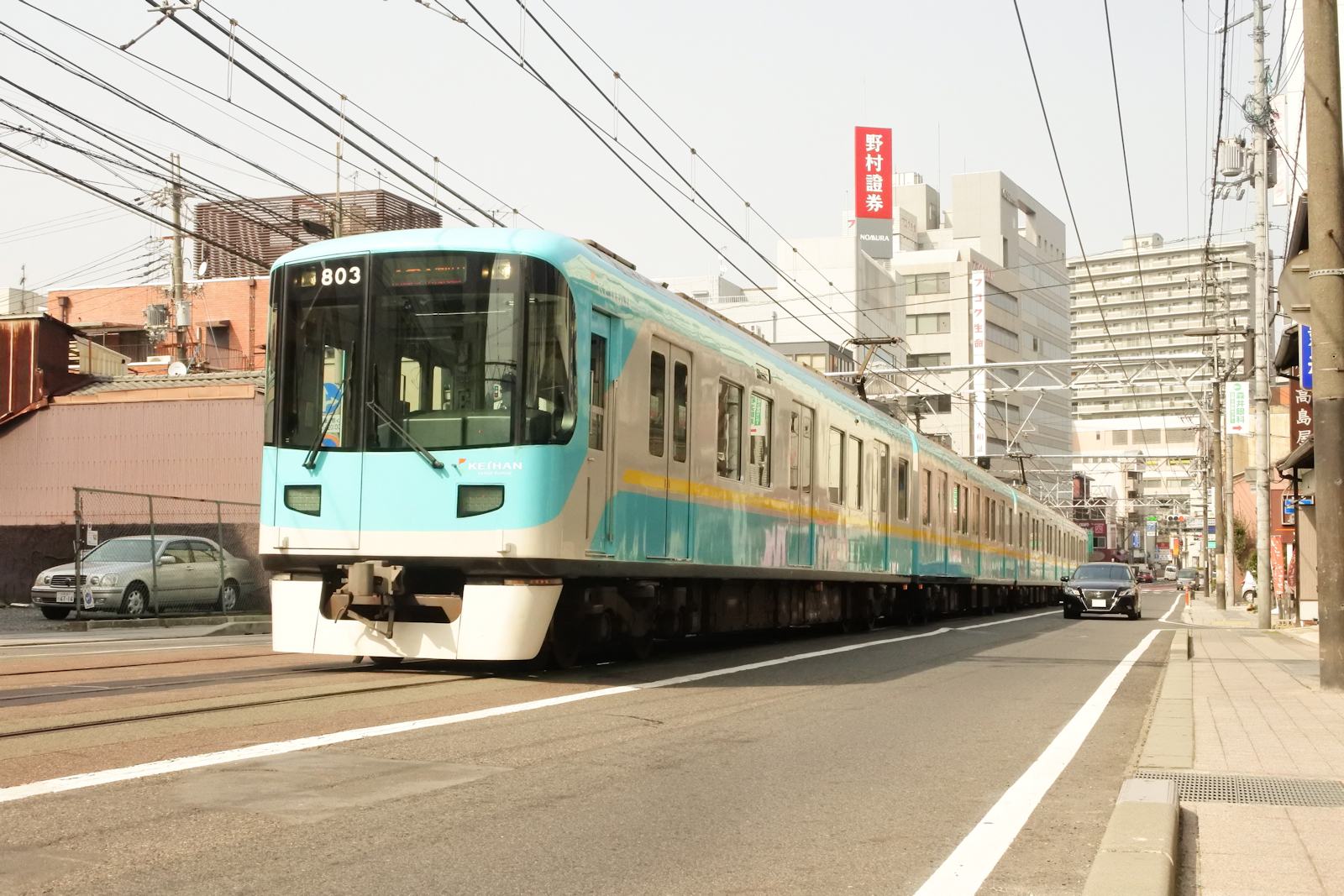
併用軌道を走る京阪京津線
京都市地下鉄東西線の次は、その東西線へ直通運転する列車を運行している京阪京津線へ。京阪京津線といえば、併用軌道(路面電車)区間あり、急勾配あり、京都市地下鉄東西線への直通運転あり、さらには車両も東京都交通局都電荒川線や京福電気鉄道(嵐電)のような路面電車車両ではなく普通鉄道のような16.5m級車両が4両編成(路面電車を監督する軌道法では、同法に準拠する路線の車両は全長30m以内という制限があるが、京津線は特例により走行が認められている)が走行するという、異色な軌道線(路面電車路線)である。京津線が軌道法準拠の路面電車であることを象徴する、びわ湖浜大津駅~上栄町駅間の併用軌道を走る800系電車を撮影。ガードレールのない歩道を活かして、煽りアングルで4両編成の車両が走る迫力を演出した。Travelling from Uzumasa-tenjingawa Station, I went photographing Keihan Keishin Line running on tramway between Biwako-hamaotsu Station and Kamisakaemachi Station.Among tramway lines in Japan, Keishin Line is one of the most characteristic ones, because of the steep slope, going-through service to underground railway, and 4-car train like a normal railway (according to the tramway act in Japan, tramcars have to be up to 30-metre/98.4-foot long, but Keishin Line ones are authorized to operate the longer).Why I decided to photograph between Buwako-hamaotsu Station and Kamisakaemachi Station was to show that Keishin Line is a tramway and shot at low angle to feature the train's size.
Mar 29, 2018
コメント(0)
-

無理難題!? 京都市地下鉄東西線を撮る
今回の撮影で最も困難な1枚、京都市地下鉄東西線列車の撮影にも挑戦した。なぜ東西線の撮影が難しいのかというと、東西線は全線が地下を走るうえにすべての駅に全面ガラス張りのホームドア(スクリーンドア)が設置されているためである。唯一、なんとか撮影可能と言える駅が終着駅である太秦天神川駅である。西大路御池駅~太秦天神川駅間は複線シールドトンネルとなっていることから、六地蔵方から入線しようとする列車をガラス越しに撮影することができる。もちろん僕もここで撮影した。終着駅である太秦天神川駅に到着する直前であることを表現するため、ホーム手前のシザークロッシングも一部を入れて撮影。全線地下区間の地下鉄はどうしても撮影が難しくなる。中でも東西線は京都市交通局の車両による他社路線への直通運転がない(京阪京津線への直通運転は京阪電気鉄道の車両のみ)うえに、ホームドアが設置されていることからどうしてもガラス越しの撮影になってしまうため、東西線を走る50系電車の撮影は特に難しい。この難しい1枚の撮影に一度挑戦してみたかった。It was the most difficult to shoot trains on Kyoto Municipal Subway Tozai Line because all stations on Tozai Line equip platform screen doors and entire line spreads underground.Only one place to be good for photographing Tozai Line train is Uzumasa-tenjingawa Station. Because of double-track tunnel, it is less difficult to photograph as the train coming there over the window.I photographed there. Capturing with a part of scissors crossing in the picture, it makes easy to be distinguished that the picture was shot as approaching the last stop of Tozai Line.It was the most difficult to photograph Kyoto Municipal Subway 50 Series because Tozai Line train operated by 50 Series go through any other lines above ground (all of those going through Keihan Keishin Line are by the cars belonging to Kihan Electric Railway) and because of the platform screen doors, as well as the difficulty to shoot in underground section.I had wanted to try to photograph the difficult one.
Mar 29, 2018
コメント(0)
-

サクラと287系「はしだて」
撮影旅行3日目の3月29日の最初は、JR西日本山陰本線(嵯峨野線)馬堀駅近くのサクラと287系電車「はしだて」を撮影。前日の大阪に続いて、京都府亀岡市もサクラが見頃を迎えていた。この日は「嵯峨野トロッコ列車」こと嵯峨野観光鉄道嵯峨野観光線を乗りに来たのだが、馬堀駅から嵯峨野観光鉄道線トロッコ亀岡駅までの山陰本線の線路沿いに植えられていたサクラの花がきれいに咲き誇っていた。トロッコ列車の到着までに「はしだて」が馬堀駅を通過することから、サクラと列車の写真を1枚撮影した。全体をぼかした雰囲気にしたものの、写真手前の花に焦点を当てて、サクラであることを判りやすくした点と、列車の先頭車両と最後尾車両の両方がサクラの下から見えるように写した点が、この1枚への思い入れである。On the third day of my travel, I went photographing to Kyoto area. My first photograph on that day was cherry blossoms along the railway of Sanin Main Line (Sagano Line) around Umahori Station and 287 Series "Hashidate".In Kameoka City, Kyoto Prefecture, the blossoms was also fully blooming.I went to Kyoto because I wanted to photographed and travelled with Sagano Scenic Railway Sagano Scenic Line ("Sagano Romantic Train"). Before the Romantic Train coming to Torokko Kameoka Station, I photographed that.Though defocusing the image, I focused on a spray of blossoms to create viewer's comprehensibility to distinguish the blossoms and capturing the train from the first car and the last, both of which are my feeling to the image.
Mar 29, 2018
コメント(0)
-

大阪環状線で現役の201系電車
201系 モリLB65編成 大阪駅にて大阪環状線を走る201系電車を撮影。前回の観光名所と共に列車を撮影するよりも、どちらかと言えば201系を撮影したかったのが大阪環状線に来た理由である。国鉄201系電車は、1979(昭和54)年に登場した、1957(昭和32)年登場の101系電車、1964(昭和39)年登場の103系電車に次ぐ国電第3世代の通勤型車両。電機子チョッパ制御と回生ブレーキを国鉄で初めて採用した「省エネ電車」として設計・製造された。JR東日本東京近郊区間では2011(平成23)年の京葉線からの引退以降、その姿を見ることができなくなって久しいが、JR西日本アーバンネットワークでは、大阪環状線や関西本線(大和路線)などで今なお現役で活躍している。そのなかでも、吹田総合車両所森ノ宮支所(近モリ かつての森ノ宮電車区)に所属する大阪環状線用の車両は、体質改善リニューアルが施されているものの、オレンジバーミリオン(朱色1号)の塗装が、かつて中央線快速で走っていた車両を想像させる。オレンジバーミリオン(朱色1号)塗装の201系といえば、JR東日本東京近郊区間では、豊田車両センターに(過去には武蔵小金井電車区(のちに豊田車両センターに統合)と三鷹電車区(現在の三鷹車両センター)にも)配置され、1979(昭和54)年から2010(平成22)年にかけて中央線快速で活躍してきた。一方の大阪環状線では2005(平成17)年から201系が運行されている。すべて網干総合車両所明石支所に所属していた東海道本線・山陽本線(JR京都線・JR神戸線)用の編成が転属してきたものであり、東海道本線・山陽本線(JR京都線・JR神戸線)時代のスカイブルー(青22号)からオレンジバーミリオン(朱色1号)に車体色が変更された。しかしながら2018(平成30)年度中には、大阪環状線・桜島線(JRゆめ咲線)への323系電車の投入が完了し、201系は両線から姿を消す予定となっている。中央線快速でデビューした当時と同じオレンジバーミリオン(朱色1号)塗装の同車が完全に姿を消す時が間もなくやってくる。僕は引退を前に大阪環状線でオレンジバーミリオン(朱色1号)塗装の201系に出会い、撮影することができて嬉しかった。I also photographed 201 Series on Osaka Loop Line. I preferred to shoot that to the photos of trains and famous spots.201 Series debuted in Japan National Railway period, 1979 and was designed as third generation car for commuter train service in Tokyo and Osaka Metropolitan Area ("Kokuden") following 101 Series, which debuted in 1957, and 103 Series, which debuted in 1964. It had been the first time to introduce a chopper control device and regenerative brake.Though it has passed about seven years since the retirement of 201 Series from Tokyo Area, it remains in service in Osaka Urban Network Area, such as Osaka Loop Line and Kansai Main Line (Yamatoji Line). Especially, though the cars are refurbished, those in service on Osaka Loop Line are coloured Orange, which reminds me of the ones on Chuo Line rapid service, which had been in service between 1979 and 2010 on Chuo Line rapid service. On Osaka Loop Line, 201 Series has been in service since 2005 and has transferred from Tokaido Main Line and Sanyo Main Line (JR Kyoto Line and JR Kobe Line).However, 201 Series on Osaka Loop Line and Sakurajima Line (JR Yumesaki Line) will be completely replaced by 323 Series by March, 2019. I was happy to photograph a set of orange-coloured 201 Series.
Mar 28, 2018
コメント(0)
-

大阪環状線を大阪の名所とともに
続いては大阪のもう一つの重要路線、JR西日本大阪環状線へ。Next, I went photographing JR West Osaka Loop Line trains, one of the most important railway in Osaka City, too.1枚目は桜ノ宮駅のホームから、この日ちょうど見頃を迎えていた大川沿いのサクラの花とともに大和路快速列車(221系電車)と外回り各停列車(323系電車)を撮影。大阪環状線沿線で一番のサクラの名所と言われるだけに、この日も何人か撮り鉄がホームでカメラを構えていた。The first is two trains (counterclockwise-bound Yamatoji Rapid train by 221 Series and clockwise-bound local train by 323 Series) with cherry blossoms from the end of Sakuranomiya Station. The blossom trees planted along Okawa River is said as one of the most beautiful cherry blossom site along Osaka Loop Line. On that day, the other photographers was standing on the station.2枚目は京橋駅~大阪城公園駅間の大川橋梁を渡る外回り列車(323系)を大阪城を入れて撮影。地元の人たちからは”太閤はん”と呼ばれ親しまれている豊臣秀吉公が1583年(天正11年)から1598(慶長3)年にかけて築いた城として知られるが、現存する天守は1931年(昭和6年)に再建されたもの。築城以来、淀川に面したその城下町は日本経済の中心地として大いに発展した。幕末の騒乱の時に天守は1度焼失したものの、現在の再建天守に変わっても大阪の街のシンボルとしての機能は変わっていない。The second is a clockwise-bound train (323 Series) with Osaka Castle between Kyobashi Station and Osakajo-koen [Osaka Castle Park] Station. the Castle originally had been built by Hideyoshi Toyotomi between 1583 and 1598, but the present building had reconstructed in 1931. Since the old castle been constructed, the castle town facing Yodo River developed as the centre of Japanese economic. Though the old castle had lost by a fire in the end of Edo period, it hadn't changed that the reconstructed castle is still one of the symbols in the city.3枚目は新今宮駅~天王寺駅間の掘割を走る内回り列車(323系)を天王寺駅の駅ビル「天王寺MIO」11階から撮影。天王寺公園や通天閣、奥の方にうっすらとだが大阪ドームも入れられる、少し欲張った構図で撮影。The third is a counterclockwise-bound train (323 Series) with Tennoji Park, Tsutenkaku Tower, and Osaka Dome dim in the distance over them between Shin-imamiya Station and Tennoji Station over a window of 11th floor of a Tennoji Station building "Tennoji MIO".
Mar 28, 2018
コメント(0)
-
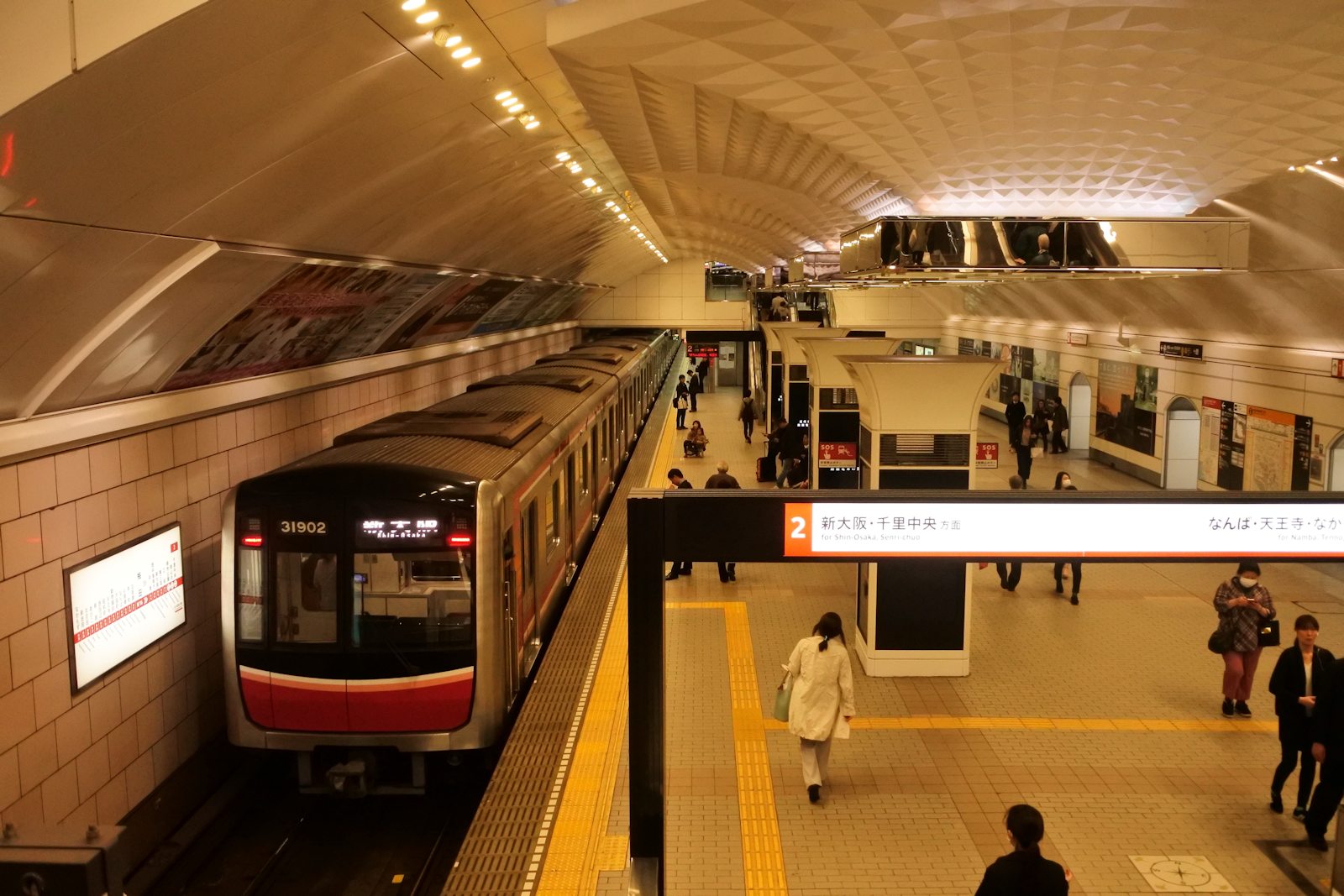
高い天井がシンボルの御堂筋線梅田駅
大阪市地下鉄(Osaka Metro)御堂筋線の駅のなかで、1933(昭和8)年に開業した最初の営業区間である梅田駅~心斎橋駅間の各駅(梅田駅・淀屋橋駅・本町駅・心斎橋駅)は、高いアーチ状の天井が特徴である。このうち最初の区間の始発駅として開業した梅田駅を見てきた。梅田駅を発車する30000系電車 (構図は「鉄道ジャーナル」1994(平成6)年9月号の写真を参考) 30000 Series departing from Umeda Station (its composition is based on the one on "The Railway Journal" issued in September, 1994)梅田駅に入線する21系電車 21 Series coming in to Umeda Station梅田駅のホームは心斎橋・なんば・天王寺・なかもず方面行き列車(大阪市地下鉄(Osaka Metro)各線は軌道法準拠のため正式には「列車」とは呼ばないが、ここでは便宜上鉄道事業法の「列車」に準ずるものとして「列車」とする)が発着する1番のりばと新大阪・江坂・千里中央方面行き列車が発着する2番のりばから成る。ホームは大きな1つの島式ホームのように見えるが、開業当時は現在の2番のりばにあたるホームのみが使われており、現在の1番のりばは1989(平成元)年の拡張工事で後付けされたものである。両のりばはお互いに行き来ができる通路があるものの、壁で隔てられている。開業当初から使われ続けている2番のりばは、その当時は単行(1両)列車での運行だったにもかかわらず、将来の輸送量増加を見込んでホームは189m(現役の御堂筋線の車両10両編成の長さ(187.4m)にほぼ等しい 1989(平成元)年のホーム拡幅時に197mに延伸)の長さで建設された。高い天井からはシャンデリア(開業当初は白熱灯シャンデリア。1952(昭和27)年に天井に直接取り付けの蛍光灯照明へ、1967(昭和42)年に蛍光灯シャンデリアへと変化)が吊り下げられ、アーチ天井とともに梅田駅のシンボルとなっていた。2015(平成27)年に天井と一体になった逆さ富士山型のLED照明にリニューアルされたが、蛍光灯シャンデリア時代と同じくその特徴的な形状・意匠から新たなシンボルとなっている。御堂筋線は第三軌条集電方式であるため線路上空に架線がなく、地下駅でありながらとても開放的な印象であった。Among the stations on Osaka Municipal Transportation Bureau (Osaka Metro) Midosuji Line, the four on the first-open section in 1933, between Umeda Station and Shinsaibashi Station (Yodoyabashi Station and Hommachi Station), have a high vaulted ceiling. I visited and photographed the departing station when Midosuji Line first opening.The platform of Umeda Station is located between the two sets of tracks, which looks like a wide one island platform. However, when it opening, only the present platform 2 used to be existed (the platform 1 had been constructed in 1989). Though people can go and come between the two platforms, the platforms are separated by a wall.Though only one-car train has been operated when the station and Midosuji Line first opening, the platform has been 189-metre/620.1-foot long (almost the same as the present 10-car train on Midosuji Line is 187.4-metre/614.8-foot, and it had been extended to 197-metre/646.3-foot long in 1989) since the opening to look forward. From the ceiling, chandeliers used to be hung, which also used to be regarded as a characteristics together with the ceiling, but they changed to inverted trapezium/trapezoid-shaped LED lights integrated with the ceiling. The new lights can be said the symbol because of its shape.From my point of view, though it is an underground station, the platform ceiling may create a open space because Midosuji Line introduces third rail system.参考文献 Reference「鉄道ジャーナル」1994年9月号『大阪市営地下鉄 御堂筋線を通してみる大阪のアイデンティティ』中村有一一般社団法人 公営交通事業協会 会報第548号「大阪市営地下鉄御堂筋線梅田駅の アーチ天井が「照明普及賞」を受賞 」 2016年7月
Mar 28, 2018
コメント(0)
-

やっと会えた大阪市地下鉄御堂筋線、そして“地下鉄のお嬢ちゃん”
上淀川橋梁を渡るJR西日本87系気動車「TWILIGHT EXPRESS 瑞風」を撮影後、大阪市地下鉄(2018(平成30)年4月1日より大阪市高速電気軌道(Osaka Metro))御堂筋線西中島南方駅へ。新大阪、梅田、なんば、天王寺と、大阪市の主要な街を南北に貫く、大阪の大動脈となっている御堂筋線を撮影。御堂筋線の中津駅付近~江坂駅の区間と、御堂筋線と相互直通運転を行う北大阪急行電鉄南北線の江坂駅~千里中央駅付近の区間は新御堂筋の上下車線の真ん中に線路が通る高架区間であり、御堂筋線・南北線を走る車両の写真はこの区間で撮られるものが多い。大阪市交通局10系、21系、30000系の3車種を撮影。10系は「さようなら大阪市交通局」のヘッドマークを付けた1113Fが、21系はリニューアル車(21606F)、原型車(21615F)の両方ともが、30000系はトップナンバーの31601Fが撮れた。1113Fのヘッドマークは交通局時代の最末期を象徴する1枚が撮れた。そして大阪市地下鉄といえば、僕にとって忘れてはいけないのが、“地下鉄のお嬢ちゃん”。大阪市地下鉄の車両の側扉戸尻に貼り付けられている引き込まれ注意ステッカーに描かれている女の子。彼女には公式な名前はないが、分かりやすい絵柄とメッセージ性の高さが気に入り、僕はこう呼んで可愛がっている。僕はこれまでに何度かお嬢ちゃんのイラストを描いたことがあったが、やはり大阪へ行って1度“本人”に会ってみたいと思い続けていた。今回御堂筋線の車両に乗り、初めて会うことができた。手が赤く腫れるほどの痛い目に遭っているお嬢ちゃんは、見ているだけでかわいそうで慰めてあげたいという気持ちにさせられてしまうが、地下鉄に乗っている子供達に痛い思いをしてまで引き込まれ事故の怖さを伝えようとしている彼女の姿には、小さな感動を覚える。After photographing JR West 87 Series "TWILIGHT EXPRESS Mizukaze", I went shooting at Nishi-nakajima-minamigata Station on Osaka Municipal Subway (Osaka Metro from April 1st, 2018) Midosuji Line trains on Midosuji Line. Midosuji Line is one of the most important railways in Osaka City because of its connection through big towns in Osaka, Shin-osaka, Umeda, Namba, and Tennoji.Between the northeast of Nakatsu Station and south of Senri-chuo Station on Kita-osaka-kyuko Railway Namboku Line, through which most Midosuji Line trains go, the railway of Midosuji Line and Namboku Line is an overhead section in the median of Shin-Midosuji Avenue. Many photographers shoot trains there, and some of them appear in magazines.I shot Osaka Municipal Transportation Bureau 10 Series 1113F set which showed a front sign for the end of and thanks for 114-year of the Transportation Bureau (in the first and second photographs), refurbished 21 Series (21606F set, in the third), 30000 Series (31601F set, in the fourth), and non-refurbished 21 Series (21615F set, in the fifth).One more what I must not forget was the mind-the-doors sign on the passengers' doors with a cartoon featuring a girl who injured her hand and made it swollen. Though she is unnamed, I called her "Osaka Subway Girl" with affection because I like the understandable and adorable design.I have represented some fan art several times, but I wish I wanted to see the sign on the train.Looking at her, I feel bad for and would like to comfort her, but I also moved her telling the children on the train not to catch and hurt their hands.
Mar 28, 2018
コメント(0)
-

島本駅で撮った車両たち
287系電車「くろしお」 287 Series "Kuroshio"2011(平成23)年に新大阪駅~福知山駅・城崎温泉駅間の「こうのとり」、京都駅~福知山駅・城崎温泉駅間の「きのさき」、京都駅~天橋立駅間の「はしだて」、京都駅~東舞鶴駅間の「まいづる」の「北近畿ビッグXネットワーク」の4列車用車両として登場した。京都駅・新大阪駅~白浜駅・紀伊勝浦駅・新宮駅間の「くろしお」としては2012(平成24)年より運行されている(当初は白浜駅発着列車を担当し、後述する289系が投入された2015(平成27)年より新宮駅発着列車を担当)。287 Series debuted in 2011 as four limited express trains connecting between Kyoto Station or Shin-osaka Station and Amano-hashidate Station, Higashi-maizuru Station, or Kinosaki-onsen Station, "Kounotori", Kinosaki", "Hashidate", and "Maizuru". Since 2012, it also has been in service as "Kuroshio" limited express connecting Kyoto Station or Shin-osaka Station and Shirahama Station or Shingu Station (at first 287 Series used to be as trains for Shirahama and is in as those for Shingu together with 289 Series since 2015).221系電車 221 Series1989(平成元)年に東海道本線・山陽本線(琵琶湖線・JR京都線・JR神戸線)の新快速・快速列車と関西本線(大和路線)・大阪環状線の大和路快速列車用車両として登場した、JR西日本が会社発足後初めて設計した近郊型車両。国鉄時代に新快速列車として活躍した117系電車に代わる同列車の主力車両として、最高120km/hでの運行が可能な仕様で設計され、所要時間はそのままで停車駅を増やす(高槻駅と芦屋駅を追加 当時は両駅とも日中時間帯のみ停車)ことに成功した。同時に117系と同じ転換クロスシートを備えるが、2扉から3扉となり、ラッシュ時の乗降時間短縮に貢献した。1999(平成11)年に新快速列車の主力を後継の223系電車に譲ったものの、東海道本線・山陽本線(琵琶湖線・JR京都線・JR神戸線)では各停・快速列車として今なお運行されている。221 Series is JR West's first-designed car, which started to be manufactured and debuted in 1989. It is designed as the car for special rapid train or rapid train on Tokaido Main Line and Sanyo Main Line (Biwako Line, JR Kyoto Line, and JR Kobe Line) and Yamatoji Rapid train on Kansai Main Line (Yamatoji Line) and Osaka Loop Line service and available to run at up to 120-kilometre/74.6-mile per hour. It equips transverse seatings with reversible backrest as well as 117 Series, but three side passengers' doors are laid out to reduce stopping time in the rush hour compared with two-doored 117 Series. After replacement of all special rapid train by 223 Series in 1999, it keep being in service on Tokaido Main Line and Sanyo Main Line as rapid trains or local trains.JR東海キハ85系気動車「ワイドビューひだ」 JR Central Kiha 85 Series "Wide View Hida"1989(平成元)年に登場したJR東海が会社発足後初めて設計した特急型気動車。同年より名古屋駅・大阪駅~高山駅・飛騨古川駅・富山駅間の特急列車「ひだ」として運行されている。その多くが名古屋駅を始発・終着駅としている「ひだ」であるが、大阪駅発着の列車が1往復存在する。写真は25号は大阪駅発の高山行き列車で、岐阜駅で名古屋駅発の5号と連結が行われ、高山駅まで両列車が一体となって運行されている。5号は飛騨古川行きであるため、高山駅止まりの25号は同駅で切り離される。大阪行きの「ひだ36号」はその逆で、高山駅~岐阜駅間は名古屋行き「ひだ16号」と連結して運行し、岐阜駅で両列車を切り離し、それぞれの終着駅を目指す。Kiha 85 Series is JR Central's first-designed car, which started to be manufactured and debuted in 1989. It is designed for "Hida" limited express connecting between Nagoya Station or Osaka Station and Takayama Station, Hida-furukawa Station, or Toyama Station. Though most of "Hida" limited express departs from or terminates at Nagoya Station, one round-trip train is combined with the one coming from or going to Osaka Station between Gifu Station and Takayama Station.681系電車「サンダーバード」 681 Series "Thunderbird"1992(平成4)年に特急「雷鳥」(大阪駅~金沢駅・富山駅)のイメージアップとスピードアップを狙って登場した。臨時列車での営業運転を重ねたのち、1995(平成7)年に「スーパー雷鳥(サンダーバード)」の列車名で本格的にデビューした(「サンダーバード」への改称は1997(平成9)年)。後継車両の683系とともに485系で運行されていた「雷鳥」を順次置き換え、2011(平成23)年に全列車が681系・683系の「サンダーバード」に置き換えられた。681 Series debuted in 1992 to aim to improve running speed of "Raicho" limited express connecting between Osaka Station and Kanazawa Station or Toyama Station. Since its debut, it had operated as "Raicho" service in the high season. It had started its regular operation as "Super Raicho Thunderbird" in 1995 and the train had been renamed to "Thunderbird" in 1997. a Together with 683 Series, the two had been completely replaced 485 Series and "Raicho" in 2011.289系電車「こうのとり」 289 Series "Kounotori"2003(平成15)年から2015(平成27)年まで名古屋駅~金沢駅・富山駅間の特急列車「しらさぎ」として運行されていた683系電車を、交直両用から直流専用に改造し、新大阪駅~福知山駅・城崎温泉駅間の「こうのとり」、京都駅~福知山駅・城崎温泉駅間の「きのさき」、京都駅~天橋立駅間の「はしだて」の「北近畿ビッグXネットワーク」の3列車と、京都駅・新大阪駅~白浜駅の「くろしお」に転用された。「くろしお」用の編成は当初、白浜駅発着列車を担当し、2018(平成30)年より新宮駅発着列車も担当するようになった。289 Series, which is converted from 683 Series used to be in service as "Shirasagi" limited express between Nagoya Station or Maibara Station and Kanazawa Station or Toyama Station between 2003 and 2015 to those to be available to both AC- and DC-electrified section to only DC-electrified, debuted in 2015 as three limited express trains connecting between Kyoto Station or Shin-osaka Station and Amano-hashidate Station or Kinosaki-onsen Station, "Kounotori", Kinosaki", and "Hashidate", and as "Kuroshio" limited express connecting Kyoto Station or Shin-osaka Station and Shirahama Station or Shingu Station (at first it used to be as trains for Shirahama and is in as those for Shingu together with 287 Series since 2018).281系電車「はるか」 281 Series "Haruka"1994(平成6)年の関西空港線および関西国際空港開業に合わせて、京都駅~関西空港駅間を東海道本線(JR京都線)・梅田貨物線・大阪環状線・阪和線・関西空港線経由で運行するの特急列車「はるか」としてデビュー。以来、ほぼ「はるか」専用の車両として運行されている。281 Series debuted as "Haruka" limited express connecting between Kyoto Station and Kansai Airport Station in 1994, the same time as the open of Kansai Airport and Kansai Airport Line. Since that time, it has been served almost only for "Haruka".223系電車 223 Series1994(平成6)年に、大阪環状線・阪和線・関西空港線の「関空快速」列車用として登場。東海道本線・山陽本線(琵琶湖線・JR京都線・JR神戸線)・湖西線・北陸本線・赤穂線の新快速・快速列車としては1995(平成7)年より運行されている。同年1月に発生した兵庫県南部地震(阪神・淡路大震災)からの復旧後の輸送力増強のため、当初の予定よりも前倒しして同年8月にデビューした。新快速列車の130km/hへのスピードアップも目的に関空快速用の車両から改良され、1999(平成11)年には新快速列車の全列車が223系での運行が実現した。2010(平成22)年以降は後継の225系電車と共に、引き続き運行されている。223 Series debuted in 1994 as Kansai Airport rapid train on Osaka Loop Line, Hanwa Line, and Kansai Airport Line. As special rapid train on Tokaido Main Line, Sanyo Main Line (Biwako Line, JR Kyoto Line, and JR Kobe Line), Kosei Line, Hokuriku Main Line, and Ako Line, it has been in service since August, 1995, whose debut as special rapid train had been earlier than the first plan because of Great Hanshin Earthquake on January of that year. The cars for special rapid service had also been improved to aim to run at up to 130-kilometre/80.8-mile per hour and all special rapid train has been operated by 223 Series since 1999. Since 2010, together with the latest model, 225 Series, it keeps being in service.智頭急行HOT7000系気動車「スーパーはくと」 Chizu Kyuko HOT7000 Series "Super Hakuto"1994(平成6)年に智頭急行智頭線の開業と同時に、特急「スーパーはくと」として運行を開始した。当初は新大阪駅~鳥取駅・倉吉駅間で運行され、阪神・淡路大震災後の1995(平成7)年4月より臨時列車として京都駅へと延長運転され、1996(平成8)年より京都駅発着列車が正式に定期運行へと格上げされた。気動車でありながら最高130km/hの高速で走行可能な性能と制御付き自然振り子機構台車を備え、京都駅~姫路駅間は新快速列車と同等の1時間30分で、急勾配とカーブの多い智頭線・JR西日本因美線を含む京都駅~鳥取駅間は3時間前後で走破する。HOT7000 Series debuted as "Super Hakuto" limited express in 1994 at the same time as the open of Chizu Kyuko Chizu Line. At first, "Super Hakuto" used to operate between Shin-osaka Station and Tottori Station or Kurayoshi Station, but after April, 1995, its operating section was extended to Kyoto Station. Though HOT7000 Series is a diesel car, it equips the specification that can run at up to 130-kilometre/80.8-mile per hour and passive tilting bogie with programmed tilting controller. It takes about the same time as special rapid train, one and half an hour between Kyoto Station and Himeji Station, and about three hours between Kyoto Station and Tottori Station, including Chizu Line and JR West Inbi Line, two of which have many curves and steep slopes.
Mar 28, 2018
コメント(0)
-

87系「TWILIGHT EXPRESS 瑞風」を撮る
大阪撮影旅行2日目の3月28日。この日は今回一番撮りたかった車両であるJR西日本87系気動車「TWILIGHT EXPRESS 瑞風」を撮影。87系「TWILIGHT EXPRESS 瑞風」には大阪駅→京都駅→下関駅(山陰本線経由)の「山陰コース下り」、下関駅→京都駅→大阪駅(山陰本線経由)の「山陰コース上り」、京都駅→大阪駅→下関駅の「山陽コース下り」、下関駅→大阪駅→京都駅の「山陽コース上り」、京都駅→大阪駅→下関駅→京都駅→大阪駅の「山陽・山陰コース」の5種類があるが、3月28日から30日までの3日間は東海道本線・山陽本線・山陰本線を巡る「山陽・山陰コース」の1日目に当たる日。最初は島本駅で、所属車庫である網干総合車両所宮原支所(かつての宮原総合運転所)から始発駅である京都駅へと向かう回送列車を撮影。島本駅の高槻・大阪方はカーブを描いており、なおかつ4本ある線路の間に架線柱がないことから、編成全体をきれいに納められることから多くの撮り鉄がカメラを構える有名撮影ポイントである。当然この日も、87系を目当てにカメラを構えていた撮り鉄が数人ホームに立っていた。続いては新大阪駅~大阪駅間の上淀川橋梁を渡る列車を新大阪の街を背景に入れて撮影。ここ淀川の川原もまた東海道本線(JR京都線)の有名撮影ポイントである。島本駅での撮影を終えてから淀川へ向かっても、京都駅へと向かった「TWILIGHT EXPRESS 瑞風」が新大阪駅を発車するまでに間に合うため、大阪を象徴する淀川とJR西日本の最新型車両の組み合わせた1枚を撮れた。同じく2017(平成29)年デビューの豪華寝台車両、JR東日本E001系EDC「TRAIN SUITE 四季島」と2018(平成30)年のブルーリボン賞を争うことが間違いないだろう。On the second day of my travel, March 28th, I photographed JR West 87 Series "TWILIGHT EXPRESS Mizukaze", what I most photographed during the travel."TWILIGHT EXPRESS Mizukaze" has five travel plans, two-day from Osaka Station to Shimonoseki Station via Kyoto Station and Sanin Main Line (almost along the Sea of Japan), two-day from Shimonoseki Station to Osaka Station via Sanin Main Line and Kyoto Station, two-day from Kyoto Station to Shimonoseki Station via Osaka Station and Sanyo Main Line (almost along Seto Inland Sea), two-day from Shimonoseki Station to Kyoto Station via Sanyo Main Line, three-day and from Kyoto Station to Osaka Station via Sanyo Main Line and Sanin Main Line (almost along the two seas). That day was the first day of the three-day travel.First, I photographed at Shimamoto Station, one of the most famous photo spot because of a curve before its platform, no catenary poles between the tracks, where photographers can shoot a car set from the front to the end beautifully, while the train coming to Kyoto Station from Miyahara train shed. On that day some photographers already waited for 87 Series.After photographing at Shimamoto Station, I moved to the riverbank of Yodogawa River, which is located in almost the middle of the railway between Shin-osaka Station and Osaka Station and also one of the most famous photo spots. While "TWILIGHT EXPRESS Mizukaze" going to Kyoto Station and coming to the bridge, I had a enough time to move. I could photographed 87 Series crossing the river, one of the well-known symbol of Osaka City, against the buildings around Shin-osaka Station.I expect that 87 Series competes with JR East E001 Series "TRAIN SUITE Shikishima" for "Blue Ribbon Prize" in 2018.
Mar 28, 2018
コメント(0)
-

甲子園駅で撮影した阪神電車など
甲子園駅で阪神電車、直通運転して来る近鉄電車、山陽電気鉄道の車両を撮影。At Koshien Station, I photographed the trains on Hanshin Main Line.8000系電車 8000 Series1984(昭和59)年から1996(平成8)年にかけて製造された、阪神本線の直通特急・特急・急行列車の主力車両。デビュー当時は1958(昭和33)年製造の3301系から続く「赤胴車」と呼ばれる上半分がクリーム色、下半分が朱色の車体塗装であった。第1編成である8201F(2018(平成30)年現在は8523Fの元町方3両(8102・8002・8502号車)が現存)と第2編成である8211F以降の編成で前面デザインが大きく変更され、阪神電車のイメージチェンジを図った。2002(平成14)年から2015(平成27)年にかけてすべての編成にリニューアルが施行され、車体塗装も写真の上半分がプレストオレンジ、下半分がシルキーベージュに変更された。8000 Series was manufactured between 1984 and 1996. It has been the flagship carriage for limited express and express trains on Hanshin Main Line. When it debuted, its body was coloured cream (upper half) and red (lower half), the standard colour for the carriages for limited express trains since 1958. In the second-made set, 8211F, the design of its front changed from the first-made set, 8201F (three cars of them (8102, 8002, and 8502, consisting of 8523F set) in the present), and created a new image of the train. Between 2002 and 2015, all sets were refurbished and changed their body colour, presto orange and silky beige.5500系電車リニューアル車 refurbished 5500 Series1995(平成7)年に登場した各停列車の主力車両である5500系を、2017(平成29)年より、外装の塗色・塗り分けの変更と最新型車両である5700系に準じた内装にリニューアルを施した。リニューアル内容は、ドア上への液晶案内表示の設置、握り棒と車椅子スペースの増設など。5500 Series, first manufactured in 1995, started to make itself refurbished, changing its body colour and equipping LCD above the doors, more grab handles, and wheelchair space, in 2017.9300系電車 9300 Series2001(平成13)年に直通特急用として登場した。直通特急として運行されている山陽電気鉄道5000系のセミクロスシートが阪神本線の乗客にも好評だったことを反映させて、中間車4両を転換クロスシートとロングシートを組み合わせたセミクロスシートとした。車体塗装は8000系までの「赤胴車」色から、5500系を参考にした上半分がプレストオレンジ、下半分がシルキーベージュに変更された。2018(平成30)年現在は8000系とともに直通特急・特急・急行列車として運行されている。3編成しか在籍しないレア車両。9300 Series debuted in 2001 and mainly operated as limited express and express trains, together with 8000 Series. Reflecting the reputation for the transverse seats of Sanyo Electric Railway 5000 Series, which comes as limited express onto Hanshin Main Line, transverse seats with reversible backrests are mainly laid out in the middle of four carriages of a 6-carriage set. Its body is painted in presto orange and silky beige. Only three sets exist.5001形電車 5001 Series1977(昭和52)年から1981(昭和56)年にかけて製造された各停列車用の車両。上半分がクリーム色、下半分がウルトラマリンブルーの「青胴車」と呼ばれる塗装を纏う。駅間の短い阪神本線では、所要時間の短縮と特急・急行列車の遅延防止を目的に、各停列車用の車両には高い加減速性能が求められるのだが、5001形は起動加速度4.5km/h/s、常用ブレーキ時の減速度5.0km/h/sという、2018(平成30)年時点で現役の鉄道車両の中で最も優れた性能を持っている。2018(平成30)年3月時点では1両も廃車されていないが、5700系の増備によって廃車が予定されている。5001 Series was manufactured between 1977 and 1981, operating as local trains. Its body is painted in cream (upper half) and ultramarine blue (lower half). Because of the short distance between stations, the cars for local trains require a high acceleration and braking deceleration. 5001 Series was designed with an acceleration ratio of 4.5-kilometre/2.8-mile per hour per second and braking deceleration of 5-kilometre/3.1-mile per hour per second, which is the best specification among railway carriages in Japan in service in 2018. 5001 Series will be retired in a few years because of the replacement by 5700 Series.近鉄9820系電車 Kintetsu Railway 9820 Series2001(平成13)年から2008(平成20)年にかけて製造された、2000(平成12)年に登場した3220系・5820系・9020系、および2002(平成14)年に登場した6820系とともに「シリーズ21」と呼ばれる車両群の1車種。阪神本線へは、2009(平成21)年より阪神なんば線を介して乗り入れて来るようになった。主に近鉄奈良駅~神戸三宮駅間を運行する快速急行列車として運行されている。Kintetsu Railway 9820 Series was manufactured between 2001 and 2008 and one of the new-type commuter train or middle-distance train service called "Series 21", as well as 3220 Series, 5820 Series, 9020 Series, three of which started to be manufactured in 2000, and 6820 Series, which did in 2002. Since 2009, it has been coming onto Hanshin Main Line as rapid express trains between Kintetsu-nara Station and Kobe-sannomiya Station via Kintetsu Nara Line and Hanshin Namba Line. 1000系電車 1000 Series2006(平成18)年から2011(平成23)年にかけて製造され、2007(平成19)年に営業運転を開始した。主に近鉄奈良線へ直通運転する快速急行列車として運行されている。ステンレス車体の銀色にオレンジ色の塗り分けだが、9300系や8000系リニューアル車のプレストオレンジよりも黄色味がやや強いヴィヴァーチェオレンジを採用した。6両編成と2両編成があり、最大で10両編成での運用が可能。近鉄奈良線・阪神なんば線系統の列車として運行されているほか、阪神本線・山陽電気鉄道本線の直通特急などでも運行されている、広範囲での運行が可能な車両。1000 Series was manufactured between 2006 and 2011 and started its regular service in 2007. It mainly operates as rapid express trains going onto Kintetsu Nara Line. It was made of stainless steel and has a "Vivace Orange" livery. The shade of Vivace Orange looks different from that of 9300 Series' and refurbished 8000 Series'. 6-carriage sets and 2-carriage sets exist, and they can couple up to 10 cars in regular service. It also operates as limited express trains through Sanyo Electric Railway Main Line.5500系電車 5500 Series1995(平成7)年から2000(平成12)年にかけて製造された各停列車用車両。前面デザインは第2編成(8211F)以降に製造された8000系に似ているが、5001形などの「青胴車」色に代わって上半分がアレグロブルー、下半分がシルキーグレイという新しい塗装が採用された。阪神電車で初めてのVVVF制御を採用した車両でもある。今後全編成にリニューアルが予定されており、写真の塗装も数年以内に見られなくなる。5500 Series had been manufactured between 1995 and 2000 and designed for local train use. The design of its front resembles that of 8000 Series (after second-made sets), but its body was painted in allegro blue (upper half) and silky grey (lower half). It was the first time that Hanshin Electric Railway introduced a variable-frequency drive. As already stated, all of 5500 Series are planning to be refurbished.山陽電気鉄道5000系電車 Sanyo Electric Railway 5000 Series1985(昭和60)年から1995(平成7)年にかけて製造された山陽電気鉄道の車両。阪神本線へは主に直通特急として乗り入れて来る。内装は転換クロスシートを主体としたセミクロスシートで、直通特急列車や山陽電気鉄道本線の特急列車として主に運行され、特に運行距離が長い直通特急列車として多く運行されている。Sanyo Electric Railway 5000 Series had been manufactured between 1985 and 1995. It equips both transverse seats with reversible backrests and longitudinal seats. 5000 Series mainly operates as limited express trains going through Hanshin Main Line.5700系電車 5700 Series2015(平成27)年に登場した各停列車用の最新型車両。愛称は「ジェット・シルバー5700」。車体塗色に使われている青色は新色のカインドブルー。永久磁石同期モーターを阪神電車で初採用。2016(平成28)年、阪神電車の車両として初めてブルーリボン賞を受賞。今後も増備予定。なお、ステンレス車体を採用した各停列車用車両および「ジェット・シルバー」の愛称は、1959(昭和34)年から1977(昭和52)年まで活躍した5201形5201・5202号車に次いで2代目である。5700 Series started its service in 2015 and is in service as local trains. It is nicknamed "Jet Silver 5700". The blue on its body is newly-created "Kind Blue". It was the first time that Hanshin Electric Railway introduced a permanent magnet synchronous motor equipped. It got the Blue Ribbon Prize first time as Hanshin Electric Railway carriages in 2016. More cars are planning to be manufactured. The carriages for local trains made of stainless steel and those nicknamed "Jet Silver" were introduced a second time following 5201 and 5202, two of which were in service between 1959 and 1977.
Mar 27, 2018
コメント(0)
-

JR西日本にライバル心むき出し!? 阪神電車甲子園駅の接近メロディ「今ありて」
今津駅で阪神本線に乗り換え、3月23日から4月4日までの選抜高校野球大会の期間中、甲子園駅で使用されていた同大会の大会歌および入場行進曲「今ありて」の接近メロディを聴いてきた。阪神本線甲子園駅では、2013(平成25)年より夏の全国高校野球選手権大会の期間中にABC朝日放送(2018(平成30)年より朝日放送テレビ)制作の大会中継(朝日放送テレビのほかBS朝日でも放送)および「熱闘甲子園」のテーマソングを、2015(平成27)年より春の選抜高校野球大会の期間中は同大会の入場行進曲に使用されている楽曲を接近放送前のメロディとして流している。2015(平成27)年より毎年使用されている春の選抜高校野球大会期間中のメロディは、阪神電車各駅の接近・発車メロディの作曲を手掛けた向谷実さんが編曲したバージョンである。今年2018(平成30)年の「今ありて」の接近メロディは、原曲でいうところの♪「ああ 甲子園 草の芽 萌え立ち」の部分が編曲された。ここからは僕の個人的な感想だが、選抜高校野球大会の大会歌および入場行進曲という理由で大会期間限定で使われている曲だが、谷村新司さんといえば「三都物語」「いい日旅立ち・西へ」「北陸ロマン」など、JR西日本のCMソングの作詞・作曲・歌唱を手掛けてきたミュージシャンであるだけに、相互直通運転を行う山陽電気鉄道本線を含めた梅田駅~山陽姫路駅の全線で並行・競合しているJR西日本東海道本線・山陽本線(JR神戸線)への敵意をむき出しにしているようにも見えた。Transferring Hanshin Main Line at Imazu Station, I next went to Koshien Station to listen to a special music before the train announcement "Ima Arite", which is known as the theme song of "Japanese High School Baseball Invitational Tournament", used. At the same time, the tournament was being held (from March 23rd to April 4th).Since 2013, theme songs of the live-televised "Japanese High School Baseball Championship" in the summer on ABC Asahi Broadcasting Corporation (rebuilt and transferred the business to Asahi Television Broadcasting Corporation in 2018), and since 2015, those of "Japanese High School Baseball Invitational Tournament" in spring have been arranged and played at Koshien Station. The latter have been arranged by Minoru Mukaiya, who also composed the music that is regularly used at all stations on Hanshin Electric Railway lines.In my opinion, because "Ima Arite" was originally composed and sung by Shinji Tanimura, who has created the music for JR West commercials, such as "Santo Monogatari", "Iihi Tabidachi Nishi-e", and "Hokuriku Roman". JR West is also the operator of Tokaido Main Line and Sanyo Main Line (JR Kobe Line), both of which are spread in parallel with and compete with Hanshin Main Line and Sanyo Electric Railway Main Line all along the line, from Umeda Station, Osaka Prefecture, to Sanyo-himeji Station, Hyogo Prefecture. Using Shinji Tanimura's music, I saw it seemed to show overt hostility to JR West.
Mar 27, 2018
コメント(0)
-

ずっと乗りたかった阪急6000系6020×3R
今津北線に続いては西宮北口駅~今津駅間の今津南線へ。南線は西宮北口駅~今津駅間1.6km、乗車時間はわずか3分である。同区間では3両編成の6000系電車ワンマン車が運行されている。僕が西宮北口駅から乗った車両はその6000系ワンマン車のうちの1本、6120×3R編成であった。この6020×3R編成は、僕がずっと前から乗りたかった阪急電車の車両である。というのも、2006(平成18)年に放送されたアニメ「涼宮ハルヒの憂鬱」の作中で甲陽線の列車として描かれていた車両である。「涼宮ハルヒの憂鬱」といえば、前述の阪急甲陽線の列車が登場したほか、原作者である谷川流先生の出身校、兵庫県立西宮北高校がキャラクターたちが通う学校として描かれるなど、甲陽線甲陽園駅周辺が舞台となっている。ロッテのガム「ACUO」のCMで同作のキャラクターたちが生田斗真さんと共演したことでも話題になった。アニメの放送から12年の時が流れて、アニメで描かれた甲陽線ではなく今津南線でではあるが、ようやく6120×3R編成に乗車し、同時に撮影もできた。6000系ワンマン車はどの編成が甲陽線を走っているのか、今津南線を走っているのか、現地に行くまで判らないため、今津南線に来て6120×3R編成に会えたことは幸運だった。I also went to the south part of Hankyu Imazu Line (Nishinomiya-kitaguchi Station - Imazu Station), which is 1.6km/1 mi long and which it takes just three minutes. 3-car 6000 series adapting to conductorless operation is in service.The train I got on was operated by 6020×3R set, which I had longed to see and travel with because it was pictured in "The Melancholy of Haruhi Suzumiya" anime as a train on Hankyu Koyo Line."The Melancholy of Haruhi Suzumiya", broadcast in 2006, is mainly set in Nishinomiya City, such as Koyo Line train, Koyoen Station, and Nishinomiya-kita High School, where the author, Nagaru Tanigawa, graduated. The characters were also composed in a live-action TV commercial for LOTTE's chewing gum "ACUO" featuring a Japanese actor, Toma Ikuta.Having passed 12 years, though it wasn't on Koyo Line, I could get on and photograph 6120×3R. Because people couldn't know which set was in service or not and which was on Koyo Line or south of Imazu Line until coming to the two lines, I was lucky to come to Imazu Line.
Mar 27, 2018
コメント(0)
-
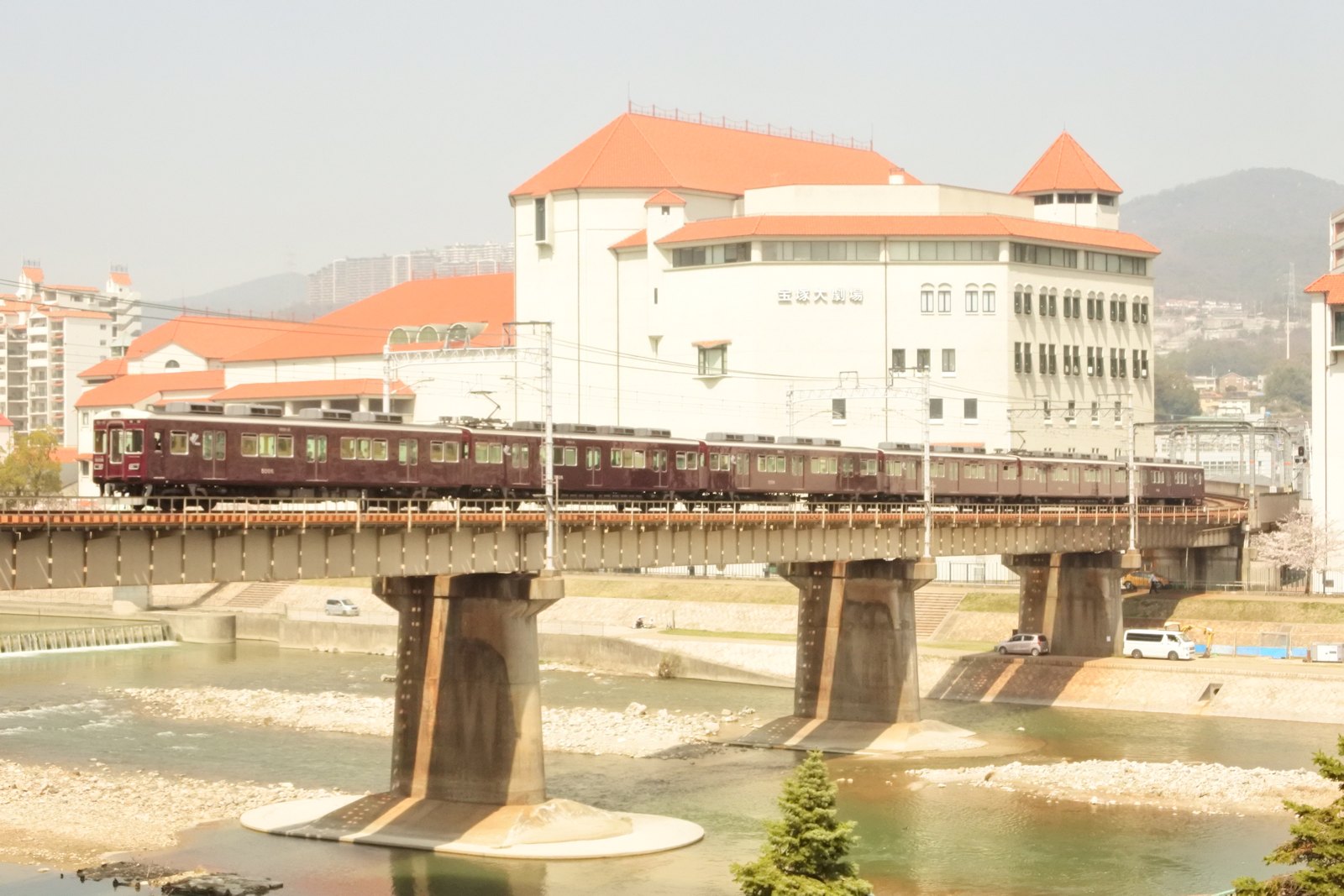
阪急今津線 「片道15分の奇跡」の始まり
5000系電車5006F 5000 Series 5006F set5100系電車5102F 5100 Series 5102F set阪急電車撮影は、西宮北口駅で今津線に乗り換え。兵庫県の宝塚駅と今津駅を結ぶ阪急今津線。運行上は西宮北口駅を境に南北に隔てられ、宝塚駅~西宮北口駅間(通称「今津北線」)と西宮北口駅~今津駅間(通称「今津南線」)の2系統に別れている。運行されている列車も、北線はその多くが、南線はすべてが線内完結の各停列車であり、南北両線とも競合するJR線が存在しないことから、どこかのんびりとした雰囲気が漂う。今津北線宝塚駅~西宮北口駅間といえば、有川浩先生の小説「阪急電車」の舞台となったことでも知られる。同作は2011(平成23)年に「阪急電車 片道15分の奇跡」のタイトルで映画化され、阪急電鉄の全面協力のもと、実際の今津線を走る車両(撮影用の臨時列車)や駅で撮影が行われた。僕は宝塚駅~宝塚南口駅間で、宝塚市の、そして阪急電鉄のエンタテインメント事業のシンボルである宝塚大劇場を背景に、武庫川橋梁を渡る西宮北口行き列車を撮影。映画「阪急電車 片道15分の奇跡」の冒頭にも、武庫川橋梁を渡る列車が登場しており、その冒頭シーンをイメージして捕らえた。映画に登場した、行き先表示幕がなく前面に取り付けたプレートで行き先を表示した3000系電車3058Fと3019F(2編成をつなげて6両編成を組成)は、映画公開から約4カ月後の2011(平成23)年9月に引退・廃車となったが、5000系電車や5100系電車といった、ひと昔前の神戸本線の主力だった車両たちが転属、JR西日本東海道本線(JR神戸線)の列車や阪神本線(阪急電鉄と阪神電気鉄道は、今でこそともに阪急阪神ホールディングスグループに属するが、経営統合前は熾烈な競合関係にあった)の列車との競走から解放されて余生を過ごしているようにも見える。My photographing travel on Hankyu Corporation lines kept going and I transferred to Imazu Line at Nishinomiya-kitaguchi Station.Imazu Line spreads from Takarazuka Station to Imazu Station but the train operation is divided into two sections at Nishinomiya-kitaguchi Station. Because almost all trains in northern part (Takarazuka Station - Nishinomiya-kitaguci Station) and all trains in southern part (Nishimiya-kitaguchi Station - Imazu Station) are local and don't go through the other lines, and no JR Lines are running in parallel, it has a nostalgic and laid-back atmosphere.The north part of Imazu Line also known as where a Japanese novel written by Hiro Arikawa "Hankyu Densha", which was filmed in 2011 under the cooperation of Hankyu Corporation using the real train (specially operated for the shoot) and the stations, is set. These two photographs feature trains crossing Mukogawa River against Takarazuka Theater, the symbol of the entertainment business of Hankyu Corporation like the beginning of the film.Though the cars appearing in the film, 3000 Series 3058F set and 3019F set, two of which consisted of a 6-car set and on whose front destination board used to be put, retired in 2011, about four months after the film started to be shown, cars used to be in service on Kobe Main Line, such as 5000 Series or 5100 Series, moved, looking like getting free themselves from the competition between Kobe Main Line, JR West Tokaido Main Line (JR Kobe Line), and Hanshin Main Line (both Hankyu Corporation and Hanshin Electric Railway belong to Hankyu Hanshin Holdings Group in the present, but the two used to be rival firms before consisting the group).阪急電車 (幻冬舎文庫) [ 有川浩 ]阪急電車 片道15分の奇跡 特別版 [ 中谷美紀 ]
Mar 27, 2018
コメント(0)
-
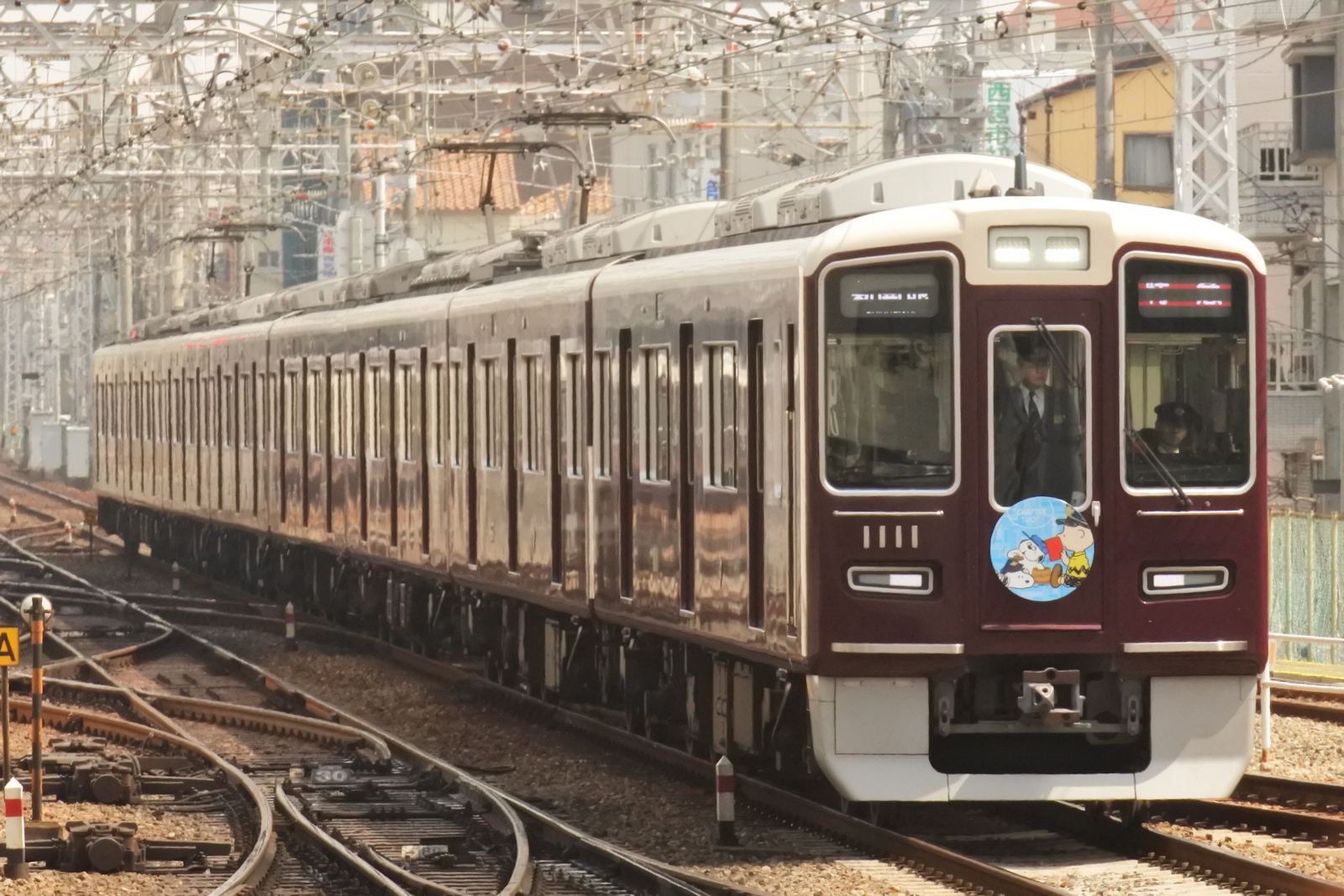
阪急1000系1011F「スヌーピー&フレンズ号」乗車・撮影
JRに続いては、”関西民鉄の雄”と称される阪急電車へ。今回僕が一番撮りたかった・乗りたかった車両が、最新型車両、1000系電車の1011F「スヌーピー&フレンズ」号である。「スヌーピー&フレンズ」号は、日本でも人気の高いアメリカの漫画「ピーナッツ」と阪急電鉄のコラボレーション企画として、2018(平成30)年3月24日より運行されている。ビーグル犬のスヌーピーをはじめとする同作品ののキャラクターのイラストをラッピングした車両で、神戸本線と宝塚本線では1000系1編成ずつ、京都本線では1300系1編成で、それぞれ運行されている。神戸三宮駅で待っていると、梅田行き特急列車で1011Fが入線した。車体ラッピングだけでなく、車内の中吊りもスヌーピーと仲間たちの漫画での心に響く名言や、彼らが阪急電車沿線の観光名所を訪れているイラストで揃えられた特別仕様となっている。梅田駅から折り返してくる列車を撮ろうと、西宮北口駅で降りた。僕は子供のころからの「ピーナッツ」ファンであり、初めて乗った阪急電車が「ピーナッツ」のキャラクターで彩られた車両だったことに、嬉しくて感激した。思い出深い初乗車となった。Following JR trains, I next went photographing trains of Hankyu Corporation.The car I best rode on and photographed was 1000 Series, the latest model on Hankyu Kobe Line and Takarazuka Line, 1011F set, which had livery of "PEANUTS" characters, in service as a collaboration with the work and the railway company since March 24th, 2018. On Kobe Line, Takarazuka Line, and Kyoto Line, bodies of one set (Kobe Line and Takarazuka Line 1000 Series, Kyoto Line 1300 Series) each are decorated.Waiting for the train at Kobe-sannomiya Station, on Kobe Line, 1011F, came.The posters featuring phrases from "PEANUTS" comics or "PEANUTS" characters against famous sightseeing spots were hung on the train.To photograph the train, I got off and waited at Nishinomiya-kitaguchi Station.As a person loving both "PEANUTS" and the railway, it was memorable that my first travel with Hankyu Corporation train was with "PEANUTS" liveries.
Mar 27, 2018
コメント(0)
-

高速性能と伝統を併せ持つキハ189系「はまかぜ」
さくら夙川駅から1駅神戸方面へ移動して、芦屋駅を通過するキハ189系気動車「はまかぜ」を撮影。キハ189系は2010(平成22)年より大阪駅~浜坂駅・香住駅・鳥取駅間を東海道本線・山陽本線(JR神戸線)・播但線・山陰本線経由で結ぶ特急「はまかぜ」として主に運行されている。同じ京阪神地方と山陰地方を結ぶ特急列車である「スーパーはくと」として運行される智頭急行HOT7000系気動車とは違い振り子式車両ではないが、1両あたり450ps馬力(331kW)のディーゼルエンジンを2基搭載し、東海道本線・山陽本線(JR神戸線)大阪駅~姫路駅間では、223系および225系の新快速列車と同じ130km/h運転が可能な、パワフルな気動車である。一方でその外観は、国鉄時代に特急型気動車の主力車両として活躍したキハ80系(キハ82形)や、2010(平成22)年まで「はまかぜ」として活躍したキハ181系に似た上部に前照灯を左右2灯、裾付近に尾灯を配置した(キハ80系(キハ82形)・キハ181系は上部に前照灯と非常時交互点滅灯を左右に1灯ずつと裾付近に尾灯とタイフォンを配置)、パノラミックウィンドウを持つ高運転台構造であり、国鉄特急型気動車の前面デザインを復活させたものと言える。また本来の性能での走行のほか、これよりも劣るキハ181系相当の性能、キハ40・47系相当の性能に性能を切り替えられるスイッチも設けられている。電車に匹敵するほどのパワフルな走行性能と国鉄時代の伝統を受け継いだデザインという新しさと懐かしさを同時に実現させた点が、キハ189系の魅力ではないかと思う。I moved to Ashiya Station, one station after Sakura-shukugawa toward Kobe, and photographed Kiha 189 Series "Hamakaze".Kiha 189 Series has been in service since 2010 Series as "Hamakaze" limited express between Osaka Station and Hamasaka Station, Kasumi Station, or Tottori Station via Tokaido Main Line, Sanyo Main Line (JR Kobe Line), Bantan Line, and Sanin Main Line. Unlike Chizu Kyuko HOT 7000 Series for "Super Hakuto" limited express which also connects between Kansai Area and Sanin Area, though it doesn't equip tilting bogies, it is powered by two 331kW/450ps (metric horsepower) engines per car having specification that it could run at 130km/80.8mi per hour, the same as special rapid train by electric-powered 223 Series or 225 Series. On the other hand, its exterior, especially the design of its front, it looks like Kiha 80 Series (Kiha 82), which used to be in service as many limited express trains in Japan National Railway period, and Kiha 181 Series, which had been in service as "Hamakaze" until 2010, four lights above the front windows (those of Kiha 82 Series' and Kiha 181 Series' are two headlights and two emergency signal, those of Kiha 189 Series' are four headlights), tail lights at its bottom, and curved windows. It can also downgrade its specification to the same as Kiha 181 Series (500ps), or Kiha 40 Series (220ps).I want to say that the high specification and the nostalgic design are the attractions of Kiha 189 Series.
Mar 27, 2018
コメント(0)
-

さくら夙川駅で撮った車両たち
続いても、さくら夙川駅で撮影した車両たちを公開。さくら夙川駅は大阪方が急行線・緩行線ともに編成全体を収めた写真撮影に適した線形となっている。Following Chizu Kyuko HOT7000 Series, I kept photographing at Sakura-shukugawa Station because of the suitable railway layout for photographing the trains from Osaka from their front to their end.207系 207 Series1991(平成3)年にデビュー。JR西日本が民営化後最初に開発した通勤型電車であり、同社初のVVVF制御を採用した。当初はJR東西線の開業を前に片町線(学研都市線)に投入され、東海道本線・山陽本線(JR京都線・JR神戸線)では1994(平成6)年から普通列車として運行されている。2018(平成30)年時点では、東海道本線・山陽本線(JR京都線・JR神戸線)の普通列車のほか、福知山線(JR宝塚線)・JR東西線・片町線(学研都市線)の普通・快速列車および関西本線(大和路線)・おおさか東線・JR東西線の直通快速列車として、321系と共に運行されている。207 Series debuted in 1991 and is the first-designed car for commuter train service for JR West and the first variable-frequency drive system.At first, it ran on Katamachi Line (Gakkentoshi Line). As a local train on Tokaido Main Line and Sanyo Main Line (JR Kyoto Line and JR Kobe Line), it has been in service since 1994.It is in service as a local train and rapid train on Fukuchiyama Line (JR Takarazuka Line), JR Tozai Line, Katamachi Line (Gakkentoshi Line), and direct rapid train on Kansai Main Line (Yamatoji Line), Osaka Higashi Line, and JR Tozai Line, as well those on Tokaido Main Line and Sanyo Main Line (JR Kyoto Line and JR Kobe Line), together with 321 Series.225系 225 Series2010(平成22)年にデビューした北陸本線・湖西線・東海道本線・山陽本線(琵琶湖線・JR京都線・JR神戸線)・赤穂線の快速・新快速列車の最新型車両。223系の設計思想を引き継いでいる一方で、2005(平成17)年に発生した福知山線(JR宝塚線)横転脱線事故(「尼崎事故」)を教訓に安全対策を見直し、JR東日本E233系などと同様の高運転台構造と、乗務員室直後をあえて壊れやすく造り衝突時の衝撃を吸収する「クラッシャブルゾーン」を採用した。225 Series is the latest carriage for special rapid service on Hokuriku Main Line, Kosei Line, Tokaido Main Line, Sanyo Main Line (Biwako Line, JR Kyoto Line, JR Kobe Line), and Ako Line.Though its basic design is the same as 223 Series, some parts of its body were redesigned from 223 Series, such as "crushable zone" behind the driver's cab to absorb the shock to protect the driver and passengers when the train crash the other carriage or something at the crossing, etc, reflecting on the Amagasaki Rail Crash in 2005.207系体質改善リニューアル車 207 Series (refurbished)デビューから20年以上が経過した207系は、321系などの後継車両と比べて接客設備の見劣りが顕著になったことから、2014(平成26)年より体質改善リニューアル工事が施され始めた。行き先表示の白色LED化、握り棒と車椅子スペースの増設などの変更点が見られる。Passing over 20 years since its debut, the refurbishment of 207 Series started in 2014 because of the obsolete interior. Its destination indicator changed to a white-coloured LED. More grab handles and wheelchair spaces were equipped.321系 321 Series2005(平成17)年にデビューした207系の後継車両。207系と同様に、2018(平成30)年時点では、東海道本線・山陽本線(JR京都線・JR神戸線)の普通列車のほか、福知山線(JR宝塚線)・JR東西線・片町線(学研都市線)の普通・快速列車および関西本線(大和路線)・おおさか東線・JR東西線の直通快速列車として運行されている。321 Series debuted in 2005 and was designed as the successor of 207 Series.It is in service as the same train and lines as 207 Series.
Mar 27, 2018
コメント(0)
-

連続カーブを通過する「スーパーはくと」
3月27日から30日まで、関西へ撮影旅行に出かけた。最初は、JR西日本東海道本線(JR神戸線)さくら夙川駅で、神戸方の連続カーブを通過する智頭急行HOT7000系気動車「スーパーはくと」京都行き列車を撮影。HOT7000系といえば、カーブを高速で走ることができる制御付き自然振り子式気動車。同車を魅力的に撮るにはやはり自慢の振り子を作動させて高速で連続(S字)カーブを通過する姿がよいと思い、神戸方がカーブになっているさくら夙川駅を選んだ。神戸・鳥取方の車両がまだ進行方向右側に傾いている中で、京都方の先頭車両が次のカーブの緩和曲線に差し掛かり逆方向に車体を傾けようとする、振り子式車両特有の動きを見せる瞬間を捕らえた。駅名の由来にもなっている高架下の夙川沿いに植えられたサクラの花が満開に咲き誇る中、列車はパワフルなディーゼルエンジンの音をとどろかせながら、駆け抜けていった。From March 27th to 30th, I went travelling to photograph trains in Kansai Area.First, I photographed Chizu Kyuko HOT 7000 Series "Super Hakuto" at Sakura-shukugawa Station.Because of a tilting train, I chose there to photograph that running on a S-curve. In the photograph, the last car was still on a curve and its body was tilting to the right, the first car was starting to go onto the next one and tilt its body to the opposite.Watching the fully blooming cherry blossoms planted along Shukugawa River crossing under the railway, after both of which the station had been named, the train ran at high speed.
Mar 27, 2018
コメント(0)
-

「拝島ライナー」お披露目イベントを見る
4日、玉川上水車両基地で開催された、来る3月10日から始まる西武新宿線・拝島線の座席指定列車「拝島ライナー」のお披露目イベントを見てきた。「拝島ライナー」運用に就く車両は、池袋線・西武秩父線の座席指定列車「S-TRAIN」と同じ40000系電車だが、同車が新宿線・拝島線に投入されるのが今回が初めてであり、イベントに先だって同日に西武新宿駅~玉川上水車両基地間で同車による新宿線・拝島線での初めての営業運転となる臨時列車が運行された。小川駅~東大和市駅間を走る40000系電車40105F Seibu 40000 Series running between Ogawa Station and Higashi-yamatoshi Stationイベントでは、先ほどの臨時列車として運行された40105Fがピット線に「急行 拝島」もしくは「拝島ライナー 拝島」の表示を掲げて展示され、車内見学もできた(見学可能車両は40305号車~40005号車の8両)。同車のスマイルビジョンも行き先表示に合わせた内容がデモンストレーション表示され、「拝島ライナー」として運行される時のものも見ることができた。ピット線に停車中の40000系40105F 40000 Series 40105F set lying in the pit「拝島ライナー 拝島」行き表示の西武スマイルビジョン LCDs above the doors demonstrating when in "Haijima Liner" operationまた、隣のビット線線には30000系38105F(ぐでたまスマイルトレイン)+32103Fが休憩スペースとして、こちらも車内が来場者に解放されていた。このほかピット内では、「拝島ライナー」運行開始記念きっぷや西武鉄道グッズの販売、「拝島ライナー」停車駅(西武新宿駅・高田馬場駅・小平駅・萩山駅・小川駅・東大和市駅・玉川上水駅・武蔵砂川駅・西武立川駅・拝島駅)の昔の写真のパネル展示などがあった。屋外の撮影会会場では「拝島ライナー 拝島」の行き先を掲げた40000系40106Fを主役に20000系20105F(三代目L-train)、101系263F(牽引兼用車 101系唯一の西武イエロー塗装編成)、20000系20106Fが並んでいた。On 4th, I went watching an event for starting of "Haijima Liner" service on Seibu Shinjuku Line and Seibu Haijima Line from March 10th, 2018, held at Tamagawa-josui railyard.Though the rail car for "Haijima Liner" is Seibu 40000 Series, which is already in service on Seibu Ikebukuro Line mainly as "S-TRAIN", it is first time to be manufactured for the services on Seibu Shinjuku Line and Seibu Haijima Line. As its first operation on these two lines carrying passengers, a special train for tourists to the event ran from Seibu-shinjuku Station.At the event place,40000 Series 40105F set, which ran as the special train, lay in a pit and visitors could see its interior. In the pit, 30000 Series 38105F set in "Gudetama" livery coupled with 32103F set also did as rest spaces, Seibu Railway goods and special ticket sets for debut of "Haijima Liner" were sold, and photographs of the stations where "Haijima Liner" stops (Seibu-Shinjuku, Takadanobaba, Kodaira, Hagiyama, Ogawa, Higashi-yamatoshi, Tamagawa-josui, Musashi-sunagawa, Seibu-tachikawa, and Haijima Stations) in the old time were shown.On the outside tracks, 40000 Series 40106F set, 20000 Series 20105F set in Saitama Seibu Lions livery, and 101 Series 263F set whose body painted in yellow colour, were displayed and visitors could photngraph the three.
Mar 4, 2018
コメント(0)
-

東鷲宮駅~栗橋駅間で東北本線列車撮影
3日、鉄道ファンの間で「ワシクリ」と呼ばれる人気撮影ポイント、JR東日本東北本線東鷲宮駅~栗橋駅間で列車を撮影した。On 3rd, I went photographing trains on Tohoku Main Line between Higashi-washinomiya Station and Kurihashi Station.E257系電車千マリ(幕張車両センター)車「氏家雛めぐり号」 E257 Series from Makuhari "Ujiie Hinameguri"2月3日から3月4日まで、栃木県さくら市で開催されている「氏家雛めぐり」の初日に合わせて、海浜幕張駅~氏家駅間(武蔵野線・東北貨物線・東北本線経由)運行された臨時快速列車。「あやめ」(東京駅~鹿島神宮駅)の廃止や「さざなみ」の運行区間短縮(東京駅~館山駅・千倉駅だったのを東京駅~君津駅に)および土休日運行取り止めにより、E257系マリ車は在籍両数に余裕ができるようになり、特に「さざなみ」が運行されなくなった土休日には、2016(平成28)年の485系「ニューなのはな」引退以降は千葉県内発の臨時列車として運行される機会も増えた。A special rapid train for the first day of "Ujiie Hinameguri" festival held in Sakura City, Tochigi Prefecture from Kaihin-makuhari Station on Keiyo Line to Ujiie Station on Tohoku Main Line.The end of "Ayame" limited express and cutback of "Sazanami" limited express, decrease of its regular operation, shortening of the operating section, and the end of the operation on weekends and holidays, made E257 Series decrease its regular operation, and, especially after the retirement of 485 Series "New Nanohana", the operation of E257 Series as special trains, mainly from Chiba Prefecture, on weekends, and holidays.485系電車改造車「リゾートエクスプレスゆう」 "Resort Express Yuu" converted from 485 Series勝田車両センター(水カツ)に所属し、主に常磐線からの臨時列車として運行されている。この日は「リゾートエクスプレスゆうで行く仙台・原ノ町の旅」の団体臨時列車として、上野駅~仙台駅間を、翌4日は仙台駅~原ノ町駅間と原ノ町駅~上野駅間(仙台駅経由)で運行された。"Resort Express Yuu" belongs to Katsuta railyard and operates as charter trains for tourists.On that day, it was in service as a charter train for Haranomachi Station on Joban Line via Sendai Station.E001形EDC「TRAIN SUITE 四季島」 E001 Series "TRAIN SUITE Shikishima"「TRAIN SUITE 四季島」は2017(平成29)年12月から2018(平成30)年2月の間、東北本線・陸羽東線などを巡る冬の2泊3日コースのダイヤが、土曜日から月曜日にかけて組まれている。The three day trip between Saturday and Monday toward Tohoku area Tohoku Main Line and Rikuu East Line by E001 Series ”TRAIN SUITE Shikishima” is scheduled from December, 2017, to February, 2018.東武100系電車「スペーシア」 Tobu Railway 100 Series "SPACIA"2006(平成18)年に特急「スペーシアきぬがわ」として東北本線・湘南新宿ラインへの直通運転を開始してから12年。東武100系が両線を走る姿もすっかり見慣れたものとなった。1950年代から1960年代にかけて、国鉄と東武が東京対日光間輸送で熾烈な競争を繰り広げた過去を知る鉄道ファンには、東武の特急型車両がJR東日本の、しかも東武特急のかつてのライバルであった準急「日光」が駆け抜けた東北本線の線路を走るという昔はとてもあり得なかった光景が日常のものになってしまったことに驚いている人もいることだろう。この日は水色の「粋」塗装の車両が「スペーシアきぬがわ」運用に就いていた。having passed 12 years since Tobu 100 Series going through Tohoku Main Line and Shonan Shinjuku Line as "SPACIA Kinugawa" limited express, Tobu 100 Series gets familiar with those lines. Some railfans who knows the competition of the trains from Tokyo to Nikko between Japan National Railway and Tobu Railway seem to be surprised at the limited express trains operated by Tobu Railway cars running on Tohoku Main Line, where "Nikko" semi express, the old rival of limited express trains on Tobu SKYTREE Line and Nikko Line ran.On that day, "iki" light-blue-coloured set was in service as "SPACIA Kinugawa".
Feb 3, 2018
コメント(0)
-
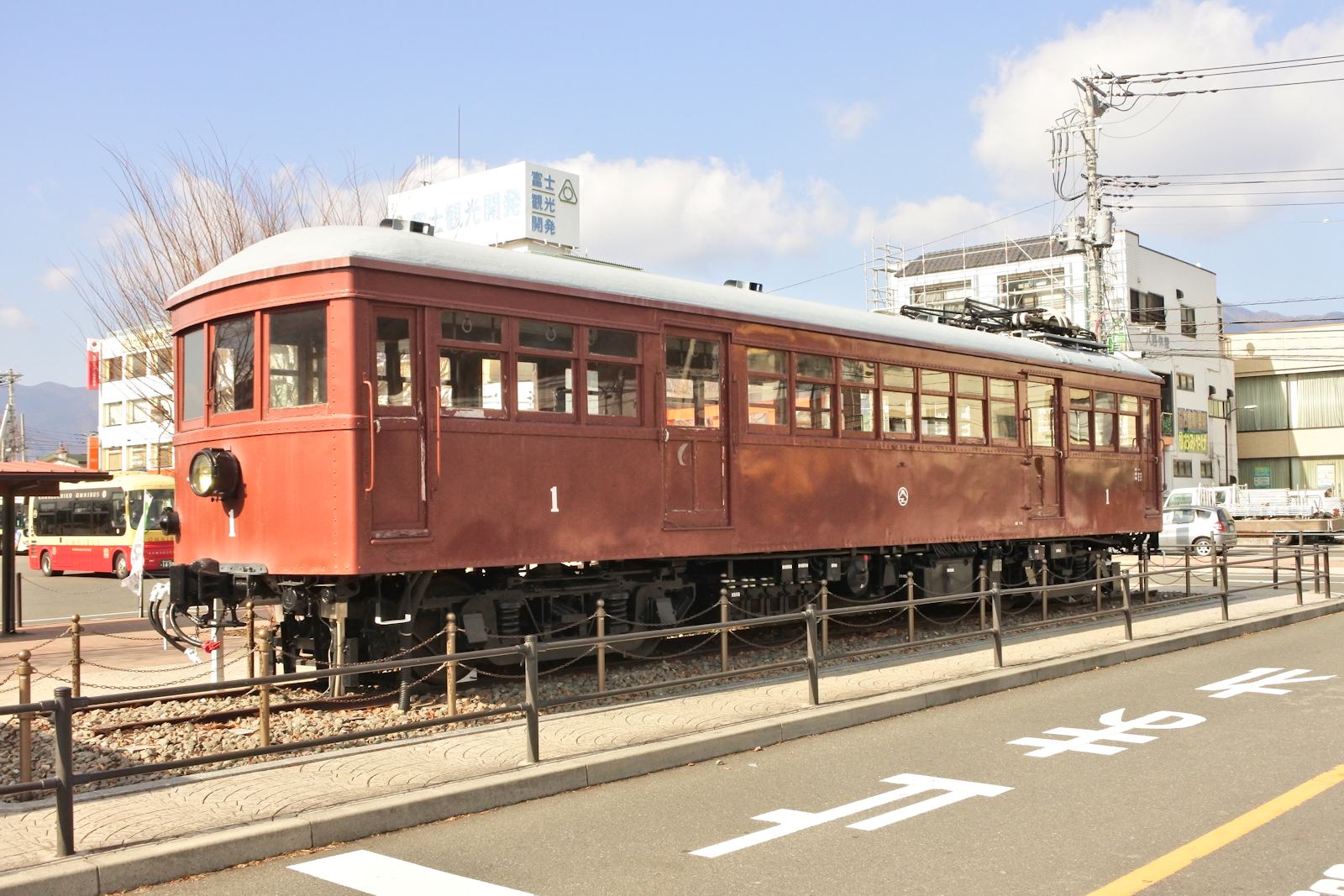
河口湖駅前の富士山麓電気鉄道モ1形を撮る
富士急行線の終着駅・河口湖駅へとやってきた。この駅の前には、富士急行の前身・富士山麓電気鉄道で活躍したモ1形車両1号車が展示されている。モ1形は、1929(昭和4)年の富士山麓電気鉄道線大月駅~富士吉田駅(現在の富士山駅)間開業に合わせて5両が製造された。車長15.24mの半鋼製車体(鉄と木材の両方を使って製造された車体)の車両で、40‰の急勾配対策として、発電ブレーキや砂まき装置を備えた。1号車は、この姿では1952(昭和27)年まで活躍した。新製した車体とモ1形の台車や床下機器類を再利用して、モ1形の改造車扱いでモハ500形が登場した。一方の車体は上田丸子電鉄(上田電鉄の前身)に譲渡され、別の車両で使われていた台車と床下機器を組み合わせてクハ250形251号車となり、のちに電動車化されて(モーターとパンタグラフが取り付けられて)モハ4250形4257号車となった。クハ251号車・モハ4257号車は1955(昭和30)年から1983(昭和58)年まで菅平鹿沢線(1960(昭和35)年に真田傍陽線に改称 1972(昭和47)年に廃線)と別所線で活躍した。引退後に古巣である富士急行に里帰りし、現在の河口湖駅前に静態保存されている。なお、富士山麓電気鉄道での現役時代は屋根にパンタグラフを2基搭載していたが、展示されている姿は上田丸子電鉄モハ4257号車時代に近い1基搭載となっている。I came to Kawaguchiko [Lake Kawaguchi] Station, the terminal of Fuji Kyuko Line.In front of the station, an old rail car, Mo 1, the first generation car of Fuji Sanroku Electric Railway (the predecessor of Fuji Kyuko) is displayed.Five cars of Mo 1 Series had been manufactured and debuted at the same time as the open of the section between Otsuki Station and Fuji-yoshida Station (present Mt. Fuji Station). It had 15.24-metre/50-foot long body made of both wood and steel and equipped generative brake and sander to accept the steep slope.In the original style, Mo 1 had been in service until 1952. Its bogies and machinery had been reused to newly-made Moha 500 (conversion of Mo 1 Series) Series. The body of 1 had been reused to Ueda Maruko Electric Railway (the predecessor of Ueda Electric Railway) and assembled into Kuha 251 together with bogies and machinery from the other car, which would have been converted Moha 4257 to equip motors.Kuha 251 or Moha 4257 had been in service on Sugadaira-shikazawa Line, which had been renamed to Sanada-soehi Line and closed in 1972, and Bessho Line from 1955 to 1983.After its retirement, Mo 1 had come back to Fuji Kyuko and started to display. The displayed car is similar to that after moving to Ueda Maruko Electric Railway lines, not the original style because of only one pantograph on its roof (in the original style two pantographs).
Jan 21, 2018
コメント(0)
-

「鉄道王」根津嘉一郎の実家を見る
東武鉄道の初代社長を務めるなど、明治から昭和年間にかけて数多くの鉄道事業者の経営に携わったことから、「鉄道王」と呼ばれる根津嘉一郎さんの実家である根津記念館を見学してきた。根津嘉一郎(1860 - 1940)さんは”甲州財閥”と呼ばれる明治時代に活躍した山梨県出身の実業家の1人で、業績が振るわなかった東武鉄道の経営再建に成功し、日本国内有数の大手民鉄へと成長させた。根津は実業家として、東武鉄道のほか、高野登山鉄道(南海高野線の前身)、武蔵電気鉄道(東急東横線の原型)、東京地下鉄道(東京メトロの前身)、東京馬車鉄道・東京市街鉄道・東京鉄道(以上3社東京都電の前身)などの合わせて24社の鉄道会社や、富国徴兵保険(現在の富国生命保険)、館林製粉(現在の日清製粉グループ本社)、日清紡などの企業の経営に携わった。また、自らの事業で得た儲けを社会にに還元すべきという考えのもと、自らの事業で得た儲けを地元に還元すべきという考えのもと、教育会にも進出し、武蔵大学の創設や、山梨県の学校へのピアノやオルガンの寄贈(これらは「根津ピアノ」「根津オルガン」と呼ばれ、記念館内にも数台が収蔵されている(すべて写真撮影不可))、JR東日本中央本線(中央東線)山梨市駅近くの笛吹川に掛かる根津橋の寄贈などに私財を投じた。根津さんの実家は甲州平等村(ひらしなむら)、現在の山梨県山梨市にある。記念館は根津の実家を保存・活用した施設で、旧主屋、青山荘、土蔵、展示棟と庭などから成り、根津さんの実業家人生や山梨での暮らしぶりに触れることができる。根津家は「油屋(あぶらや)」という屋号で雑穀商や質屋業を経営していた、地元の豪商であった。根津家邸宅は根津さんの関与の元、甥の根津啓吉さんにより、1932(昭和7)年から1935(昭和10)年にかけて整備され、故郷での「迎賓館」、大地主根津家の「地主経営の場」、「居住空間」としての機能を併せ持っていたと言われている。2003(平成15)年に根津家から山梨市へと寄贈され、2008(平成20)年10月に現在の根津記念館として一般に公開された。最初に展示棟で根津さんの生涯・功績についての常設展示を見た。山梨の地に生まれ、地方政治家を経て企業経営者、教育者となるまでの人生を、パネル展示を見ながら知ることができる。続いてメイン展示となる旧主屋、土蔵と青山荘へ。旧主屋は2階建てで、1933(昭和8)年に建設された。国の登録有形文化財に指定されている。近代和風なたたずまいの中に、コンクリート布基礎、ボイラー設備、屋内消火栓、電気配線など、当時の先端的な技術が盛り込まれている。旧主屋の2階の一室には、根津さんが東武鉄道の社長時代に使用していた机と椅子が展示されている。旧主屋の奥には土蔵が立っており、主屋とつながっている。土蔵も見学可能で、根津家に関する資料を展示している(写真撮影は不可)。青山荘は残された図面をもとに忠実に復元されたもの。応接室や広間の和室、茶の湯をもてなす茶室などで構成されている。応接室はもともと、神奈川県大磯町にあった根津さんの別荘にあった一室を移築したものだそうだ。青山荘の和室と面した縁側の窓からは、晴れていれば富士山も見ることができる。展示棟の資料によると、根津は東京の邸宅があった青山(現在の根津美術館)の地にちなんで「青山(せいざん)」という雅号を名乗り、茶人としても活動していた。根津の茶の湯仲間には、「逸翁」こと同じ山梨県出身の”甲州財閥”の一員で阪急電鉄創業者の小林一三さんや、東京急行電鉄初代社長の五島慶太さんなどもいた。記念館を訪れて、僕は根津家の暮らしがうかがい知れたと共に、昭和初期にタイムスリップして、根津家のお客様としてもてなされたような気持ちにもなった。そして展示棟の資料を通して、根津さんが経営に携わった企業の数の多さに改めて驚きを覚えたと共に、ピアノやオルガン、根津橋の寄贈など、根津の郷土愛に感動した。I also visited Kaichiro Nezu Memorial Museum, which uses his parents' house in Hirashina Village, present Yamanashi City, Yamanashi Prefecture.Kaichiro Nezu (1860 - 1940) is one of well-known Japanese businessperson during late 19th century early 20th century and had managed many companies, such as Tobu Railway, Koya Tozan Railway (predecessor of Nankai Koya Line), Musashi Electric Railway (Origin of Tokyu Toyoko Line), Tokyo Horse-drawn Streetcar, Tokyo Inner City Railway, Tokyo Railway (predecessor of Bureau of Tokyo Metropolitan Transportation Tramways), Tokyo Underground Railway (predecessor of Tokyo Metro Ginza Line), and totally 24 railway companies, and Fukoku Mutual Life Insurance Company, Tatebayashi Flouring Mill (present Nisshin Seifun Group), and Nisshinbo, and more. He also had a spirit that the earn from his own business were use to to society, from which he established Musashi University, presented pianos or organs to primary schools in Yamanashi Prefecture (the instruments are called "Nezu Piano" or "Nezu Organ" and some of them are exhibited in the museum (photographing all of them isn't allowed)), and put in his money to build Nezu bridge over Fuefuki River and near Yamanashi-shi Station on JR East Chuo Main Line (Chuo East Line).His parents had been business tycoon and had run pawnshop and dealt in grain. The museum had been designed by consists of main building, Seizan-so, Tsuchikura storehouse, exhibition hall, and garden, and you can learn his life as a businessman and feel that in Yamanashi.These houses are designed by his nephew, Keikichi Nezu, and Nezu himself and it is said that they functioned as not only the living space, but also the guest palace and the office as a landowner. The houses and land had been donated to Yamanashi City in 2003 and the museum opened on October 11th, 2008.First, I saw exhibition hall, where the diagrams and photographs showing his life regularly exhibited.The main building are two-storied Japanese-style house built in 1933 and designated as a National Cultural Asset. It equips concrete basement, boiler, indoor fire hydrant, and electric outlets, and tatami-matted rooms, kitchen with furnaces and basement pantry, and more rooms are laid out. His desk and chair he used when he had been the president of Tobu Railway are exhibited in a room on first/second floor. Tsuchikura storehouse stands over and the main building, in which the documents depicting Nezu family are exhibited (photographing isn't allowed).Seizan-so, which connects to the main building , is faithfully restored based on its original design and guests had been entertained at parlor in the building. Over the building, a tea-ceremony room are standing. The parlor in Seizan-so had been reconstructed from that of his second home in Oiso, Kanagawa Prefecture. According to the explanation in exhibition hall, he called himself "Seizan" after where he lived in Tokyo, Aoyama, Minato-ku, Nezu Museum is located in the present, when he used to be in the ceremony, and many businesspersons, such as Ichizo Kobayashi, the founder of Hankyu Railway and also coming from Yamanashi Prefecture, and Keita Goto, the first president of Tokyu Corporation, had spent time with him.While seeing the museum, I felt as if I slipped back in time to early Showa period when the buildings constructed and invited and entertained by him, and through the exhibits in exhibition hall, I was surprised at the number of the companies he had managed and moved his love to his hometown; he donated pianos or organs to primary schools (the instruments are called "Nezu Piano" or "Nezu Organ" and some of them are exhibited in the museum (photographing all of them isn't allowed)) and Nezu bridge over Fuefuki River and near Yamanashi-shi Station on JR East Chuo Main Line (Chuo East Line).参考文献 Reference根津記念館 パンフレット山梨市 根津記念館English guide of Nezu Memorial Museum
Jan 20, 2018
コメント(0)
-

超高速で駆け抜ける山梨リニア実験線を撮る
富士急行線を撮った次は、山梨県立リニア見学センターで試験走行中の山梨リニア実験線(リニア中央新幹線)を撮影。富士急行線禾生駅から歩いて15分ほど。坂道を上った丘の上にリニア見学センターと山梨リニア実験線の線路が見える。実験線は2027年にはリニア中央新幹線の一部となる。リニア見学センターは「わくわくやまなし館」と「どきどきリニア館」の2棟から成り、「わくわくやまなし館」ではリニアグッズや山梨県のお土産品などを販売と、山梨県の観光情報を発信し、「どきどきリニア館」では過去の試験走行に使われた超電導リニアの車両(MLX-0形)が展示されているほか、超電導リニアが走る仕組みを学習することができる。どちらとも3階に試験走行する超電導リニアの車両(L0系)を見ることができる。試験走行が順調に進んでいる場合には、ほぼ10分ごとに車両がリニア見学センターの前を通過するという。僕は「どきどきリニア館」3階の見学ラウンジから、500km/hという超高速での試験走行を繰り返す山梨リニア実験線を撮影することにした。試験走行中の車両がどこにいるかは見学ラウンジにあるディスプレイで知ることができるほか、車両がリニア見学センターにリニア見学センター近づく10秒前になると、スタッフの方が知らせてくれる。僕もこれを合図にカメラを構えた。そして、撮れた作品がこれである。将来の品川方となる上野原市方から名古屋・大阪方となる笛吹市方へと向かう車両を捕える。リニア中央新幹線は2027(令和9)年に開業予定。開業すると、品川駅~名古屋駅が40分、品川駅~新大阪駅間が1時間3分でつながる予定である。開業が待ち遠しい。After photographing Fuji Kyuko Line trains, I went to Yamanashi Prefectural maglev observation and exhibition centre to see and photograph maglev train in test running.It takes about 15 minutes from Kasei Station on Fuji Kyuko Line and it is located on a hill. It consists of two buildings standing along the test railway of maglev, one of which sells maglev goods and souvenirs in Yamanashi Prefecture and shows the tourist attractions in Yamanashi Prefecture, and the other shows how maglev train run and float including a real maglev car (MLX-0).Both buildings have observation rooms to watch the maglev train, from one of which I tried to photograph a maglev train running at about 500km per hour. I set aperture value of my camera in little number and fast shutter speed because of shooting over the window and the train's fast speed. A staff told visitors the train would soon come before about ten seconds. When I heard this announcement, I was ready to photograph.My photograph (the upper) was shot the train running from Uenohara City (Tokyo direction in the future) toward Fuefuki City (Nagoya and Osaka). The maglev train starts its regular operation between Shinagawa Station and Nagoya Station in 2027 and it takes just 40 minutes to connects the two stations and 1 hour and 3 minutes to do between Shinagawa Station and Shin-osaka Station.
Jan 20, 2018
コメント(0)
-

初めての富士急行線撮影
6000系元国鉄・JR東日本205系電車。205系は1985(昭和60)年に国鉄初のオールステンレス製車体の車両として、当初は山手線用として登場した。オールステンレス製車体のほか、ボルスタレス台車や国鉄が独自開発した界磁添加励磁制御(旧来の直流直巻整流子モーターを使用しながら、補助電源装置からモーターの界磁(モーター内部のコイルのうち回転するコイル(電機子)の外周に固定されたもの)と主回路と呼ばれるメインの電気系統から別れた、モーターの界磁と並列につながれた界磁に流れる電流量を調節する誘導分路と呼ばれる回路との間を循環する、誘導分路においてはパンタグラフからモーターを介して線路へと流れる電流とは逆向きの電流を流し、その電流量を変えることで界磁の磁力を制御し、モーターの回転、すなわち電車の速度をコントロールする方式。201系で採用した電機子チョッパ制御よりも低コストで製造できること、減速時にモーターの回転によって発生した電気を架線に返す回生ブレーキが使用できるメリットがある)も初採用された。2011(平成23)年から2012(平成24)年にかけて3両編成4本が譲渡され、2012(平成24)年2月29日より営業運転を開始した。上の写真は1985(昭和60)年に製造された側窓が「田」の字型の下段上昇・上段下降式の量産先行車のヤテ2→ケヨ25編成の6001F。下は1985(昭和60)年に製造された量産車のヤテ11→ケヨ22編成の6501F。共に国鉄・JR東日本時代は山手線と京葉線で活躍した。(上)東桂駅にて、(下)都留文科大学前駅にて6000 Series moved from JR East and renamed from 205 Series. 205 Series had been in service in 1985. It was first Japan National Railway (JNR) car made by stainless steel and equipped bolsterless bogies and superimposed field excitation control system; classical series-wound motor and resistance unit are equipped, but a loop of current circulating around magnetic generator via circuit in parallel with field coils of motors and the field coils and flowing in a direction reverse to that from pantograph to railway in the parallel circuit and field coils to control the amperage of the coils, and has a merit to equip regenerative brake.Four 3-car sets are existed and all of those had been in service on Yamanote Line and Keiyo Line while they used to belonged to JR East.The cars in upper photograph is 6001F set (Yate 2, when in service on Yamanote Line, Keyo 25, when on Keiyo Line) equipping double hung window at Higashi-katsura Station, and that in lower ones is 6501F (Yate 11, when in service on Yamanote Line, Keyo 22, when on Keiyo Line) having sashless vertical sliding window from the platoform of Tsuru-bunka-daigaku-mae [Tsuru University] Station.参考:京葉線を走る205系ケヨ25編成 Keyo 25 set on Keiyo Line8500系元JR東海371系電車。1991(平成3)年に新宿駅~沼津駅間を小田急小田原線・JR東海御殿場線経由の特急「あさぎり」用車両として登場した。製造されたのはたった1編成のみの貴重な車両でもあった。JR東海時代は7両編成を組み、このうち3・4号車(沼津方から3・4両目)にあたるサロハ371は2階建て車両であった。国鉄・JR東日本205系から続く界磁添加励磁制御を採用。2012(平成24)年に「あさぎり」としての運行を終了し、それ以降は臨時列車・イベント列車として運行された。2014(平成26)年に臨時列車・イベント列車としても役目を終え、平床車両3両が富士急行に譲渡された。富士急行では水戸岡鋭治さんの手によるリニューアルを施され、「富士山ビュー特急」の列車名を与えられた。禾生駅~赤坂駅間にて8500 Series, moved from JR Central and used to be named 371 Series, started to be in service as "Fujisan View Express" in 2016. 371 Series debuted in 1991 and had been in service as "Asagiri" limited express between Shinjuku Station on Odakyu Odawara Line and Numazu Station on JR Central Gotemba Line until 2012. Only one 7-car set was manufactured and two double-deckers, Saroha 371, used to be coupled at third and forth car when the train ran toward Numazu. The cars introduced the same control system as Japan National Railway and JR East 205 Series. From 2012 to 2014, 371 Series had also been in service as special train for events. After moving of three regular-floor cars to Fuji Kyuko, the exterior and interior of those cars were refurbished by Eiji Mitooka, who is also famous the designer of JR Kyushu 800 Series Shinkansen or 77 Series passenger car "Seven Stars in Kyushu".The photograph was shot between Kasei Station and Akasaka Station.参考:小田急小田原線を走るJR東海371系 371 Series on Odakyu Odawara LineJR東日本189系1975(昭和50)年、上野駅~長野駅・直江津駅の特急「あさま」用に、EF63形電気機関車2両を連結しての信越本線横川駅~軽井沢駅間の碓氷峠越え対策(横軽対策)を施した特急型車両として登場。富士急行線へは中央本線(中央東線)からの新宿駅~河口湖駅間を運行する臨時快速列車「ホリデー快速富士山」として土休日に運行されている。上はJR最後の国鉄特急色を纏う編成となったM51編成。下はこの日(1月20日)に富士急行線でのラストランを迎えた「あずさ」色のM50編成。(上)三つ峠駅にて 大月行き列車車内最前部から、(下)谷村町駅にて 大月行き列車車内最前部からJR East 189 Series, debuted in 1975 as the car for "Asama" limited express between Ueno Stataion and Nagano Station or Naoetsu Station and at first dedicated to steep slope on Shinetsu Main Line between Yokokawa Station and Karuizawa Station coupled with two Class EF63 electric locomotives, also go through Fuji Kyuko Line as "Holiday Rapid Mt.Fuji" on Saturdays, Sundays, and Japanese national holidays. The one in upper photograph is M51 cream-and-red-coloured (livery of traditional JNR limited express train) set shot at Mitsutoge Station over the front window of the train toward Otsuki, and the one in lower is M50 white-and-blue-coloured (livery of "Azusa" limited express after the privatization of JNR) set, which operated on Fuji Kyuko Line last time on that day, shot at Yamuramachi Station over the front window of the train toward Otsuki.
Jan 20, 2018
コメント(0)
-

京王5000系に乗る
E353系撮影後は高尾山口駅へ向かい、京王高尾線・京王線へ。2017(平成29)年にデビューした京王5000系電車に初乗車した。2017(平成29)年11月3日に撮影した京王5000系電車 Keio 5000 Series photographed on November 3rd, 2017今回乗車したのは京王八王子駅から京王線新宿駅まで。車両は5734F。車内は白色の壁を基調としながらも、床はベージュ色と木目柄の入ったこげ茶色、荷棚通路寄りと側扉横の手すり部分は茶色、座席仕切り板は茶色がかった灰色の木目柄、側扉上のトレインビジョン周りは黄金色、荷棚上はトレインビジョン周りに近い黄色がかったクリーム色が使われている。座席は側扉間が2人がけのロング・クロス転換シートが3組並んだ6人がけ、車端部は3人がけのロングシートとなっている。背もたれ上部が赤みがかったこげ茶色、背もたれ下部から座面にかけて灰色の生地、ヘッドレストはやや薄めの黒色。座席のこげ茶色は高尾山の木々を、灰色は繊維の街・八王子の絹糸をイメージしたもの。トレインビジョンは17インチのものが2画面配置され、左側が京王電鉄のCMを放映する広告用、右側が次駅・乗り換え・所要時間・側扉開閉を知らせる案内用。案内用のトレインビジョンの表示は、京王線にも乗り入れる東京都交通局10-300形電車(10-491F以降の編成)やJR東日本E233系電車(埼京線用の7000番台車両)、東急4000系電車のものに似たアニメーション付き表示。クロスシートとなる座席指定列車運用時にも乗客が見やすいように、天井にも枕木方向に取り付けられている。空気清浄機はパナソニックの「ナノイー」の技術を導入している。実際に乗車してみた感想としては、落ち着きの中に上品さ、高級感を併せ持つ印象を与える色使いの車内空間、静かな加減速時のVVVF音や側扉の開閉音、各停列車で京王八王子駅から京王線新宿駅までの長時間(乗車時間約80分)乗っていても疲れにくい座席、「ナノイー」によって清浄された車内の空気。京王電鉄初の座席指定列車にふさわしい車両であると評価したい。After photographing E353 Series, I travelled with Keio 5000 Series, debuted in 2017, first time from Keio-Hachioji Station to Keio Line Shinjuku Station. The set I rode on was 5734F set.Riding on the train, its interior is based on white-coloured wall, its floor is beige and dark brown wood-grain, its aisle-side half of luggage rack and both side of passenger doors are brown, end plate of seating areas are brownish gray wood-grain, around LCD visions above the doors are gold, and above the luggage rack is cream matching the gold.Three seatings for two are laid out between two doors and the colours of seatings are brown (upper of backrest), coming from forest in Mt. Takao, and gray (lower of backrest and face)-coloured, from silken threads made in Hachioji. They also have black-coloured headrests.Two LCDs, one of which on the right shows information about stations, time, transfer lines, and suspension or delay of railway lines with animated letters and pictures like those of Bureau of Tokyo Metropolitan Transportation 10-300 Series (models after 10-491F set), JR East E233 Series (on Saikyo Line), and Tokyu Corporation 5050-4000 Series, and another does commercial movies of Keio Corporation, hang from ceiling to make passengers see easily when the seatings turned forward-facing transverse layout as the reserved-seat train from March, 2018, as well as those laid out above the doors.It also equips air purifiers using "nanoe" technology produced by Panasonic.I felt its interior looks soft but luxurious because of the colours and appreciate the interior and equipment, such as silent variable-frequency drive and doors, stress-free seatings 1-hour-and-20-minute travel as local train between Keio-Hachioji Station and Keio Line Shinjuku Station, and purified air, suitable for the first fast and reserved-seat train for Keio Corporation.密着!京王電鉄 新型5000系 新形式誕生の記録/試運転前面展望【大島車両検修場〜新宿〜高幡不動検車区】【Blu-ray】 [ (鉄道) ]※新製品 5月発売※ 京王5000系(座席指定列車) 基本6両編成セット(動力付き) 【グリーンマックス・30728】「鉄道模型 Nゲージ GREENMAX」
Jan 3, 2018
コメント(0)
-
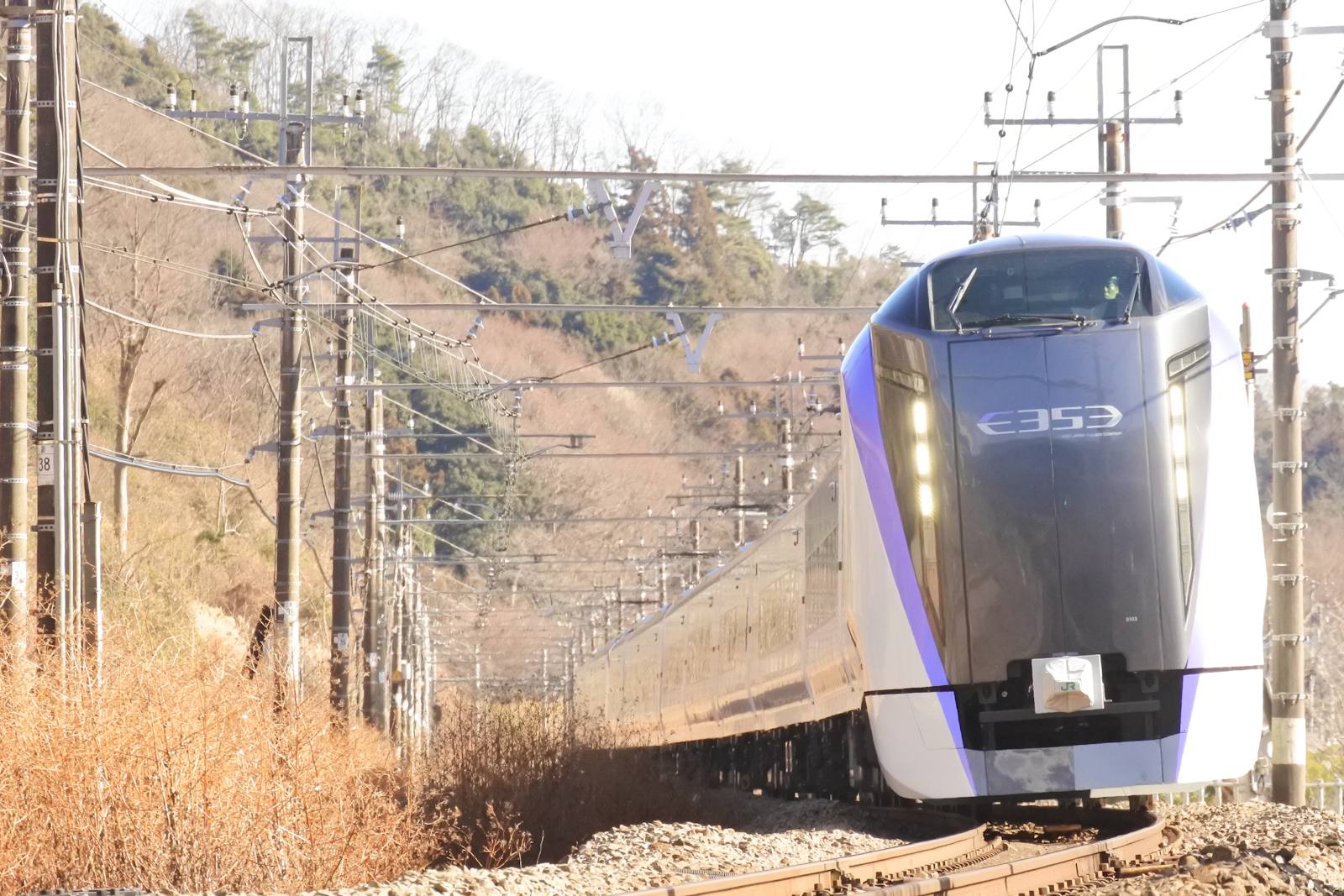
2018年初撮影はE353系
2018(平成30)年の撮り始めは、2017(平成29)年12月23日にデビューしたばかりのJR東日本E353系電車。撮影場所は中央東線高尾駅~相模湖駅間の新井踏切。空気バネ式車体傾斜機能付き台車を履くE353系らしく、カーブで車体を傾けている姿を撮ろうとこの場所を選んだ。E353系はカーブ通過時に、最大でわずか1.5°だが台車の空気バネの力により車体が線路の中心よりもカーブ内側に傾いている。写真でもカーブ上にいる先頭車両がカーブ内側(写真向かって左側)に傾いている。空気バネ式車体傾斜装置の導入は、JR東日本の車両ではE5系新幹線、E6系新幹線に次いで3例目、在来線の車両では初めての採用である。中央東線の「あずさ」「かいじ」系統においては2001(平成13)年に登場したE257系以来16年ぶりの新型車両であるE353系は今後、2018(平成30)年3月17日のダイヤ改正で「スーパーあずさ」の全列車を受け持つようになるほか、さらなる増備が予定され、今後2年以内をめどに「あずさ」「かいじ」の運用にも就き、中央東線で定期運行される特急列車の全列車を受け持つとみられている。The target of my first photographing in 2018 is E353 Series, debuted in December 23rd, 2017.Where I photographed was Arai crossing between Takao Station and Sagamiko Station on Chuo Main Line (Chuo East Line) to shoot when the train running on curve and tilting its body.E353 Series introduces pneumatic tilting to run at faster speed without worsening of passengers' comfort on curve. Among JR East railway cars except Shinkansen, it is first time to introduce pneumatic tiling.E353 is planning to operate on all trains of "Super Azusa" limited express on Chuo East Line from March 17th, 2018, and to be manufactured more sets for "Azusa" limited express and "Kaiji" limited express. Within two years, all regular limited express trains would be operated by E353 Series.
Jan 3, 2018
コメント(0)
-
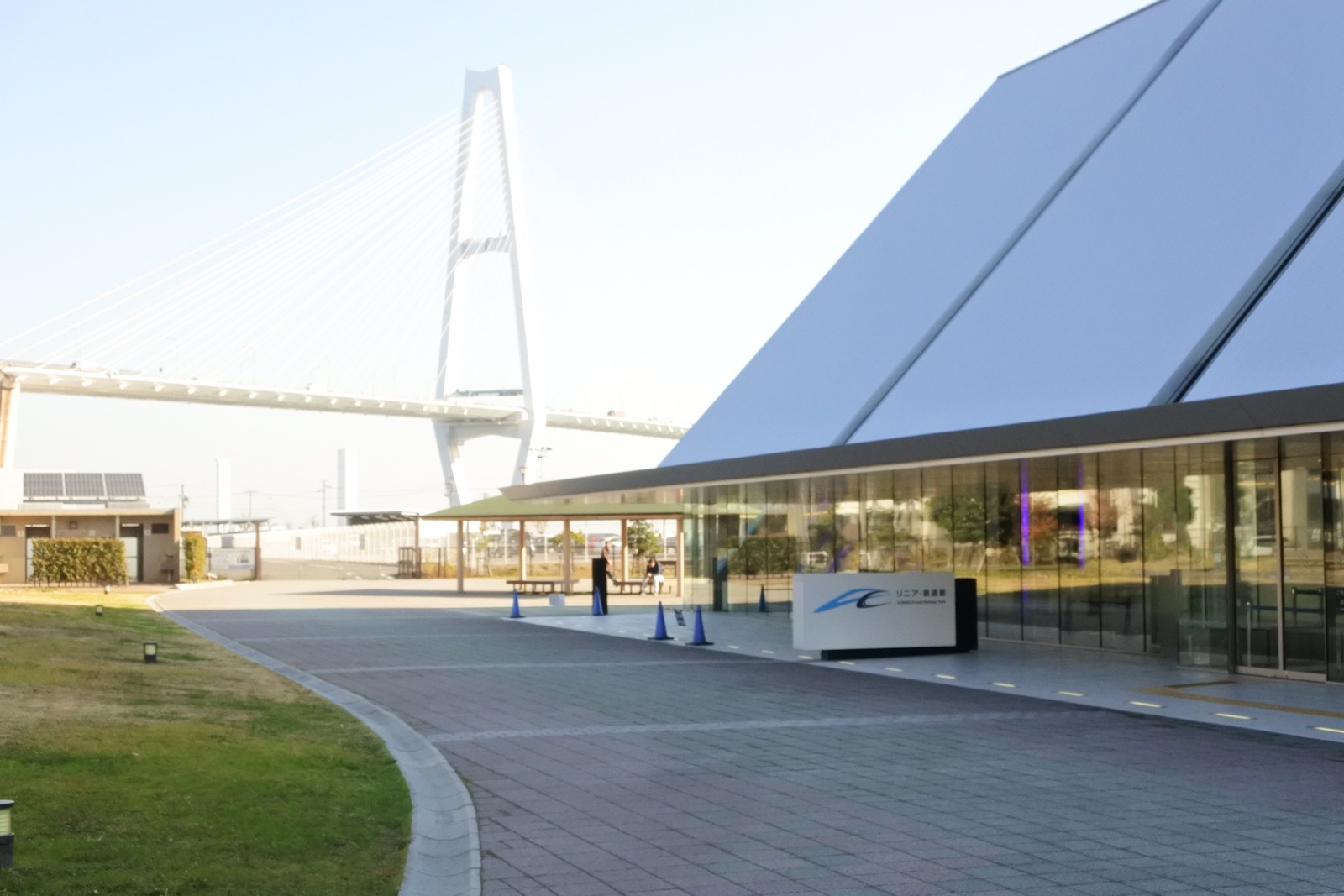
リニア・鉄道館を見る
今回の旅の最後の楽しみは、リニア・鉄道館。名古屋臨海高速鉄道あおなみ線の終点・金城ふ頭駅の目と鼻の先にあるリニア・鉄道館は「鉄道の高速化」に着目したJR東海が手掛ける鉄道ミュージアムで、2011(平成23)年3月14日に開館した。蒸気機関車から電車・気動車、新幹線、さらにはリニアモーターカー(マグレブ)へと進化を遂げている日本の鉄道をメインテーマに、実物の車両や模型などを展示している。エントランスを通り抜けてシンボル展示の3両、C62形蒸気機関車、955形新幹線「300X」、リニア試験車両MLX-01形がお出迎え。C62形蒸気機関車1949(昭和24)年から1964(昭和39)年にかけて、「つばめ」などの東海道本線・山陽本線の特急列車を牽引した蒸気機関車。展示されている17号機は、1954(昭和29)年に東海道本線木曽川橋梁において狭軌(1,067mm軌間)路線を走る蒸気機関車としては世界最高速度である129km/hを記録した車両。955形新幹線「300X」1994(平成6)年から2002(平成14)年まで在籍していた東海道新幹線の試験車両。高速化に向けての様々な試験走行が約600回実施され、700系やN700系の設計に反映された。1996(平成8)年に東海道新幹線の試験車両としては最速である443km/hを記録した。MLX-01形1995(平成7)年に登場した山梨リニア実験線の試験車両。2003(平成15)年に当時の鉄道車両最速のスピードである581km/hを記録した。2005(平成17)年に開催された万国博覧会(2005年日本国際博覧会「愛・地球博」)会場内のJR東海超電導リニア館に展示された。そしてメインの車両展示ゾーンへ移動。JR東海に在籍していた0系、100系、300系、700系、922形の新幹線車両5車種と、在来線の高速化に貢献した車両と佐久間レールパークから移設された車両を中心に、通常展示・所蔵(車内見学不可)展示合わせて32両が展示されている。まずは在来線車両から。ホジ6005形蒸気動車1913(大正2)年に製造された、先頭の機関室に小型の蒸気機関を積み、今日の普通車にあたる三等客室をつなぎ合わせた、蒸気機関車と客車を1両にまとめたような構造をした車両。この蒸気動車が後にガソリンエンジンやディーゼルエンジン付きの気動車へと発展する礎となった。このホジ6005形車両が現存する唯一の蒸気動車であり、鉄道記念物にも指定された大変貴重な存在である。111・113系電車1962(昭和37)年に登場した近郊型電車。東海道本線の「湘南電車」区間における80系の後継車両として製造された。111系の改良型でモーター出力を向上させた113系と共に、80系に次ぐ第2世代の東海道本線「湘南電車」区間(国鉄時代は主に東京駅~沼津駅間)の主力車両として、JR東日本区間では2006(平成18)年まで、JR東海区間では2007(平成19)年まで活躍した(参考:2006(平成18)年に撮影した東海道本線の1113系電車)。翌1963(昭和38)年に製造が113系へと移行されてからも、先頭車両はクハ111形が付番された。JR東日本・JR東海の車両は全廃、JR西日本に残る車両も塗色変更により2017(平成29)年に姿を消したことから、ここリニア・鉄道館に展示されている車両が貴重なみかん色(黄かん色)1号と緑色(緑2号)の伝統的な湘南色で残る車両だと言える。車体側面には「静岡⇔東京」と書かれたサボが差し込まれていた。僕の子供時代はサボではなく幕式の行き先表示に変わっていたが、沼津行きや静岡行きなどJR東日本区間からJR東海区間へ直通運転する列車が多数運行されていた。2004(平成16)年10月のダイヤ改正で東京駅始発列車の大半が熱海行きのJR東日本区間で完結する運用となり、JR東海区間への直通列車は沼津行きが数本残されただけとなった。キハ181系気動車1968(昭和43)年、中央西線の特急「しなの」でデビュー。先に登場していたキハ80系の欠点を克服するために走行用エンジンの大出力化などの改良が施された。中央西線電化後は北近畿・山陰・四国地区の各特急列車で活躍した。2010(平成22)年に特急「はまかぜ」として運行されていた車両が引退したことで全廃となった。残念ながら僕は現役時代にその姿を見ることができずに終わってしまったことから、リニア・鉄道館でその姿を一目見たかった。モハ52系電車東海道本線京都駅~神戸駅間と山陽本線神戸駅~西明石駅間(京阪神緩行線 民営化後のJR京都線・JR神戸線区間)の急行列車(関西急電 現在の快速列車および新快速列車にあたる)用車両として製造された。展示されているモハ52004号車は1937(昭和12)年に製造された。流線形・半楕円形4枚窓の前面が特徴で「流電」の愛称で呼ばれた。381系電車1973(昭和48)年、中央西線全線電化に伴って特急「しなの」に投入された。国鉄初のカーブ走行時に車体をカーブ内側へ傾ける振り子式台車を採用し、高速化と乗り心地の向上に貢献した。後に紀勢本線の特急「くろしお」、伯備線の特急「やくも」、福知山線の特急「こうのとり」にも投入されたが、「しなの」からは2008(平成20)年に、「くろしお」「こうのとり」からは2015(平成27)年に引退し、2017(平成29)年現在は「やくも」が381系によって定期運行されている唯一の特急列車である(参考:2016(平成28)年に撮影した381系「やくも」)。C57形蒸気機関車1937(昭和12)年から1975(昭和50)年にかけて四国を除く日本各地の旅客列車を牽引した。展示されている139号機はお召し列車の牽引にも使用されたたもので、お召し列車の装飾を復元している。EF58形電気機関車1952(昭和27)年から2008(平成20)年にかけて活躍した、主に旅客列車を牽引した電気機関車。「つばめ」「はと」「あさかぜ」などの東海道本線・山陽本線の旅客列車を牽引し、また民営化後もイベント列車やお召し列車の牽引機として活躍した。展示されている157号機は1985(昭和60)年に現役を引退し、一度国鉄清算事業団に引き取られたが、1988(昭和63)年にJR東海が購入した。2007(平成19)年までの間イベント列車を牽引してきた。ED11形電気機関車ED18形電気機関車ED11形・ED18形ともに1925(大正14)年の東海道本線東京駅~国府津駅間電化に備えて1923(大正12)年に輸入された電気機関車。ED11形はアメリカ合衆国から、ED18形はED50形としてイギリスから日本へやってきた。モハ1形電車展示されている1035号車は鉄道省時代にデハ33500系33509号車として1922(大正11)年に製造され、京浜線(現在のJR東日本京浜東北線)で活躍した。後に三信鉄道(現在のJR東海飯田線三河川合駅~天竜峡駅間の前身)と大井川鐵道に移籍し、1970(昭和45)年まで活躍した。車両のEF58形電気機関車寄りに展示されている腕木式信号機とともに撮影。車両展示ゾーン奥に収蔵展示されている車両にも印象的な車両がいた。オヤ31形建築限界測定車車体側面に取り付けられた矢羽根を広げて、走行しながら建築限界(車両を安全に通行させるために、信号機や標識などを設置してはいけない空間)が保たれていて、列車が安全に走行できるかを計測する車両。矢羽根を広げた姿がかんざしを挿した花魁に似ていることから「おいらん車」と呼ばれる。165系電車1963(昭和38)年に登場した国鉄を代表する急行型車両の1つ。1958(昭和33)年に登場した153系電車を基本に、寒冷地や山岳区間でも運行が可能な仕様に改良された。飯田線の特急列車「伊那路」の前身である臨時急行列車「伊那路」は1992(平成4)年から1996(平成8)年の特急「伊那路」登場まで運行された。このほかJR東海の路線では、東海道本線の急行「東海」、御殿場線の急行「ごてんば」、身延線の急行「富士川」「みのぶ」、飯田線の急行「天竜」「かもしか」「こまがね」などとして活躍した。キハ80系気動車キハ181系と共に国鉄時代を代表する特急型気動車。1960(昭和35)年に登場したボンネット型の先頭車両キハ81形(京都鉄道博物館にて展示中)に続いて1961(昭和36)年に貫通型の先頭車両キハ82形が登場した。展示されている車両は名古屋駅~高山駅・飛騨古川駅・富山駅間を走る高山本線の特急列車「ひだ」のヘッドマークを掲げている。キハ85系気動車への置き換えが完了した1990(平成2)年まで「ひだ」として運行されていた。続いて新幹線の車両たちへ。0系新幹線ご存知1964(昭和39)年から2008(平成20)年(東海道新幹線では1999(平成11)年)にかけて、東海道・山陽新幹線で活躍した初代新幹線車両。世界初の200km/h超のスピードでの営業運転を実現させた鉄道車両であり、運行当初は「夢の超特急」と呼ばれた。東京駅~博多駅間の所要時間は、2017(平成29)年3月のダイヤにおけるN700系で運行される「のぞみ」で約5時間であるが、1975(昭和50)年、0系で運行されていた「ひかり」が主力の岡山駅~博多駅間開業当時は約7時間を要した。博多駅開業時から、軽食主体のビュッフェ車に加えて、しっかりとした食事ができる食堂車の連結が始まった。100系新幹線1985(昭和60)年に登場した東海道・山陽新幹線の2代目車両。速さだけを売りにしていた新幹線に、2階建て車両の連結などで乗る楽しみを新たに創り出した車両と言われ、2012(平成24)年(東海道新幹線では2003(平成15)年)まで活躍した。この日は100系新幹線の運転席に座れる特別な期間中だった。もちろん僕も見てきた。リニア・鉄道館では先頭車両のほか、2階建て食堂車も展示されている。写真は食堂車の2階客室。1階が厨房と通り抜け通路があり、食堂車に用事がない乗客は1階の通路を通る。厨房から2階の食堂へは専用のエレベーターを使って運ばれてきた。300系新幹線1992(平成4)年から2012(平成24)年にかけて活躍した東海道・山陽新幹線の第3世代車両。0系・100系では220km/hだった最高速度が270km/hと大幅に向上し、同年より新設された「のぞみ」として運行され、東京駅~新大阪駅間を2時間30分で走破していた。東海道・山陽新幹線の車両では初めてのアルミ合金製車体で、VVVF制御を採用し、高速化と共に車体の軽量化や最新技術の導入により、省電力化も実現させた車両である。700系新幹線1999(平成11)年に登場した東海道・山陽新幹線の第5世代車両。東海道・山陽新幹線の車両としては初めて、両線を管轄するJR東海とJR西日本が共同開発した車両。JR西日本が開発した500系車両が、山陽新幹線での最高時速300km/h運転を実現させた一方で、車内の居住性や運用面での問題点があったことを反省し、高速で運行することよりも、500系よりも車内の居心地を向上させると共に300系車両と同じ定員を確保した車両として登場した。500系車両の長いノーズと同レベルの騒音対策効果がある短いノーズとして「エアロストリーム」形と呼ばれるカモノハシのくちばしに似たノーズを採用した。展示されている新幹線車両のうち、300系と700系は、毎時0分、20分、40分に車内で自動放送を聴くことができる。300系では「旧のぞみチャイム」(始発・終着用は2017(平成29)年現在東海道新幹線東京駅の発車メロディとして使用中)から始まる2003(平成15)年当時のもの、700系では現行の「AMBITIOUS JAPAN!」から始まる2013(平成25)年当時のものが再生される。922形新幹線「ドクターイエロー」新幹線の線路、架線などの状態を走行しながら検測する車両。展示されている車両は1979(昭和54)年に製造された第3編成の先頭車、922-26号車。民営化後はJR東海ではなくJR西日本に引き継がれたが、2011(平成23)年よりリニア・鉄道館に展示されている。「ドクターイエロー」の車内では、新幹線の保守・検査を題材にした短編映画を上映していた。さらに屋外にも車両も2車種4両が展示されている。117系電車1979(昭和54)年に東海道本線・山陽本線の新快速列車用車両として登場した。1982(昭和57)年より東海道本線名古屋地区の快速列車としても投入され、名古屋地区では「東海ライナー」という愛称で呼ばれた。311系・313系の登場後は普通列車主体で、2013(平成25)年まで活躍した。登場当時のクリーム色(クリーム1号)地にマルーン色(ぶどう色2号)の帯が入った塗装で、3両編成で展示されている。車内での飲食が可能。ケ90形(東濃鉄道A形)蒸気機関車大正から昭和初期に、JR東海太多線の前身である東濃鉄道で活躍した蒸気機関車。東濃鉄道は762mm軌間の軽便鉄道であった。実物の車両の次は、近年鉄道博物館では欠かせない存在となっている模型列車のジオラマを見る。リニア・鉄道館のジオラマの特徴といえば、東海道新幹線を中心に、JR東海各線の沿線の街のシンボルといえる建造物(JR東海セントラルタワーズ、東京駅、東京タワー、清水寺、道頓堀川、白川郷の合掌造りの家など)を点在させていることと、花火大会や京都五山の送り火などの華やかな夜間の演出が用意されていること、終電後の検測・保線の演出も用意されていることなどが挙げられる。また、さいたまの鉄道博物館や京都鉄道博物館のものが全面ガラス張りだったのに対し、リニア・鉄道館のものは仕切りが腰の高さ程度までしかなく、写真も撮りやすくなっていること。ジオラマ全体像富士山(イラスト)を背景にN700系新幹線と313系電車が走る富士山(イラスト)の手前にはリニア中央新幹線のL0系も超高速で駆け抜けていくキハ40系気動車と白川郷の合掌造りの家々国鉄色のキハ58系気動車が参宮線を模した線路を走る名古屋駅を中心に夜景のジオラマ花火大会や京都五山の送り火の演出も月明かりに照らされて保線作業車が作業中このほか、僕は在来線シミュレーターと超電導リニア展示室、歴史展示室を見学してきた。在来線シミュレーターは、運転シミュレーターと車掌シミュレーターの2種類があり、運転シミュレーターは先着順、車掌シミュレーターは抽選で選ばれた人だけが体験でき、パンフレットに付いている抽選券を切り取り、館内の応募箱に入れて申し込む。いずれも追加料金が必要で、運転シミュレーターは100円、車掌シミュレーターは500円である。運転シミュレーターは211系の運転席を模したものと313系の運転席を模したものの2種類があり、僕が体験したのは、211系のものだった。運転席の目の前のディスプレイには3DCGで描かれた架空の路線が映し出され、コースによって違うが、その路線を2~3駅間運転することができる。僕が選んだコースは2番目に難しい練習コースの路線。もちろん運行ダイヤが設定されていて、そのダイヤから2分遅れてしまうと運転が強制終了となる。僕が運転した列車は、30秒の遅れが出てしまったものの、終点の駅まで運転することができた。車掌シミュレーターにも応募したのだが、なんと当選した。運転シミュレーターの奥に実物大の313系の乗務員室が再現され、ドアの開閉から運転士さんへの発車の合図を送り、車内放送をするという、車内で車掌さんが行う一連の業務を体験できるもの。超電導リニア展示室では、リニア中央新幹線の車両を模したミニシアターでの乗車シミュレーションや超電導リニアが走る仕組みを模型で解説している。歴史展示室では、東海道本線・東海道新幹線を中心に鉄道の発達や新幹線の開通に至るまでの歴史、新幹線開通後までを、写真・模型・イラストなどを使って解説している。初めてリニア・鉄道館を見た僕の感想としては、意外な車両たちとの出会いや、車両の魅力、鉄道の進歩について改めて気付けた。車両展示ではホジ6005形のような蒸気機関車と客車をつなぎ合わせたような車両が存在していたことや、残念ながら現役時代に見ることや乗ることができなかった100系新幹線やキハ181系気動車、僕にとっては思い出深い111・113系電車やMLX-01形に久しぶりに出会えたこと、0系新幹線や100系新幹線の食堂車の様子が食品サンプルと運行当時のメニューからうかがい知ることができたこと、100系新幹線の運転席に入れたこと、今なお現役の700系新幹線の「エアロストリーム」形のノーズの迫力に驚いたことが特に印象的だった。車両展示以外では、車掌シミュレーターとリニア中央新幹線の乗車シミュレーションが思い出となった。車掌シミュレーターはまさか僕が当選するとは思ってもいなかった。アナウンスにはあらかじめ台本が用意されていたが、僕は台本にはない実際の車掌さんがアナウンスしていたものも織り交ぜてみた。リニアモーターカーの乗車シミュレーションは座席前のスクリーンに映し出された前面展望ももちろんだが、座席横の窓に映し出された風景もそれにシンクロして動いているから、リアリティも満点だった。そしてタイヤ走行から浮上走行に移る時の、タイヤが回転する音が車内に聞こえなくなる瞬間が、これから500km/hへと加速していくワクワク感を覚えた。The last attraction of my travel was SCMAGLEV and Railway Park in Nagoya, which is located near Kinjo-futo Station on Nagoya Rinkai Rapid Transit Aonami Line and a museum featuring development of railway's speed-up; from steam locomotive to electric or diesel train, Shinkansen, and maglev.Entering the museum, three symbolic cars, Class C62 steam locomotive, which recorded the highest speed (129km/80.2mi per hour) on 1,067mm/42.0in gauge railway in 1954, 955 Series Shinkansen "300X", which recorded the highest speed (443km/275.3mi per hour) on Shinkansen in 1996, and MLX-01 maglev train, which recorded the highest speed (581km/361.0mi per hour) in 2003 and exhibited at EXPO 2005.I walked over to Great Rolling Stock Hall, where lots of 1,067mm/42.0in gauge rail cars and five Shinkansen (1,435mm/56.5in standard gauge) cars , totally 32 cars, are exhibited.The cars which gave an impact on me were Hoji 6005 steam-engine-equipped passenger car, having been made the first step in developing gasoline or diesel cars, Moha 52 Series, used to be in service as express trains (predecessor of rapid or special rapid trains) on Tokaido Main Line and Sanyo Main Line in Osaka area, and Oya 31 clearance car, which is called "oiran car" because its physical feelers in being unfolded looks like hairpins which used to be worn by oiran courtesan.Those which I had longed to see were 111 and 113 Series, having been in service on Tokaido Main Line until 2006 (in JR East area) or 2007 (in JR Central area), Kiha 80 Series, having been the first diesel train for limited express trains and had been in service as "Hida" limited express, Kiha 181 Series, designed to improve lacks of specification of Kiha 80 Series and in service as limited express trains on unelectrified lines such as "Shinano" on Chuo West Line before electrified, 165 Series, in service as express trains on Tokaido Main Line, Chuo West Line, Minobu Line, Iida Line, 381 Series, which first introduce pendulum-type passive tilting for speed-up without worsening of passengers' comfort.I also watched and photographed Class C57 steam locomotive, having been in service all over Japan except Shikoku and the exhibited one had hauled the trains for Imperial Family, Moha 1 Series, in service on Keihin Line (present JR East Keihin-tohoku Line), Sanshin Railway (predecessor of a part of Iida Line between Mikawa-kawai Station and Tenryukyo Station), and Oigawa Railway Oigawa Main Line from 1922 to 1970, Class EF58 electric locomotive, having hauled limited express trains on Tokaido Main Line and Sanyo Main Line such as "Tsubame" "Hato" and "Asakaze", etc., Class ED11 and ED18 electric locomotive, both of which had been introduced to prepare for electrification of Tokaido Main Line between Tokyo Station and Kozu Station.All of five Shinkansen were also attractive to me. 0 Series, the first generation Shinkansen car having been in service from 1964 to 2008, 100 Series, the second generation in service from 1985 to 2012 and coupled two or four double-deckers, 300 Series, the third generation in service from 1992 to 2012 and realised to improve its speed up to 270km/167.8mi per hour on its regular operation as "Nozomi" super express, 700 Series, the fifth generation in service from 1999 to the present and introducing characteristic nose looking like platypus's beak called "Aero Stream", and 922 Series "Doctor Yellow", for inspection of railway infrastructures while running.Though only front car of 300 Series and 700 Series are exhibited, some kinds car of 0 Series and 100 Series, front car and dining car, are. Moreover, Green Car (second class seating) and buffet car of 0 Series are also (the two are off-limits).On that day, a special event that visitors could see driver's cab of 100 Series Shinkansen was held.More two kinds of cars are exhibited outside; 117 Series, used to be in service as rapid trains on Tokaido Main Line mainly around Nagoya Station until 2013, and Class Ke90 (Tono Railway A type) steam locomotive, having run on Taita Line when the line had employed 762mm/30in gauge.Next, I watched diorama of model trains. The characteristic points of the diorama are miniaturised structures based on those standing along JR Central lines mainly Tokaido Shinkansen, such as JR Central Towers, Tokyo Station, Tokyo Tower, Kiyomizu Temple, Doutonbori River, and A-frame houses in Historic Villedge of Shirakawago. On the wall, Mt.Fuji is also painted. The border between the diorama and audience is walled by a waist-hight diaphanous panel, not a full-height like The Railway Museum in Saitama City and Kyoto Railway Museum.When the diorama in a after-dark situation, bonfires in Kyoto are reproduced using electric light, and fireworks and the moon are projected in a wall of the diorama, and infrastructure inspection is illustrated by the model trains.I also tried drive simulator, extra charge required, conductor simulator, winner of lot by numbered ticket including the Japanese brochure only and extra charge required, maglev travelling simulator in a pavilion similar to the cabin of a maglev train, and watched exhibition of maglev mechanism and the history of railway. In the driving and conductor simulation room, Two different types of the drive simulator, 211 Series type and 313 Series type, and conductor simulator resembling conductor's room of 313 Series, are laid out. First I played the 211 Series type drive simulator. If the train ran behind schedule over two minutes, the game was over, but I could finish to final station.Fortunately, I won the chance to try the conductor simulation. The programme of the simulator is closing and opening doors, informing permission for train departure to driver, and announcements to passengers.In superconducting maglev room, I saw models and illustrations how maglev train run and float as well as the travelling simulator.In railway history room, I saw historical items, photographs, illustrations, and model trains which shows the history of the evolution of the railway.While in the Railway Park, I could meet the historic cars, notice the characteristics of the exhibited cars, and could relearn the history of the railway.It was memorable that I was surprised at the existence of passenger car equipping steam engine like exhibited Hoji 6005, I could meet the cars, I could meet the cars that I couldn't travel on or photograph before its retirement such as 100 Series Shinkansen and Kiha 181 Seris, those reminding me of my childhood or in my teenage such as 113 Series and MLX-01 Series, I could see the atmosphere and the menus of dining car of Shinkansen, driver's cab of 100 Series Shinkansen, I knew how big the nose of 700 Series Shinkansen was.The simulators, especially conductor and maglev train, became also good memories. I couldn't expect that I won the chance. I felt a sense of reality while in maglev simulator because of synchronism between view projected on front screen and that on side window and that of excitement when the simulator got silent in a situation changing to floating and accelerating to a speed of 500km/310.7mi per hour.
Nov 27, 2017
コメント(0)
-
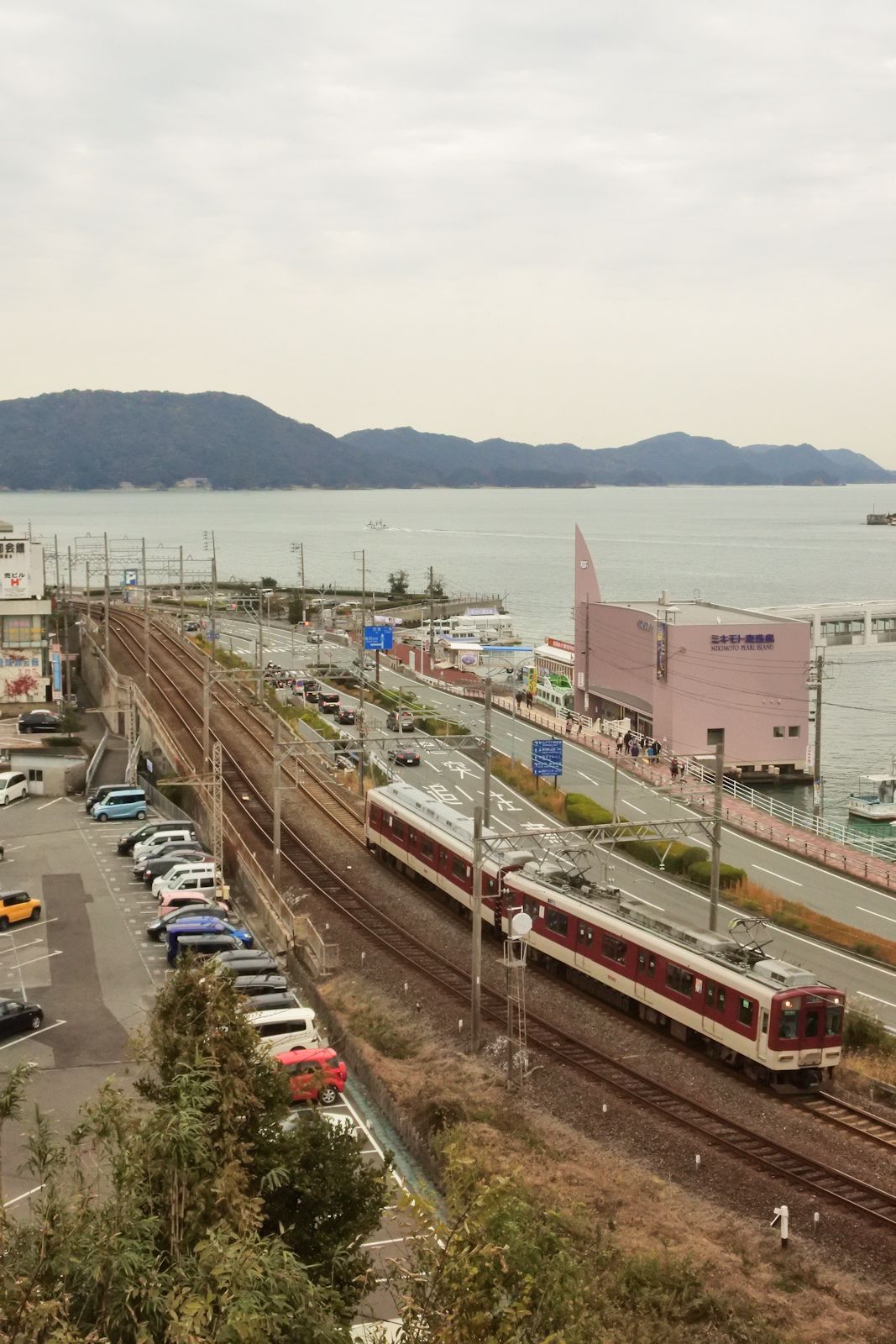
近鉄電車と伊勢志摩の海
志摩線の線路沿い、鳥羽駅と中之郷駅のほぼ中間に位置する城山公園で、伊勢湾を背景に近鉄電車を撮影。志摩線の普通列車と伊勢志摩方面への観光客輸送を目的に登場した特急型車両を中心に撮影した。I photographed Kintetsu Line trains, mainly those on local train and limited express trains, especially those designed for the trains toward Ise and Shima area, from Shiroyama Park located along the railway of Shima Line and at about middle between Toba Station and Nakanogo Station.9000系 普通列車 9000 Series Local train山田・鳥羽・志摩線の普通列車は2両編成のワンマン運転。写真の9000系のほか、1201系、1230系、1240系、1259系、1440系が運用に就いている。Local trains on Yamada, Toba, and Shima Line are operated by 2-car sets and conductorless. The car in the upper photograph is 9000 Series. 1201 Series, 1230 Series, 1240 Series, 1259 Series, and 1440 Series are also in service.30000系「ビスタEX」 30000 Series "Vista EX"2階建て車両が特徴の30000系「ビスタEX」は1978(昭和53)年に登場。1996(平成8)年から2000(平成12)年にかけて1度目の、2010(平成22)年から2012(平成24)年にかけて2度目のリニューアルが施され、1度目のリニューアルと同時に1度目の、2016(平成28)年より2度目の車体塗装変更が始まった。来る2018(平成30)年、30000系はデビュー40周年を迎える。リニューアルを繰り返しながら長年に渡って活躍し続け、今なおその人気は衰えていない。写真は2代目塗装の車両で、22000系「ACE」を連結した8両編成を組んでいる。30000 Series "Vista EX", coupling two double-deckers, has run since 1978 and has been popular.The car in the upper photograph is the second colour one coupled with 22000 Series "ACE".23000系「伊勢志摩ライナー」 23000 Series "Ise Shima Liner"サンシャインレッドとクリスタルホワイト、もしくはサンシャインイエローとクリスタルホワイトの塗装が色鮮やかな23000系「伊勢志摩ライナー」は、三重県磯部町(現在の志摩市)に近鉄グループの観光リゾート・志摩スペイン村の開業に合わせて、伊勢志摩方面への観光客輸送に特化した新型車両として1994(平成6)年に登場。海の青色と車体のサンシャインレッドもしくはサンシャインイエローが相対する寒色と暖色のコントラストを生み出している。23000 Series "Ise Shima Liner", coloured in bright sunshine red or sunshine yellow and crystal white, debuted in 1994 to carry passengers to visit "Shima Spain Village", a resort area consisting of an amusement park and a hotel in Isobe Town (present Shima City), Mie Prefecture, which opened in the same year.From my point of view, the colour of the sea and that of the car contrast well.50000系「しまかぜ」 50000 Series "Shimakaze"伊勢志摩への観光客減少を食い止めるための切り札として、最上位の接客設備を導入、ファインブルーとクリスタルホワイトの塗装が爽やかな印象の50000系「しまかぜ」。2013(平成25)年に登場して以来、その豪華さから高い人気を誇っている。2枚目は秋らしく海に加えて紅葉を入れて撮影。50000 Series "Shimakaze" is designed to put brakes on decrease in tourists to Ise Shima area with the highest quality of equipment, such as seatings, compartments, and food service. Since its debut in 2013, "Shimakaze" keeps popularity because of its quality of services. The colours of its body, fine blue and crystal white, looks smart and is associated with fresh air.The second photograph is shot with autumn leaves as well as the sea to create a feeling of the season.
Nov 26, 2017
コメント(0)
-
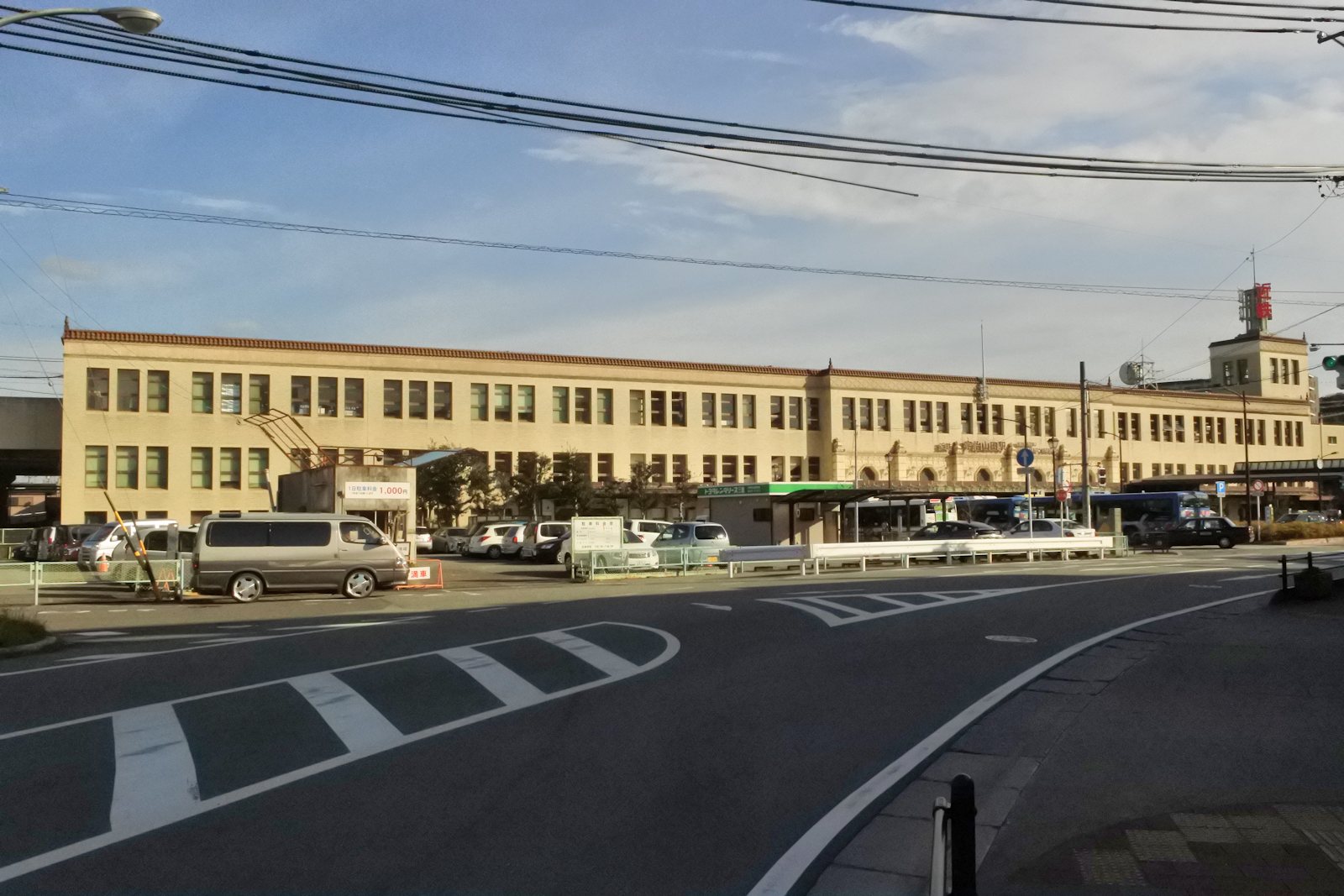
宇治山田駅駅舎を撮る
伊勢神宮内宮を参拝した後は、内宮前バス停から三重交通バスで宇治山田駅へ。宇治山田駅は近鉄山田線の前身、参宮急行電鉄の終着駅として1931(昭和6)年3月17日に開業した。参宮急行電鉄は1930(昭和5)年に、現在の近鉄大阪線の一部と山田線にあたる桜井駅~山田駅(現在の伊勢市駅)間を開業させたが、山田駅が当時の鉄道省参宮線との共用駅であったことと、伊勢神宮参拝客と宇治山田市(現在の伊勢市)市街地の将来の発展への配慮から、新たな終着駅として延伸された。淡いクリーム色のタイルが敷き詰められた外壁の駅舎は鉄筋コンクリート造りの3階建て(上写真向かって右の塔屋を入れると5階建て)で、鉄道省の初代建築課長を務めた久野節(くの・みさお)技師の手により設計された(久野技師の他の代表作としては南海電気鉄道南海本線難波駅駅舎、東武鉄道伊勢崎線(東武スカイツリーライン)浅草駅駅舎(浅草EKIMISE)などが挙げられる)。駅が立地する土地は、開業前年の1930(昭和5)年に第五十八回式年遷宮を記念して開催された御遷宮神都博覧会の跡地だった。塔屋はかつて、1936(昭和11)年から1968(昭和43)年の間、消防組常備部の火の見やぐらとして使われていた。火の見やぐらとしての機能は失ったが、駅舎のシンボルとしては昔から変わらない。出入口上部には八角形の明かり窓が配置されている。その明かり窓は華麗なテラコッタと呼ばれる建築装飾用の焼き物で彩られたもので、壺飾りや柱型などの装飾と組み合わせられている。窓下の軒周りはスペイン瓦があしらわれている。1階にはコンコースと駅ナカショッピングモールの「Time's Place うじやまだ」が、2階には改札口と待合室、皇室の方々や各界要人が使用される貴賓室が配置されている。開業当初からホームは3階の高架線上に設けられている。2001(平成13)年に、宇治山田駅駅舎は国の登録有形文化財に指定された。その美しさから、僕も伊勢志摩を訪れた際には、この宇治山田駅駅舎をぜひとも見てみたかった。あまり多く写真は撮れなかったが、その美しさを間近に見ると、参宮急行電鉄時代からのお伊勢参りに来た人々を出迎えてくれる、彼らの心に残る建築であると感じた。After dedicating Ise Grand Shrine, I went to Uji-yamada Station, border station between Kintetsu Yamada Line and Toba Line, by Mie Kotsu Bus.Uji-yamada Station opened on March 17th, 1937, as the terminal of Sangu Kyuko Railway Line, the predecessor of a part of Kintetsu Osaka Line and Yamada Line. In advance of the open of the station, Sangu Kyuko Railway Line had started its business between Sakurai Station, Nara Prefecture, and Yamada (present Iseshi) Station in 1930, but in the following year, it had been extended because Yamada Station had shared with Sangu Line and The railway company had forecast to come more people to shrine and to make the city centre around the station evolved.The ferroconcrete station building whose entire outward wall is tiled and cream-coloured is three-storied (partly five-storied) and designed by Misao Kuno, who had been a first construction department chief of Railway Ministry of Japan and also designed Namba Station building on Nankai Electric Railway Nankai Main Line and Asakusa Station building on Tobu Railway Isesaki Line (Tobu Skytree Line). The land the station is located where a special event having been held with relocation of shrine building in Ise Grand Shrine called "Gosengu Shinto (Capital of Deities) Exhibition" had been held in 1930.The taller part used to be used as fire watch-tower between 1936 and 1968, but it still be the symbol of the building.Above its entrance, octagon-shaped glasses, around which are decorated by prominent wall and vase made by architectural terra cotta, are laid out and the marquise is done by Spanish tiles.On the grand/first floor, concourse and shops (Time's Place Uji-yamada), and on the first floor/second floor, gates, waiting room, and VIP lounge are laid out. The platforms are located on the second/third floor since its opening.In 2001, the station building had been designated as a National Cultural Asset.Before coming there, I would like to see the station building because of its beautifulness. Though I couldn't get many photographs, I felt it had welcomed many people and might have dwelt in their mind. It was also impressive for me while watching from outside and being in it.参考文献・資料 Reference「知れば知るほど面白い 近畿日本鉄道」 辻良樹 洋泉社「近鉄電車 大軌デボ1形から「しまかぜ」「青の交響曲」まで100年余りの電車のすべて」 三好好三 JTBキャンブックス伊勢市立伊勢図書館 図書館だより「ふるさとの風」 2015年1月号 「―神都伊勢の表玄関― 近鉄宇治山田駅」伊勢志摩における観光開発の展開と経済的効果
Nov 25, 2017
コメント(0)
-
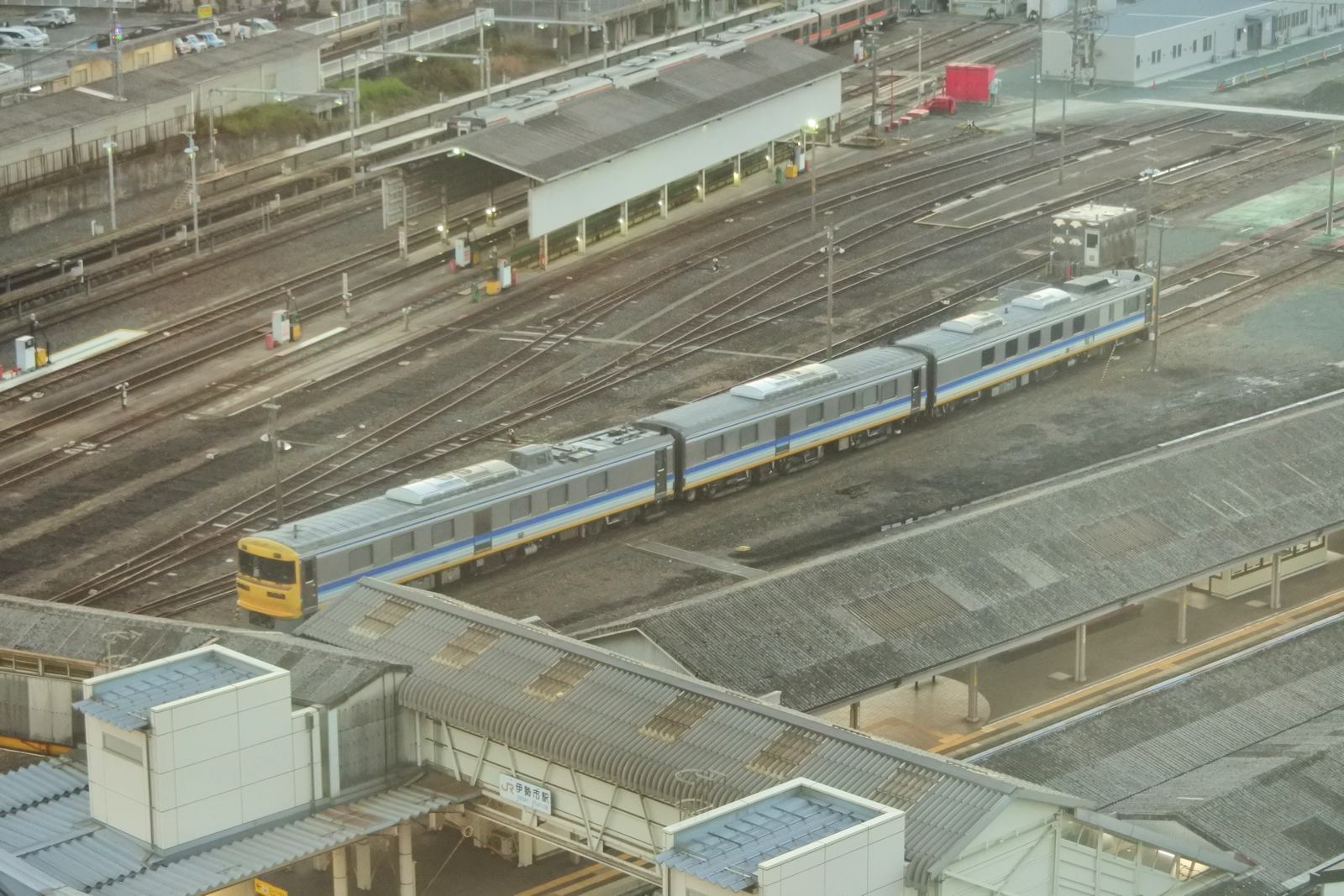
ホテルの窓から「ドクター東海」
24日の夜は伊勢市駅前の三交イン伊勢市駅前に泊まった。25日朝、部屋の窓から伊勢市駅の方向を見ると、なんとJR東海参宮線の線路(側線)にキヤ95系気動車「ドクター東海」が停まっているのが見えた。僕がキヤ95系の姿を目撃するのは、2017(平成29)年8月にJR東海御殿場線沼津駅で見て以来2回目である。2017(平成29)年内に再び見ることができるとは思ってもいなかった。今回もまた僕はダイヤを知らず、偶然出会えた。前回沼津駅で会った時は、ホームに停車中で編成全体を写真に収めることができなかったが、上から俯瞰するという思わぬ構図で編成全体を収めた1枚を撮影することができた。この日は参宮線を検測した日だったのだろうか。この後キヤ95系は、参宮線を多気駅方面へ向かったと思われる。On the night of November 24th, I stayed at Sanko Inn Iseshi-ekimae, which is located near Iseshi Station, and saw JR Central Kiya 95 Series stopping at a side track of Iseshi Station on the morning of 25th.It was second time for me to see the rail car and the last time had been at Numazu Station on Gotemba Line on August, 2017. I didn't expect that I could see it again and it coming there.Last time, I couldn't photograph the whole set because of shooting from a platform the train stopping. I could do from above.On that day, it could be under inspection on Sangu Line and the car would probably went toward Taki Station.三交イン伊勢市駅前〜四季乃湯〜
Nov 25, 2017
コメント(0)
-
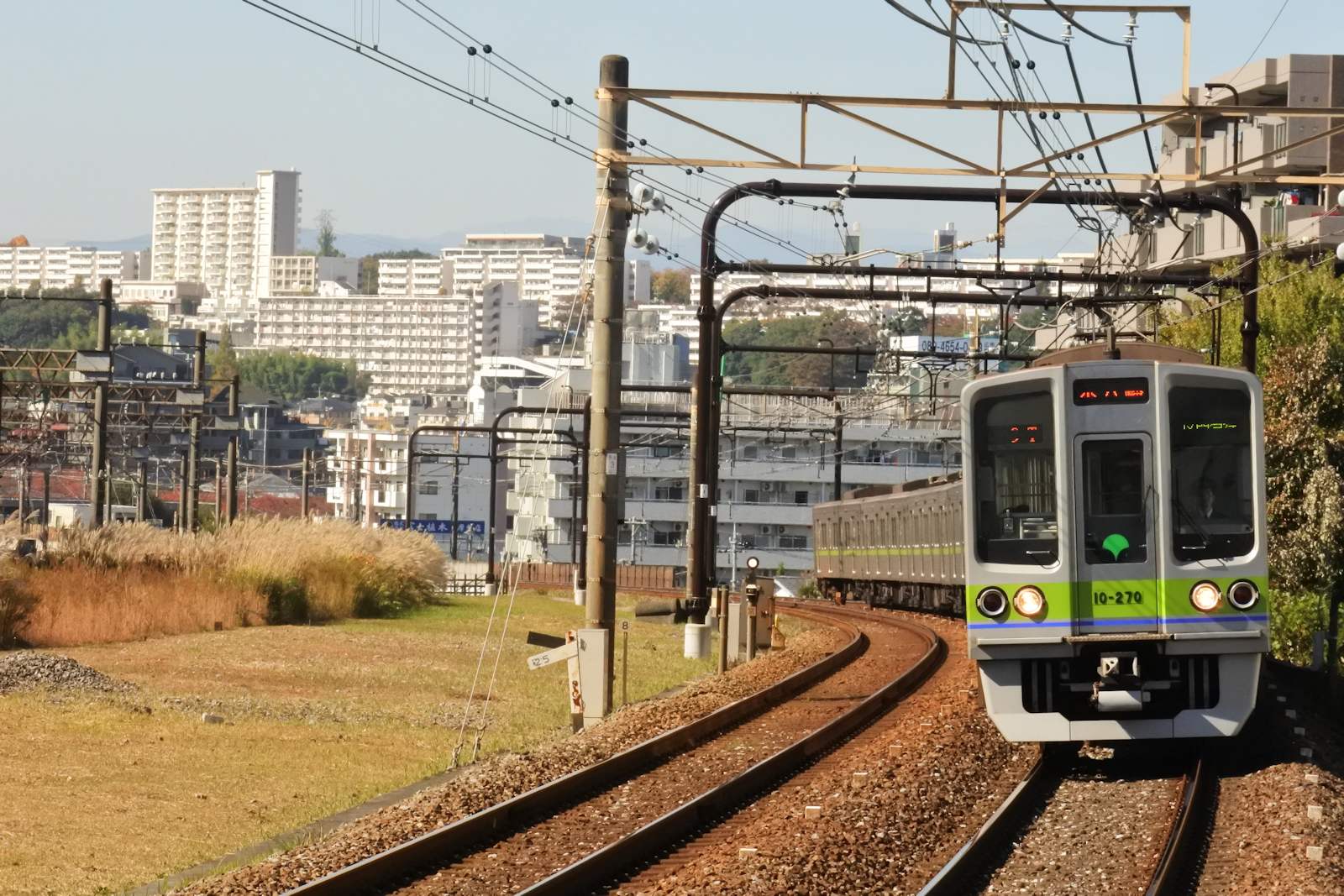
東京都交通局10-000形ラストチャンス
京王5000系と共に引退間近の東京都交通局10-000形電車を撮影。10-000形は都営新宿線用の車両。1971(昭和46)年に試作車が登場し、1978(昭和53)年より量産が開始された。1997(平成9)年までの間、8次に渡って増備を重ね、製造時期によって内外装や車体の構造に様々なバリエーションがあることが特徴。2005(平成17)年より新型車両である10-300形の投入による置き換えおよび10両編成化による廃車が始まり、2017(平成29)年11月時点では10-270Fと10-280Fの2本のみが在籍している。最後まで残った10-270Fと10-280Fは1997(平成9)年に当時のアルナ工機(現在のアルナ車両)で製造された10-000形の8次車にあたる。この年の都営新宿線での急行列車の運行開始に伴って増備された。それまでに登場していた編成からは、同じ10-000形を名乗るものの内外装がフルモデルチェンジされ、外観では同時期に同じアルナ工機でも製造された東武30000系電車に似たデザインの前面とビードプレス加工が施された側面が特徴(東京都交通局の車両で側面にビードプレス加工が施されたステンレス製車両は、後にも先にもこの10-000形8次車だけ)。帯は都営新宿線のラインカラーである黄緑色(リーフグリーン色)に加えて、前面と側面乗務員室扉周りには紺色の細い帯を巻く。内装では7次車(1992(平成4)年近畿車輛製)に続いて白色の化粧板を基調としているが、側扉鴨居に取り付けられたLED式案内表示が都営三田線用の6300形電車と同様の2段表示となっている。2008(平成20)年に名鉄5000系電車が登場するまでは、同時期に製造された京都市交通局10系電車の6次車(1118F~1120F編成)と共に、最後に製造されたチョッパ制御(10-000形と10系は電機子チョッパ制御、5000系は界磁チョッパ制御)の電車となった。当時の電車はすでにVVVF制御が主流になっていたが、都営新宿線ではVVVF制御の車両を走らせると当時のATCが誘導障害を起こしてしまったことから、これまでと同様の電機子チョッパ制御の車両が導入された(2005(平成17)年に都営新宿線のATCが更新され、VVVF制御の車両でも誘導障害が起こらなくなったことから、10-300形や京王9000系電車の運行が可能になった)。多摩ニュータウンの団地を背景に京王相模原線を走る姿を京王永山駅にて撮影。At the same day as Keio 5000 Series photographed, I photographed Bereau of Tokyo Metropolitan Transportation 10-000 Series, which could be retired in a few months.10-000 Series was first manufactured in 1971 and its mass production started in 1978. 224 cars (twenty-eight 8-car sets) were totally built until 1997. The structure and the interior or exterior design differ depending on manufacturing period.Since 2005, newly-made 10-300 Series had replaced 10-000 Series and only the last two sets, 10-270F and 10-280F, are existing on November, 2017.The last two sets were manufactured as the eighth model and for start of express train service in 1997 by ALNA Koki (predecessor of ALNA Syaryo).Compared to the previous models, its exterior and interior design differ, such as front similar to Tobu Railway 30000 Series, which was also manufactured by ALNA Koki on the same time, and bead press on its side (among the rail cars belonging to Bureau of Tokyo Metropolitan Transportation, the two are only the ones having bead press on the side). The navy-blue-coloured line is added on its front as well as the light-green-coloured one. Its interior is based on white-coloured decorative panel the same as the seventh model (built by Kinki Sharyo in 1992), but its LED display above the doors is similar ones of 6300 Series on Mita Line, on which the both single-level and double-level indication of letters can be available.Until Meitetsu 5000 Series appeared in 2008, the two were the last-appeared chopper controlling rail car as well as the last three sets of Kyoto Municipal Transportation Bureau 10 Series (1118F - 1120F sets). On that time, the variable-frequency drive (VFD) already predominates among electric rail car, but because automatic train control (ATC) device on Toei Shinjuku Line occured inductive interference to VFD rail cars, those on Toei Shinjuku Line were kept equipping chopper drive device (in 2005 the ATC device were upgraded, which doesn't occur the interference and is available to 10-300 Series and Keio 9000 Series).The photograph was shot at Keio-nagayama Station on Keio Sagamihara Line against the flats in Tama New Town area, south-west of Tokyo.
Nov 3, 2017
コメント(0)
-
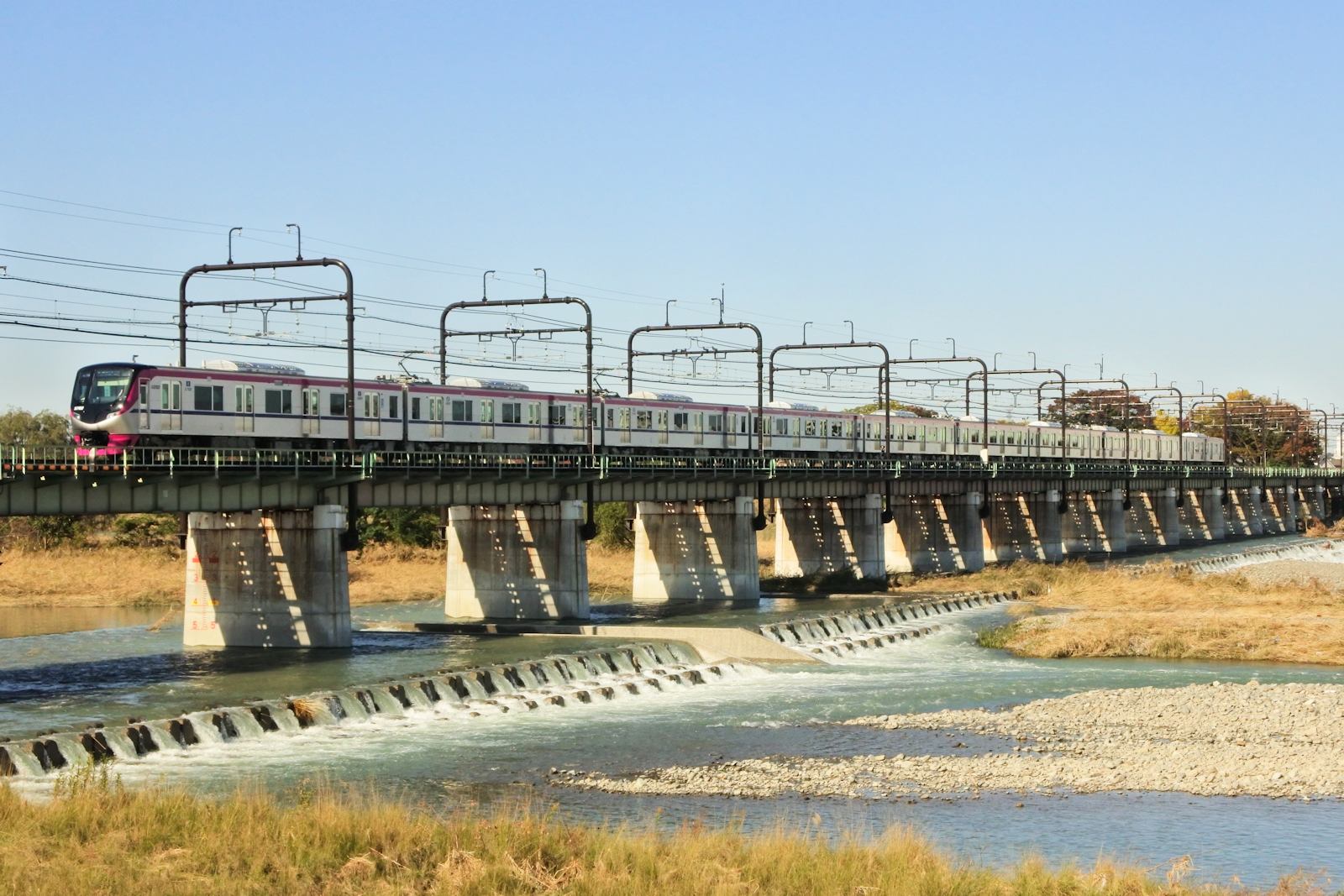
京王5000系 初撮影
3日、京王5000系電車を撮りに行った。5000系は2018(平成30)年3月に予定されている、京王線系統各線で運行開始される京王電鉄初の有料座席指定列車用の車両として登場した。それに先立つ9月29日に料金不要列車として営業運転を開始し、主に京王線・高尾線で運行されている。総合車両製作所製で、同社の新型ステンレス車両「sustina」の技術を採用している。有料列車と料金不要列車の両方として運行できる車両であり、東武50090系電車や西武40000系電車と同様のロング/クロス転換シート(デュアルシート)を備えている。前面は、強化プラスチック(FRP)製の傾斜のある立体的なデザインとなり、京王電車で初めての流線形となった。また京王線系統の車両では初めて非常用貫通扉が中央ではなく正面向かって左側に配置されている。さらなる消費電力削減を狙って、5号車(新宿方から数えて6両目)に連結されているデハ5050形5180番台は、ブレーキ時に発生した回生電力を貯めておくリチウムイオン蓄電池を床下に備えている。蓄電池の電力は発進加速時の動力源とするほか、停電時には蓄電池の電力のみでの自走も可能である。中河原駅~聖蹟桜ヶ丘駅間の多摩川橋梁を渡る八幡山駅~上北沢駅間にてこれまでの京王電車には見られない黒色に塗られた曲線美を持つ前面が目を惹き、ロング/クロス転換シートの有料座席指定列車にも運用される点とも併せて、京王線の新時代の幕開けを感じさせる車両と言えよう。On 3rd, I photographed Keio 5000 Series, the latest model on Keio Line, first time.5000 Series is built for a new reserved-seat train service from 2018. It started its regular operation as non-reserved train mainly on Keio Line and Takao Line from September 29th. It is manufactured by Japan Transport Engineering Company (J-TREC) with new "sustina" method of rail car manufacturing made from stainless steel using laser weldment. It is designed as a car to be available to both reserved-seat train and additional-charge-free train and equipped rotating seatings that can be arranged both longitudinal and forward-facing transverse like Tobu 50090 Series and Seibu 40000 Series.Its front is made from reinforced plastic having a slanted and rounded design and the emergency exit door on its front is laid out on its left, both of which it is first time to introduce among Keio Corporation's rail cars.To reduce more electric consumption, the lithium-ion batteries are equipped under the floor of the fifth car from Shinjuku (Deha 5050 from 5181). The batteries charge itself from regenerated electricity while the train set braking and supply the power for motor while the train set accelerating and while electric supply from overhead wire stops.Because of its design which is different from Keio Corporation's rail cars, such as black-coloured and slanted front and rotating seatings, I would like to say that 5000 Series looks appropriate to new age.
Nov 3, 2017
コメント(0)
-

いすみ鉄道の「キハカレー」を食べる
先日の日比谷公園での「鉄道フェスティバル」で買ったお土産の1つ、いすみ鉄道の「キハカレー」を食べてみた。いすみ鉄道が販売しているカレーということから、以前から食べてみたかった。ポーク・ビーフ・チキンの3種類があり、僕はチキンを選んだ。箱には「昭和に食べた懐かしい黄色いカレー」と書かれており、箱にも写真が使われているいすみ鉄道がJR各社から購入し、営業運転もしくは保存している国鉄型気動車(チキンはキハ30系)が多数活躍していた時代を思い起こさせるような味のカレーであるように想像させる。実際に食べてみると、―辛すぎず甘すぎずちょうどよい辛さのカレー、しっとりとしたジャガイモ、非常に柔らかく煮えているニンジン、柔らかさの中にかすかな歯ごたえが残る鶏肉―、具材によって煮え具合がバラバラなアンバランスさが感じられたものの、全体的には昔ながらの味がするカレーといった印象で、すごく美味しいというわけではないが、また食べたくなるような飽きの来ないカレーだった。食べている間、僕はいすみ線のキハ28形の「レストラン・キハ」に乗っているかのような気持ちを覚えた。僕には「懐かしい」時代ではないが、昭和40~50年代頃の味を感じられたような錯覚がした。I ate a dish of curry rice, with "Kiha Curry", a Japanese curry sauce made and sold by Isumi Railway, which I bought at "Railway Festival" on 8th.The curry sauce has three varieties of meats, pork, beef, and chicken. This time that I chose was chicken one. The package says that a curry sauce which had been loved by Japanese people in Showa period (from 1926 to 1989) and reminding persons something nostalgic, and a photograph of a diesel rail car which is in service on or preserved by Isumi Railway moved from JR East or JR West (Kiha 30 Series from JR East is on chicken version). I felt that the taste of each ingredient of the sauce varies; hotness and spiciness just right for people of all generations, moist potato, very-softly stewed carrot, and chicken with light crunchy texture. However, overall, it could be a ordinary curry sauce and tasted good, but not very delicious. I would like to eat it one more time.While eating, I also felt as if I was travelling with "Restaurant Kiha", a special train on Isumi Line.
Oct 18, 2017
コメント(0)
-

東急池上線 再発見の旅
9日、東急池上線の全線開通90周年(正確には大崎広小路駅までの開通から90周年。五反田駅までの開通は1928(昭和3)年6月17日)を記念して、同線が無料で1日乗り放題となる「フリー乗車デー」が開催された。このフリー乗車デーが開催されたいきさつは、前述の開業90周年を記念してのものに加えて、東急電鉄の自社調査で池上線の知名度が東横線や田園都市線と比べて低かった(東横線75.7%、田園都市線74.0%、池上線54.3%(出所:乗りものニュース))結果だったことから、同線の知名度向上に向けて多くの人々に乗ってもらうことだそうだ。五反田駅の山手線のホームから池上線の改札口・ホームへと向かう階段を上がる前にはもう1日乗車券を配布する東急電鉄の駅員さんの姿があり、僕もそこで1日乗車券を貰った。4階にある池上線のホームへ行ってみると、7000系の蒲田行き列車が発車しようとしていた。ホームに発車ベルが鳴り響き列車の乗務員さんが側扉を閉めようとするのだが、乗り切れずに閉まる扉に挟まれてしまう乗客がおり、駅員さんが“押し屋”をしているほどの活況を呈していた。僕はその次の列車(1本前のものに続いて7000系で運行)に乗った。この列車もすぐに満員となり、休日の昼間にもかかわらず、さながら平日朝夕の通勤時間帯のような状況となった。この時点で既に、駅の発車案内に列車の発車時刻が表示されなくなるほどの遅れが発生していた。最初に降りた駅は洗足池駅。改札を抜けると、中原街道を挟んで向かいに位置する洗足池公園にも多くの人の姿があり、ボート乗り場の屋上には十数人ほどの駅舎方向にカメラを構えた人も見られた。この日の活況を列車と共に写真に収めようとしていた撮り鉄であろう。僕個人としては、洗足池駅は何度も降りたことがある馴染みの駅であるが、今まで行ったことがないお店である駅を出てすぐの中原街道に面した和菓子店「掌甘堂洗足池店」へ。フリー乗車デーに合わせて、池上線沿線のスイーツ店でもイベントが開催されており、十数人が並んでいた。僕はどら焼き「和どら」を購入した。洗足池駅から続く商店街と池上線列車(車両は1000系1017F) Ikegami Line train (1000 Series 1017F set) running in Senzoku-ike shopping street洗足池駅ホームから五反田方を臨む 7000系の五反田行き列車を入れて Ikegami Line train (7000 Series) from Senzoku-ike Station洗足池駅から列車に乗り、蒲田駅へと向かう。この列車も大変な混雑だった。当然この列車も遅れていたのだが、遅れがさらに広がってしまうトラブルが発生した。雪が谷大塚駅発車直後、ホームセンサーが作動し非常停止してしまったのだ。列車は安全確認をしたのち、数分後に運転再開。その後はホームセンサーの作動や混雑による扉の再開閉もなく、蒲田駅まで順調に列車は進んだ。12日に池上本門寺の御会式が予定されていたことから、蒲田駅のホーム車止め部分に、同祭典で使用される万灯(まんどう)が飾られていた。池上線は1922(大正11)年に池上電気鉄道として、池上本門寺への参拝客を運ぶために蒲田駅~池上駅間で営業運転を開始したのが起源である。開業の目的となった本門寺最大の祭りを象徴する万灯を発車する列車を共に入れて。蒲田駅近くの商店街にあるお店で昼食を摂った後、五反田行きの列車で池上駅へと向かい、池上本門寺を参拝した。本門寺はこれまでにも数度参拝したことがあったが、今まで行ったことがなかった日蓮上人御廟所と多宝塔を見学し、境内にある売店で精進アイスを買って食べた。最後に池上駅から乗った五反田行き列車は1000系1017Fだった。同編成が「きになる電車」にリニューアルされてからは初めての乗車となる。1000系1017F「きになる電車」発車時刻が表示されないほどの遅延が起きてしまった今回の無料で乗り降り自由というかつてない大胆な試みに驚きを覚えたと共に、池上線と沿線の街の魅力に気づいてくれる人が現れることを祈る。I travelled with Tokyu Ikegami Line on October 9th, when passengers having a special ticket could allow fare-free unlimited ride on Ikegami Line train.This special fare-free ride day was held to mark 90th anniversary of Ikegami Line opening almost all of the present line and to aim to let more people know where Ikegami Line runs to reflect the result that only 54.3% persons whom Tokyu researched knew (according to an article from "Norimono News").The ticket was handed out by station staffs and I got it near the stairway between the platform of Yamanote Line and that of Ikegami Line.Coming to the Ikegami Line's platform, I saw that a train was ready to depart, but doors of it couldn't close because of the congestion. A station staff pushed them, which looked like the scene of morning rush hour.First, I got on the next train of that, but it also got crowded. At that time, the train delayed over and information display equipped on platform didn't show the time when the train departed. The station I first got off was Senzoku-ike. Going out of the gate, I saw many people in Senzoku Pond and about ten photographers on the roof of the boat house who might shoot the train and the bustle around the station. Though I have come Senzoku-ike Station many times, I wanted to go a Japanese confectionery "Shokando", to which I haven't been and one of the confectioneries being held a event for the fare-free ride day. I bought some dorayaki, a confection consisting of pancakes sandwiching sweet bean paste.I got on the train again to go to Kamata. It already be crowded and behind schedule. a trouble delaying the train more happened; the train suddenly stopped because obstacle sensors at platform edge worked soon after departing from Yukigaya-otsuka Station. After that trouble, the train had no trouble such as emergency brake caused by obstacle sensor reaction and doors reopening until it came to Kamata Station, the terminal of Ikegami Line.At the end of Kamata Station, a mando decorated paper lantern, which parades on the day of oeshiki festival at Ikegami Honmonji Temple, was laid out.Ikegami Line originally started as the railway line connecting between Kamata Station and Ikegami Station to carry people who would visit the temple in 1911. I photographed the mando and a departing train.After eating lunch, I got on a train to Ikegami Station to visit the temple. Though I have visited there several times, this time I would like to go where I haven't seen, such as a reliquary shrine of Buddhist monk Nichiren and a two-storied pagoda. While walking in the temple, I ate a sesame-flavoured ice cream.The last train I rode on from Ikegami Station to Gotanda Station was 1000 Series 1017F set, which had been refurbished as the woodtone decorative panel and wooden hanging strap.I wish the fare-free ride day take the opportunity afforded by more people to feel an attraction of Ikegami Line and the cities along the line
Oct 9, 2017
コメント(0)
-

日比谷公園レポート 2017
8日、毎年恒例の日比谷公園で開催された「鉄道フェスティバル」に参加してきた。日比谷駅の階段を上がって最初に向かったのは、民鉄各社の物販ブース。例年の通り、僕が真っ先に並んだのは東急電鉄のブース。僕は毎年「東急電車カレンダー」をここで買っているのだが、今回は会場での「東急電車カレンダー」の販売がないため、東急電鉄のゆるキャラ、のるるんのトコトコぬいぐるみを購入した。民鉄物販ブースを物色していると、その中で最も日比谷通り寄りの京阪電車のブースでは、2017(平成29)年8月より営業運転を開始した京阪8000系のプレミアムカーのシートが展示され、実際に座れるということで、僕も体感した。その後、上田電鉄、アルピコ交通、京都市交通局の各鉄道事業者のグッズを購入。続いて僕の目に留まったのが、メガネ店「JINS」のブース。そこには、JINSが総合車両製作所とタイアップして、JR東日本E235系の製造過程で切り落とされたステンレス端材を使って製造したメガネフレームが試着できる状態で展示されていた。もちろん僕も試着してみた。続いてはJINSブースのすぐ隣のキヤノンブースへ。デジタル一眼レフカメラ「EOS」とレンズを数種類展示しており、最新モデルを触り、数枚試し撮りをして、使いやすさを調査した。中でも印象的だったのは、フルタイムマニュアルフォーカス(オートフォーカスでピントを合わせた後でもピント調整しなおせる機能)に対応したレンズ(展示されていたものは「EF17-40mm F4L USM」)。今まで体感したことがない写真の撮り方に驚きを覚えた。最後に見たのはJR東海ブース。そこにはリニア中央新幹線の車両、L0系のおもちゃ「リニアライナー」が展示されていた。実車と同様の磁力による浮上・推進を実現したもので、おもちゃとは思えないほどの高速走行する姿が魅力である。高速で専用のレールを駆け抜ける「リニアライナー」を流し撮りしてみた。On 8th, I saw the annual Railway Festival in Hibiya Park.Going up a stairway of Hibiya Station, Where I first came and made a line was stalls of private railways, especially Tokyu Corporation. Every time I go to the event, I bought a calendar of Tokyu, but it wasn't sold this year. Instead of that, I got aplush doll with pull-back function of "Norurun", mascot of Tokyu.Walking around the stalls, I found a isolated "Premium Car" class seating of Keihan 8000 Series which started to be in service on August, 2017. I tried the seating before the ones equipped in the car.Purchasing something at the stalls of Ueda Electric Railway, Alpico Kotsu, and Kyoto Municipal Transportation Bureau, I tried glasses whose frame was made from stainless steel scrap which was cut off while manufacturing JR East E235 Series at JINS glasses store's tent.Next, I went to Canon pavilion next to the JINS tent, where some cameras were exhibited. I tried to shoot some photographs with those cameras and felt surprise at shooting using a interchangeable lens with full-time manual focusing function.Where I last saw was JR Central's tent, where a toy of L0 Series maglev train, which moves and floats magnetically and runs at high speed, the same as the real cars. I shot some pictures of the moving toy train at high speed.
Oct 8, 2017
コメント(0)
-

東急5000系5122F 写真追加
1日、9月23日に撮影した東急5000系5122Fを再び撮影。今回の撮影場所は西武池袋線石神井公園駅。この日は023運用に就き、石神井公園駅に姿を見せるのは1度きり(023092(→B923K→6603)列車 元町・中華街駅発各停石神井公園行きと(6604→A1123K→)023121列車 石神井公園駅発各停元町・中華街行き)だったことから、023092列車が石神井公園駅に到着する11:09に合わせて、僕は石神井公園駅の3・4番線ホームにカメラを構えた。石神井公園駅に入線する5122F 5122F set approaching Shakujii-koen Station折り返しの023121列車が発車する11:23までの間、引き上げ線に停車中の5122Fを撮影。西武6000系6153Fと共に 5122F set waiting for returning to Motomachi-chukagai Station and Seibu 6000 Series 6153F set西武4000系4009F「西武 旅するレストラン 52席の至福」と共に 5122F and Seibu 4000 Series 4009F "Fifty-two Seats of Happiness"奥に見える2棟の高層ビルは大泉学園ゆめりあタワー(左)とリズモ大泉学園(右) against the two high-rise flats "Oizumi-gakuen Yumeria Tower" and "LIZMO Oizumi-gakuen"クハ5122号車 Kuha 5122, front car toward Shibuya, Wakoshi, Hanno, and Shinrin-koen [Musashi Kyuryo National Government Park]東横線丸子多摩川駅(現在の多摩川駅)~渋谷駅間開業90周年を記念したヘッドマーク front sign for 90th anniversary of Toyoko Line connecting Shibuya and Yokohama初代5000系を模した形式・定員・自重(重さ)の表記 type, capacity, and weight written on the bottom of the bodyOn 1st, I photographed Tokyu 5000 Series 5122F set again, following on September 23rd. Where I did was Shakujii-koen [Shakujii Park] Station on Seibu Ikebukuro Line. On that day, 5122F set was in service as 023 operations, which came toward Seibu Ikebukuro Line only once and it approached Shakujii-koen [Shakujii Park] Station at 11:09 AM.While the set waiting for returning toward Tokyu Toyoko Line until 11:23, I photographed it stopping at side track and other cars passing the main line.
Oct 1, 2017
コメント(0)
-

「ラブライブ! サンシャイン!!」ラッピングの西武10000系を撮る
9月30日、西武10000系「ラブライブ! サンシャイン!!」ラッピング車両による西武球場前行き臨時列車を撮影。この臨時列車は、同作品の主題歌・挿入歌とメインキャラクター9人の声を担当する声優ユニット「Aqours」のライブが西武ドームで9月29日・30日に開催されたのに合わせて運行されたもので、両日とも池袋駅~西武球場前駅間で2本運行された。ラッピングを纏った車両は10109Fで、キャラクターのイラストは同作品のラッピング車両として既に運行されている伊豆箱根鉄道3000系3506Fと同じもので、同編成では1両あたり3人が描かれているが、編成両数が3506Fよりも長い10109Fでは1両あたり1人もしくは2人がラッピングされている。保谷駅~大泉学園駅間にて 池袋駅への送り込み回送列車 photographed between Hoya Station and Oizumi-gakuen Station when operating as a out-of-service train from rail yard石神井公園駅~大泉学園駅間にて photographed between Shakujii-koen Station and Oizumi-gakuen StationOn September 30th, I photographed a Seibu 10000 Series set, 10109F set, which had a livery of "Love Live! Sunshine!!" anime, whose illustrations of characters were the same as those of Izu Hakone Railway 3000 Series 3506F set.On that day, the set was in service as special trains for persons watching the live performance of nine-member voice actress group "Aqours", who sing music and each member of the group voices each nine main characters on the work held at Seibu Dome on September 29th and that day. The train also operated from Ikebukuro Station and Seibu-kyujo-mae [Seibu Dome] Station twice on both days.
Sep 30, 2017
コメント(0)
-
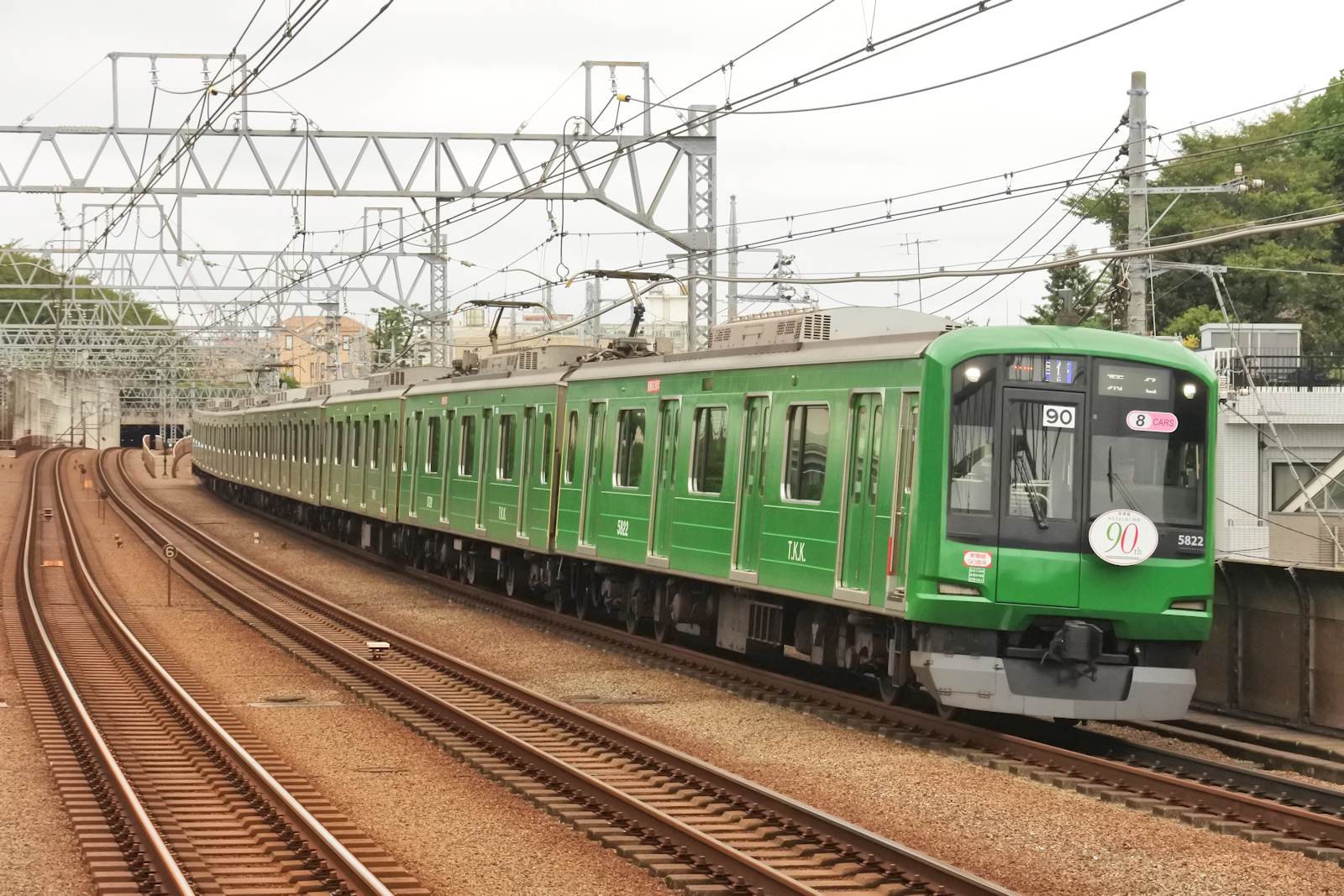
雨上がりの青ガエル
23日、9月4日より東横線開通90周年を記念して初代5000系「青ガエル」風のラッピングを纏った東急5000系5122Fを撮影しに行った。このイベントは2017(平成29)年に東横線の前身である東京横浜電鉄東横線の丸子多摩川駅(現在の多摩川駅)~渋谷駅間が延伸開業し、東京(渋谷駅)と横浜(神奈川駅 かつて反町駅~横浜駅間に所在 1950(昭和25)年廃駅)を結ぶ路線となって90周年を迎えることを記念して、東横線では1954(昭和29)年から1980(昭和55)年まで活躍し、全身を緑色に塗装した丸みを帯びた車体から「青ガエル」の愛称で親しまれた初代5000系をイメージしたラッピングを、東横線で活躍する2代目5000系5122Fの車体に纏ったもので、2018(平成30)年8月31日まで運行される予定となっている。5000系5122Fはもともとは田園都市線用に製造された車両であるが、新製後は田園都市線での営業運転には就くことなく、東横線へと転属し、5050系と同じさくら色と東急レッドの帯を巻いて、5050系と共通で運用されている。2013(平成25)年の東京メトロ副都心線との直通運転開始後も東横線で活躍し続けている。前面には初代5000系が急行列車として運行された時に取り付けられた「急行」と書かれたサボ(プレート)を模した「東横線90周年」と書かれたサボと、形式、自重(重さ)、定員がラッピングにプリントされている。側面にも肩部に「急行」のサボを模した「東横90周年」のサボと、窓下に初代5000系のものと同じ書体で車両番号と、「T.K.K.」(Tokyo Kyuko Dentetsu Kabushiki Kaisha(東京急行電鉄株式会社)の略)のロゴがプリントされている。この日は池袋駅~菊名駅間の各停列車として運行されていた。多摩川駅に入線する5122F 5122F set running near Tamagawa Station大倉山駅~綱島駅間の鶴見川橋梁を渡る5122F 5122F set crossing Tsurumi River between Okurayama Station and Tsunashima Station鶴見川橋梁を渡る5122Fのビデオ YouTube video of 5122F set crossing Tsurumi River窓下の車両番号 Car number under the side window「急行」サボ風の「東横90周年」表示 ラッピングにプリントされたもの 90th anniversary sign directly printed on the livery「東横90周年」表示と「T.K.K.」ロゴ 90th anniversary sign and T.K.K. letter新宿三丁目駅に停車中 初代5000系が活躍する前、東京横浜電鉄時代から東横線の「第三期線」として渋谷駅~新宿駅間が計画されるも実現せず(東横線新宿駅の予定地は京王電鉄京王線新宿駅(1・2・3番線 いわゆる「京王線新宿駅」に相当)に転用された)、長年の時を経て、東京メトロ副都心線への直通運転という形で新宿への乗り入れが実現した While stopping at Shinjuku-sanchome Station on Fukutoshin Line located in Shinjuku area, where Toyoko Line used to be planned to be extended from Shibuya in the old time, but the plan didn't realise by Tokyu Corporation itself,東横線で活躍する車両の中で、同じ「5000系」であり、主に各停列車と急行列車として運行されている(初代5000系の現役時代は東横線の列車種別は各停と急行しかなかった)ことから、5122Fが起用されたものとみられる。初代5000系は、渋谷駅ハチ公口前に展示されている車両として、僕自身も含めて現役時代を知らない世代の人たちにもおなじみの車両であろう。この他、熊本県熊本市の熊本電気鉄道北熊本駅構内で1両(両運転台(運転席が車両の両端にある)改造車)が動態保存、長野県松本市のアルピコ交通新村車両所内に2両が、長野県須坂市のトレインギャラリーNAGANOに赤色とクリーム色の長野電鉄塗装の車両2両がそれぞれ静態保存されている。On 23rd, I went photographing Tokyu Corporation 5000 Series 5122F set, whose body has a livery resembling that of old 5000 Series, which was nicknamed "green frog" because of its body colour and had been in service from 1954 to 1980 on Toyoko Line, to mark 90th anniversary of Toyoko Line forming the base of the present route between Tokyo (Shibuya Station) and Yokohama (Kanagawa Station, which was located between present Tanmachi Station and Yokohama Station and was closed in 1950) in 2017 since September 4th. Though 5000 Series 5122F set was originally manufactured as a set on Den-en-toshi Line and consisting of 10 cars, they were rearranged to 8-car set and moved to Toyoko Line. After going-through service to/from Tokyo Metro Fukutoshin Line started in 2013, the set keep being in service on Toyoko Line.On the livery, signs saying "Toyoko Line 90th anniversary", which look like the sign board on its front under the windows and on its side the same level as the display when old 5000 Series operated as the express train, car number, and T.K.K. (abbreviation for Tokyo Kyuko Dentetsu Kabushiki Kaisha (Japanese name of Tokyu Corporation)) are printed.On that day, the set was in service as local train between Ikebukuro Station on Fukutoshin Line and Kikuna Station.I see that 5122F set is chosen because of the same name and its use, mainly in service as local and express trains on Toyoko Line, the same as the old ones.Old 5000 Series also can be known among persons who don't see it in regular service because a car of old 5000 Series is laid in front of Shibuya Station.The other cars also preserved in Kumamoto (side track of Kita-kumamoto Station on Kumamoto Electric Railway Kami-kumamoto Line) and Nagano (Niimura railyard on Alpico Kotsu Kamikochi Line and Train Gallery Nagano in red and cream colour).The cars with the livery is in service until August 31st, 2018.参考:熊本電気鉄道の保存車両参考:アルピコ交通の保存車両参考:トレインギャラリーNAGANOの保存車両
Sep 23, 2017
コメント(0)
-
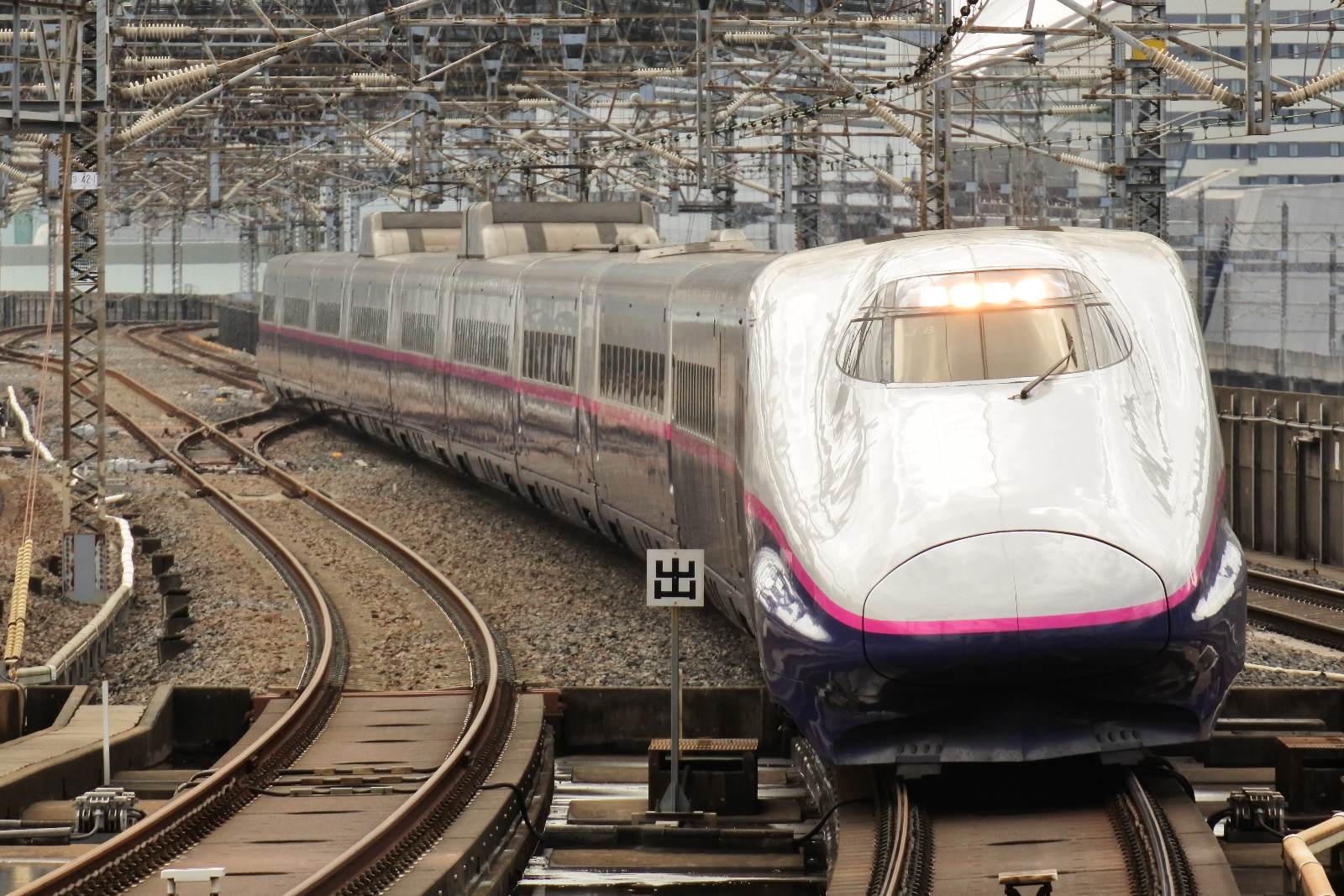
新青森行き「はやて」を撮る
2日、E2系の東京駅発新青森行きの「はやて357号」を大宮駅で撮影。北海道新幹線が開業した2016(平成28)年より、東京駅~盛岡駅間、もしくは盛岡駅・新青森駅~新函館北斗駅間を運行する列車としての色合いが強くなった「はやて」の運行開始当初と同じ東京駅~盛岡駅以北で運行する姿を撮影に成功した。「はやて」は2017(平成29)年現在、東京駅~盛岡駅間を運行する列車と仙台駅・盛岡駅~新函館北斗駅間を運行する列車があるが、2002(平成14)年の東北新幹線盛岡駅~八戸駅間の延伸開業と同時に東京駅~八戸駅間で運行を開始し、続く2010(平成22)年の八戸駅~新青森駅間の延伸開業後は東京駅~新青森駅間で運行されていた新幹線列車だった。2002(平成14)年から2016(平成28)年までの間の「はやて」の定義は「E2系またはE5系で運行されること」、「大宮駅~仙台駅間ノンストップであること」、「最高速度が275km/hであること」と言える。当初は「盛岡駅以北へ直通する(八戸行きもしくは新青森行きである)こと」も条件であると言えたが、後に盛岡行きの「はやて」が登場したことにより、条件から外された。2011(平成23)年にE5系が投入されてからは、同車による最高速度320km/hの「はやぶさ」が増発を重ね、「はやて」の運行本数が減っていった。定期運行されている「はやて」は、2002(平成14)年の運行開始時点で東京駅~八戸駅間で15往復、仙台駅~八戸駅間で1往復の計32本、2010(平成22)年の新青森駅開業時には東京駅~新青森駅間で15往復、東京駅~盛岡駅間で7往復、仙台駅~新青森駅間で1往復、盛岡駅~新青森駅間で1往復の計48本が運行されていたのが、2017(平成29)年現在東京駅~盛岡駅間2.5往復(盛岡行き3本・東京行き2本)、盛岡駅~新函館北斗駅間1往復、新青森駅~新函館北斗駅間1往復の計9本にまで減った。9月2日、臨時列車として東京駅発新青森行きの「はやて357号」がE2系により運行された。この日「はやて357号」に起用された車両は0番台のJ8編成。E2系のうち0番台J編成(通称「E2'(ダッシュ)系」)は1995(平成7)年から1999(平成11)年にかけて増備された、当時のE3系「こまち」と連結して運行された「やまびこ」用として製造された、E2系では最も経年を積んだグループ。当初は8両編成で新造され、東北新幹線「やまびこ」のほか、0番台N編成と共に北陸(長野)新幹線「あさま」としても運行された。2002(平成14)年の東北新幹線八戸駅延伸開業を前に、中間車2両を増結して、この時新造が始まった1000番台J編成と同様の10両編成となり、「はやて」「やまびこ」など東北新幹線のみでの運行となった。E2系0番台は新造から20年近く経つことと、高速化に向けてのE5系の投入により、廃車が進んでいる。このうち北陸新幹線「あさま」用のN編成は2016(平成28)年までにE7系に置き換えられて全車が引退。J編成にも引退・廃車となった編成が現れ、最大で15編成いたのが、2017(平成29)年9月現在、6編成60両にまで在籍数を減らした(1本はN編成に編入されたのち廃車)。E2系0番台が全廃になってしまうのも数年以内とみられるだろう。僕の目には、E2系J編成(0番台、1000番台とも)は東京駅~新青森駅間の「はやて」の運用に就いている姿が一番似合うと見える。「はやて」はE2系0番台J編成がデビュー当初に投入された、E3系「こまち」を連結した「やまびこ」を八戸駅まで延伸させる形で登場した列車であると言えるうえ、同1000番台は「はやて」として運用されることを想定して設計された車両だからである。On 2nd, I photographed E2 Series Shinkansen "Hayate" at Omiya Station.In 2017, "Hayate" regularly operates between Tokyo Station and Morioka Station, Iwate Prefecture, on Tohoku Shinkansen or between Morioka Station or Shin-aomori Station, Aomori Prefecture, and Shin-hakodate-hokuto Station, Hokkaido, on Tohoku and Hokkaido Shinkansen, but originally used to be in service between Tokyo Station and Hachinohe Station, Aomori Prefecture, or Shin-aomori Station on Tohoku Shinkansen.Before Hokkaido Shinkansen's opening, the Shinkansen trains which was operated by E2 Series or E5 Series, didn't stop any stations between Omiya Station, Saitama Prefecture and Sendai Station, Miyagi Prefecture, and ran at up to 275km/170.9mi per hour was named "Hayate". When "Hayate" started to run was in 2002, at the same time as Tohoku Shinkansen's extension to Hachinohe Station.However since E5 Series debuted in 2011, the more number of "Hayabusa", the train running at up to 320km/198.8mi per hour by E5 Series, operates, the less number of "Hayate" does. Specifically, in 2002, "Hayate" made 15 round trips between Tokyo Station and Hachinohe Station, and 1 round trip between Sendai Station and Hachinohe Station, and in 2010, when Shin-aomori Station opened, it made 15 round trips between Tokyo Station and Shin-aomori Station, 7 round trips between Tokyo Station and Morioka Station, 1 time round trip between Sendai Station and Shin-aomori Station, and 1 time round trip between Morioka Station and Shin-aomori Station. In 2017, it makes 3 trips from Tokyo Station to Morioka Station, 2 trips from Morioka Station to Tokyo Station, 1 round trip between Morioka Station and Shin-hakodate-hokuto Station, and 1 round trip between Shin-aomori Station and Shin-hakodate-hokuto Station.On that day, an on-season train between Tokyo Station and Shin-aomori Station operated by 10-car E2 Series J8 set, one of the oldest group of E2-0 (J1 - J15 set) Series constructed from 1995 to 1999 for "Yamabiko" combined with "Komachi" going toward Akita Shinkansen. When it debuted, the set consisted of 8 cars and also ran as "Asama" on Hokuriku Shinkansen, together with E2-0 (N1 - N13, N21 set), but in 2002, to prepare for the extension to Hachinohe Station, two more middle cars were constructed and coupled to create the same formation as E2-1000 Series (J51 - J75 set) whose manufacturing starting on that time and changed for only on Tohoku Shinkansen since then.Because of speeding up introducing E5 Series and aging, it has passed about or over twenty years since E2-0 Series (both J sets and N sets)' construction, all of N sets and part of J sets are already retired. In 2017, six 10-car sets of E2-0 Series (J sets) exists.From my point of view, it looks best to E2 Series (E2-0 J1 - J15, E2-1000 J51 - J75 sets) when it operates "Hayate" because it evolved from "Yamabiko" combined with "Komachi" and, especially E2-1000 Series, the car is constructed for the train.
Sep 2, 2017
コメント(0)
-

ドレミファインバーターを奏でる京急新1000形
京急本線金沢文庫駅で、シーメンス製VVVF制御装置(ドレミファインバーター)を搭載した京急新1000形アルミ車の1017Fと遭遇した。JR東日本E501系や京急2100形、京急新1000形の一部編成に搭載され、発進加速時に「♪ファソラシ♭ドレミ♭ファソー」という特徴的な音階を(E501系は停止寸前にも「♪ソファミ♭レドシ♭ラソファー」という加速時とは逆の下がり調子の音階も)奏でることで、鉄道ファンを楽しませてきたシーメンス製のGTOサイリスタVVVF制御装置、いわゆる「ドレミファインバーター」。一方で、海外製品であるため、故障時の部品取り寄せに時間がかかるという欠点があり、車両の新造から10年程度が経った車両から、順次日本メーカー製の制御装置への交換が進められてきている。2015(平成27)年までに、E501系と2100形の制御装置の交換が全車完了し、新1000形にも交換した車両が出現したことから、この「ドレミファインバーター」の磁励音も近いうちに聞けなくなる可能性が高い。At Kanazawa-bunko Station on Keikyu Main Line, I met Keikyu N1000 Series 1017F set, equipping variable-frequency controller sounding like musical scale (FGAB♭CDE♭FG) when the train soon after accelerating from resting condition made by SIEMENS.SIEMENS' variable-frequency controller used to be equipped by railway cars, such as JR East E501 Series (also sounding descending scale when just before stopping), Keikyu 2100 Series, and part of Keikyu 1000 Series, and make the travel on them enjoyable. However, because of the import products, it took much time to ship parts when the devices got out of order from Germany, the controllers are replaced by ones made in Japan.By 2015, All of them equipped by E501 Series and Keikyu 2100 Series were finished to replace, and those of Keikyu N1000 Series started to be.
Aug 13, 2017
コメント(0)
全1051件 (1051件中 151-200件目)



